The internet is teeming with sites vying for attention, and a poor first impression could very well be your last. It’s a fine line one walks when it comes to nailing that website design. Some get it right; many don’t. From the layout and navigation to the colors and fonts, everything has something to say about the brand behind the scenes.
Related: 8 best practices of high-converting websites
Some studies suggest that it only takes 50 milliseconds for a user to decide whether your website is appealing enough. With such a short amount of time, your website needs to wow them fast and leave a strong impression.
Let’s delve deeper into three areas—design, user experience and content—that can make an impact on your viewer, to give you insight into what your website says about your brand.
Driven by design
With dwindling attention spans and fast-changing loyalties, the design of your website plays a huge role in holding the attention of fast-moving visitors and encouraging interaction.
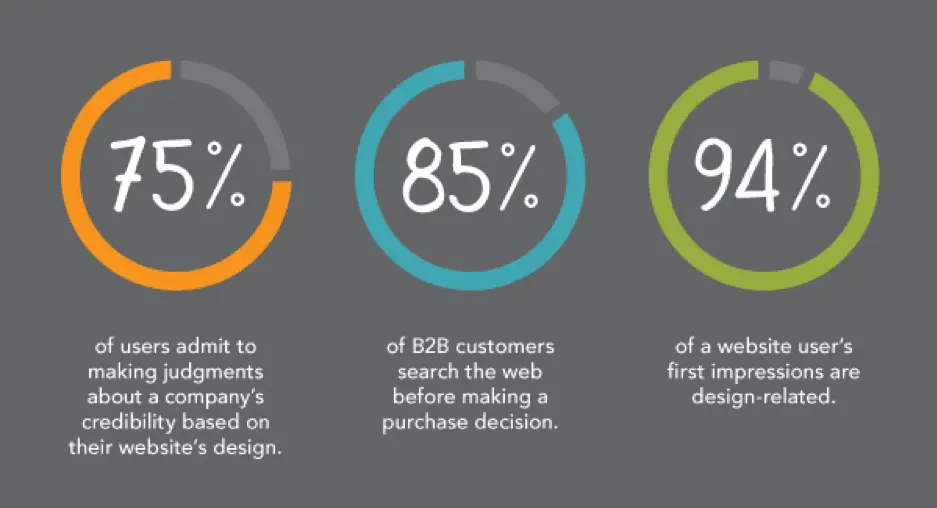
Source: Kinesis
Organizations spend top dollar to help their websites stand out amongst the noise. With special emphasis on digital marketing strategy, a great website design will help you grab your consumer’s attention.
Traits of a well-designed website
Visual appeal, but for the right audience
Looks matter.
In fact, 38% of users will stop browsing your website if they don’t find it attractive enough. So, a visually appealing website is half the job done. But remember—you are not trying to appeal to everybody.
Good design addresses the target audience with a brand personality users want to engage with. Check out this website, Crypton. It’s designed ideally for a tech-savvy audience.

Source: Crypton
Parallax scrolling heightens the user engagement here, but you don’t have to include parallax functionality on every website. Research your buyer personas and use design elements, functions and colors that make your target audience feel right at home.
Your above-the-fold section should do the job
A Nielsen study says the majority of your website visitors will spend 80% of their time above the fold. That’s the section you see without scrolling—call it the opening screen.
The best websites explain what they do in this opening screen. A general practice is to use a headline (think your company’s tagline or mission statement), followed with a brief subtitle text describing your services or products. Top it off with a CTA button to direct visitors toward the next stage in your conversion funnel.
Airbnb does this brilliantly; the headline is the CTA. While there’s no subtitle text, their call-to-action is strengthened by a slideshow of awesome travel photos. Just beneath the headline, a search bar is intuitively placed. The example text in the search bar encourages interaction.
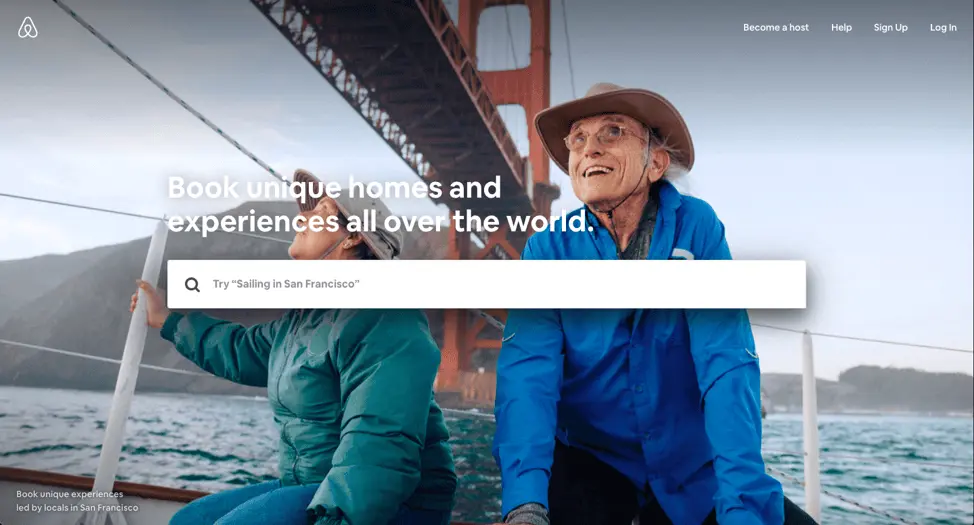
Source: Airbnb
Your design might be ineffective if:
- Your colors are wrong. For example, you’re targeting B2B consumers with a color theme that appeals more to B2C consumers.
* Your site has no visual hierarchy. This confuses the visitor, resulting in missed opportunities and eventual sales.
The design approach you take depends on many factors. Location, age brackets, and target groups will certainly affect how your website should look. Having said that, these factors should be the starting points for your design. A well-designed website that considers all these factors will set you apart from the crowd.
User experience counts
Today, it’s all about experiences. You could have a brilliant product or service, but if your website fails to deliver an enjoyable user experience, all that will be for nothing. It all comes down to how you make your customers feel.
The kind of experience users have, good or bad, will stay with them for a long time, even after the browser window is closed. A well-thought-out homepage or landing page with content that resonates will go a long way towards creating a great user experience.
Let’s see what your website’s UX has to say about you.
Good user experience:
- With good UX, your website tells the world that you think clearly about the end user. See Crunchbase’s website; its UI is done beautifully. There’s the search bar on top if you want to explore specific results, or you can click the menu on the left side to browse sections that interest you.
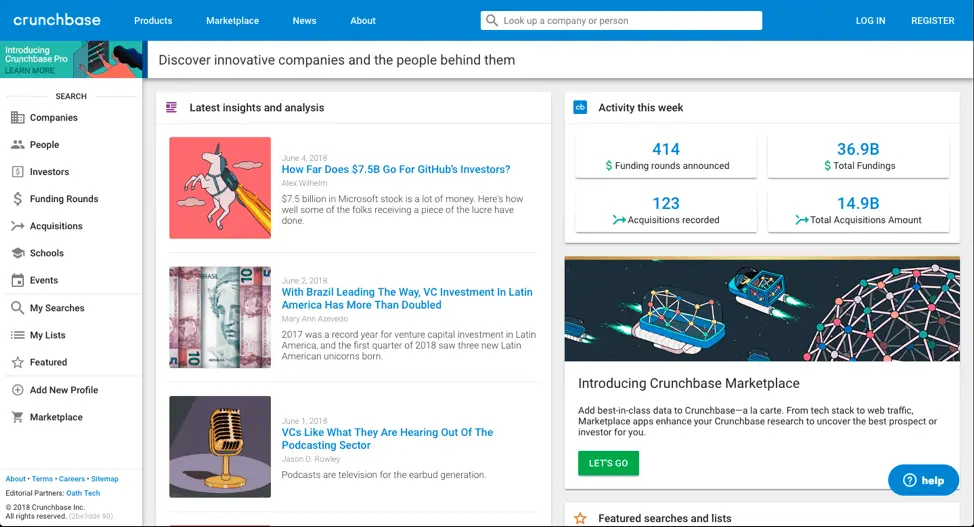
Source: Crunchbase
- Clean, intuitive user interface shows that you have a clear purpose.
* Got a 404 page built? Small things like this send out signals that you don’t skimp on your efforts to deliver an optimized experience.
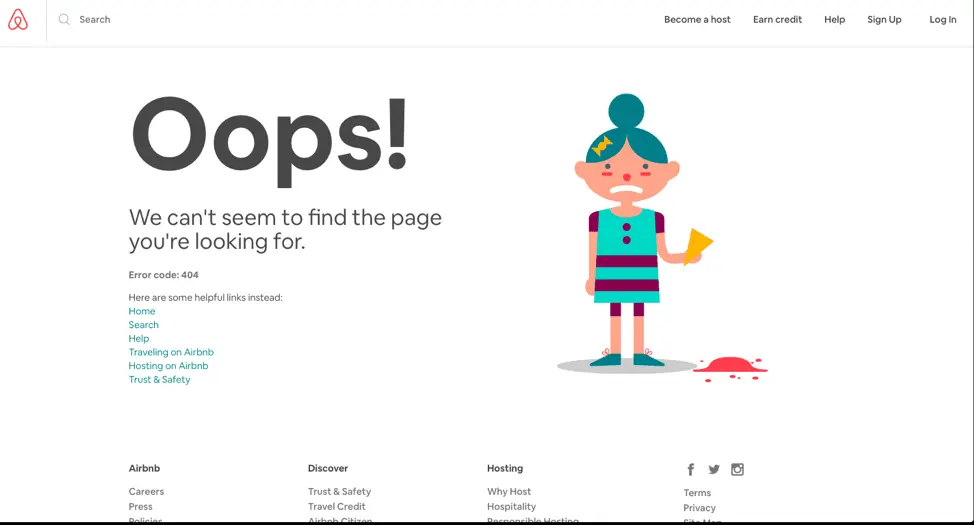
Source: Airbnb
Poor user experience:
- Your website doesn’t respond well to mobile or other screen sizes. This will send a bad message about the lack of strategy and planning behind its setup.
* Too many calls-to-action on one page show a lack of purpose for what your website aims to achieve.
User experience can make or break your website. To stay ahead of the game, it’s important to take feedback from your visitors. Incorporating that feedback will give your users a sense of gratification and improve future visitors’ experience.
Content will make it all work
Content might be the most important aspect of any website. Well-written content will bring you new traffic and repeat visits.
These days, content isn’t limited to the stuff you read. There’s now an increased demand for visual content. Animations, infographics and GIFs tell stories and illustrate data like never before. Compelling content with clear calls-to-action will eventually drive your users toward conversion.
Take a look at how the quality of your content reflects your brand’s personality.
Characteristics of good content:
- Great headlines and a call-to-action above the fold—nice. Videos on the landing page to engage fast-moving visitors—even better. This shows that you want users to get the best, most relevant material quickly without wasting their time.We especially love HubSpot for its content. The blog is fabulous, and there are explainer videos on all their landing pages, plus a video testimonial section. In short, almost every aspect of content necessary to build trust and conversion is present.
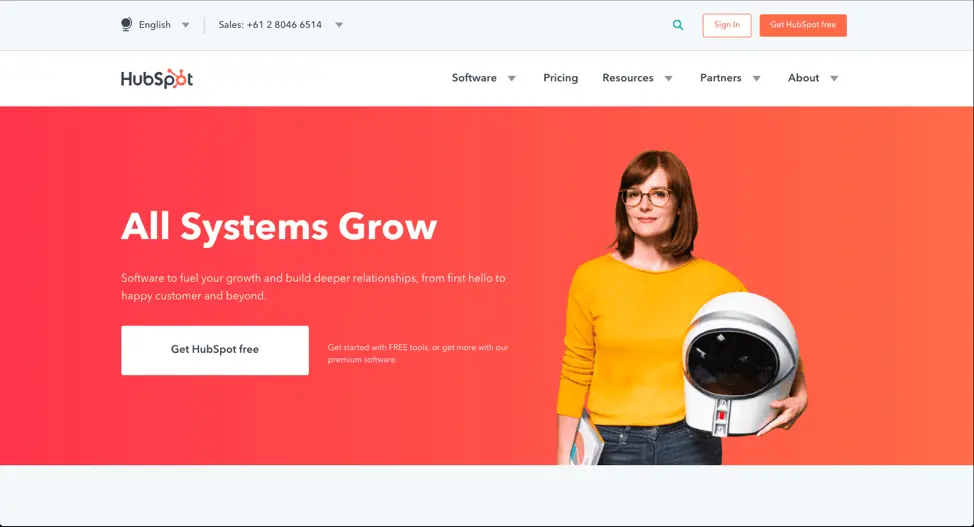
Source: HubSpot
- Use the language and verbal style your target audience speaks in. This shows that you’ve spent time thinking about and curating the content your target audience would appreciate.
* A blog should offer well-researched pieces that add value to your consumer’s decision journey. It will drive home the point that your content strategy cares more about the readers than ranking. This helps build trust and thought leadership.
Characteristics of poor content:
- Grammatical errors or typos on your site. Careless content informs your users that quality doesn’t matter to you. If you can’t pay attention to your content, who’s to say your product, services or customer support will be any better?
* Articles published just for the sake of traffic. If your content doesn’t target your audience or speak to a niche, it will be difficult for audiences to determine who your site is really for.
* Generic content that doesn’t offer anything valuable or new. This demonstrates a lack of research and understanding. The users goes away thinking you don’t really care about their needs.
Key takeaway
With so many sites competing for dollars and attention, it’s more important than ever to offer the user an exceptional experience. By breaking down your website into these three areas of design, user experience and content, you can evaluate how well each one contributes to your brand’s success. Conversely, you can also isolate areas that aren’t working and try new ways to engage your audience. When all of these areas represent your brand authentically and consistently, you will enjoy higher traffic, conversions and customer satisfaction.
Want to learn more about building & managing a brand? Check out our free eBook: Managing your brand in the cloud.
Our perception, to a large extent, is governed by vision. We’re attracted to visuals that make us feel good. It’s why retail stores promote special offers with balloons and other decorations, because they know shoppers will get curious enough to come over. The same principle applies to web design and digital marketing.
Related: 32 stats & facts that prove infographics aren’t dead
To illustrate just how effective visuals are in attracting visitors, consider these statistics:
- In 2016, over 60% of B2B marketers and small businesses planned to increase investments in video marketing strategies. (CMI)
- On average, tweets with images receive 150% more retweets than tweets without. (HubSpot)
- On average, Facebook posts with images receive 2.3x more engagement than posts without. (BuzzSumo)
Point is, visual design leaves an impression on visitors. You must learn how to use them wisely. In this post, let’s discuss how visual content like infographics and video can encourage your visitors to convert.
1. Create impact with the right typography
Unlike someone reading a book, visitors on a website don’t consume content from left to right then go down to the next line. In fact, virtually nothing happens in progression. Visitors will either go straight to what they need, or they’ll stop in their tracks if something more interesting catches their eye—like a 30% discount on another brand of detergent, for example.
Today’s designers are using typography to catch and keep visitors’ attention. The size, shape and placement of different fonts will enhance your message, and you can direct the focus where you want it most.
Consider the bold typography on this webpage. The cursive font complements the typewriter font, giving the site a vintage, personal feel. The use of color to emphasize certain words attracts the eye and sets a positive tone.
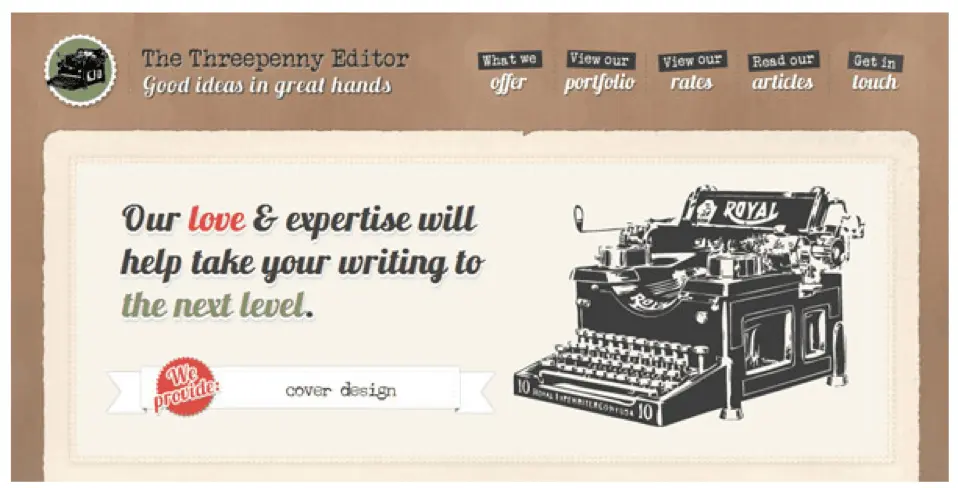
Source: Intechnic
2. Present data visually with infographics
Would you rather read through a bulky PDF filled with stats and long-winded sentences, or a colorful infographic which uses simple icons and text to display information? The choice is pretty obvious. Including a well-designed infographic in your blog post or webpage will persuade people to pause and see what you have to say.
But does it increase conversion? Here’s some compelling evidence:
- Images increase memory retention. People who hear information will only remember 10% of it three days later. But, if the information is paired with an image, they’re likely to remember 65% of it in the same timeframe. People will have an easier time reading and remembering an infographic detailing the health benefits of bananas than they would three paragraphs of text. And the more time visitors spend with your content, the more likely they are to convert.
* More shares lead to more exposure. According to NN Group, infographics are shared and liked on social media 3x more than any other type of content. Since people are more likely to share a post with an infographic, it helps you reach more people on social media faster.
3. Demonstrate your products with video
Studies show that 73% of consumers are likely to buy a product after they see a video explaining it. The medium has become many shoppers’ favorite way to find information.
Unfortunately, internet users have short attention spans and will only stick around to watch your video if the first few seconds get them hooked. With this in mind, here’s how you can make videos work for you.
- Focus on the product. Videos make it possible for brands to showcase their products in ways that might actually entice people to buy. Instructional videos provide an opportunity to familiarize an audience with your wares. For example, the furniture brand IKEA has its own YouTube channel where different how-to videos show viewers how to assemble the brand’s products.
* Focus on quality. Now that video is so popular and widespread, you have to compete on a professional level. Tailor your video for the platform it’s on. For example, Facebook visitors are more likely to stop and watch an auto-play video if it includes subtitles. If your video looks amateur or shaky, viewers will notice—and assume your brand is unprofessional.
4. Convey emotion with creative visual design
There’s a reason why people in life insurance ads are smiling. It’s to reassure us that, despite the somber nature of insurance, these folks are happy and secure with their purchase decision—and you will be, too.
Point is, humans are empathic creatures. We base our emotions on what we perceive around us. We find ourselves smiling involuntarily when we hear someone else laughing, or feeling sad when we see someone else looking miserable.
Brands can use this tendency to their advantage. All it takes is a little creativity. Consider the image on this landing page. Combined with the clever use of typography, it sends a powerful message to anyone who sees it.

Source: Scott Michael Davis
Key takeaway
To recap, even visual elements that seem simple—like the font you use—can impact conversion. Visuals that present information in appealing way, like infographics, help to retain visitors and persuade them to convert. If you’re making videos, aim for high quality polish and keep the focus on your products. Finally, visuals stir emotion. Use this to your advantage by getting creative with your visual design.
Create striking visual content in minutes with our easy-to-use desktop publishing software. Get started for free today!
Have you written off magazines because they remind you of the doctor’s office? Take another look. Digital publishing has opened up a new realm of possibilities for magazines.
And now is a great time to get into the industry—the percentage of magazine readers in the U.S. has more than quadrupled since 2013, and reports suggest that digital magazine subscriptions now outsell single issues three to one.
Related: 14 magazine layout design ideas for your inspiration
If you’re creating an online magazine, you’ll need to understand which revenue model to work with. In this post we’ll cover 5 ways you can turn a profit with your online magazine.
1. Use display advertising
As with traditional magazines, ads play a big role in funding e-magazines. Display advertising means showing an ad (text, video or audio) on a website.

A display ad on the New Yorker website. It does a good job of targeting New Yorker readers who are, theoretically, into art.
Display advertising can take the form of banner ads or short-form video ads, both of which are viable options for bringing in revenue. Remember this:
- Decide on ad size. You may want to have a full banner ad or a smaller square one depending on what fits best into your website design.
- You also need to decide on ad position. Do you want the ad at the top of you website or to the side? You can also position the ad in between the article, as a “break” in the article. If you try that position, make sure to put a footer saying “article continued below.”
- Have an “Advertise with us” section. This will help potential clients get in touch with you easily. You can have direct ad sales or use a middleman like AdSense or BuySellAds.
2. Try native advertising
When an ad is integrated into the content, it becomes a native ad. The word “native” here signifies that it blends in with the website content, meaning it doesn’t look like a traditional ad. Native ads are viewed 53% more than banner ads.
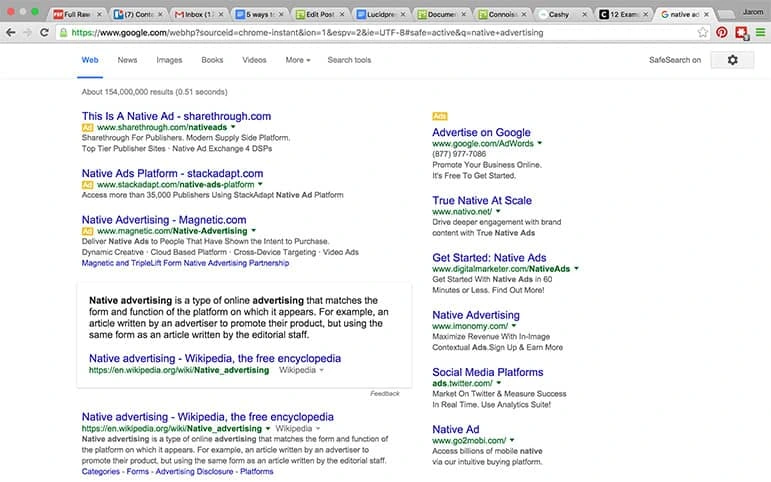
It’s easy to forget that the most common native advertisements are found in every Google search.
Remember this:
- Have a label clarifying that the ad is sponsored content. This solves the ethical dilemma for publishers.
- Make sure the content blends well with your website. This is the crux of native advertising.
- If the brand wants you to publish a story that doesn’t mesh with the character of your website, don’t do it. If you do, loyal readers will call you out as a phony and it will hurt your magazine’s reputation.
- Be creative while looking for native advertising topic ideas. Make sure the content is entertaining or educational.
3. Make an app
Right now, 45 of the top 50 lifestyle iPad apps are magazine brands. This year, the number of mobile-only internet users exceeded the number of desktop-only internet users in the U.S. A native app could add a lot of value for your readers, and if you’re ready to commit to making one, you can make it yourself using a tool like Adobe Digital Publishing Suite or hire someone to do it for you.
That’s a fairly big investment, though. If you’d like to prove out the concept first, you can use Lucidpress to create a digital magazine with interactive content and then publish it on a unique URL with password protection. This way, you can simulate the app experience and see how your readers respond. If it takes off, then you may want to invest in a native app. Remember this:
- Have ads for the app, just like you would for the website.
- Instead of having a paid app, offer a premium account that offers benefits to users.
- Ask for readers to rate and review your app.
4. Become a subscription service
If you become a trusted source for quality content that’s providing a unique perspective, you have a good chance of gaining a loyal following of subscribers. Subscriptions are a particular helpful source of revenue because they are more consistent than a one-time ad deal.
The New Yorker has found success here, attracting a loyal fanbase by consistently putting out fantastic content. Subscribers receive unrestricted access to all the articles and blogs on The New Yorker along with 90 years of archives. Tools like Lucidpress will let you place content behind a subscription paywall. Here’s one simple way to do it:
- Publish your magazine to the web.
- Set a password so only certain people can access the content.
- After readers pay for a subscription, email them the password.
Remember this:
- Price the subscription competitively. Readers expect online subscriptions to be cheaper because there are no printing costs involved.
- Give away a few free articles so that readers can test the waters. Have a plan where readers gain access to, say, 5 free articles in a month. After 5 articles, they will have to pay a subscription fee for unlimited access.
5. Ask for donations
Some magazines depend on the goodwill of their readers to increase revenue. An online tip jar gives readers the chance to contribute to what they consider a worthy cause.
BrainPickings does a great job with this model. It’s a well-designed site that presents quality content for free while asking for donations. Offering incentives for donating can also boost your cash flow. JoshReads and Loading Artist are two websites that provide reader shout-outs for big donors.
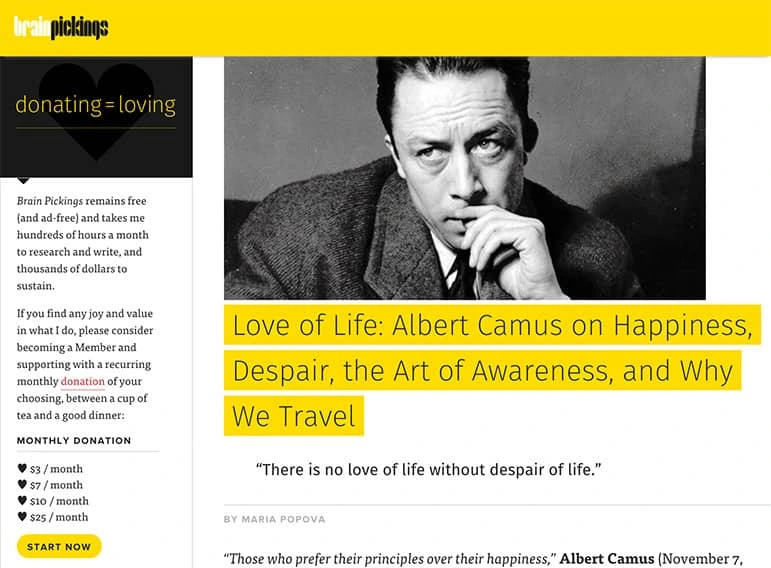
The BrainPickings’ appeal for donations.
Remember this:
- Use trusted payment apps like Patreon or PayPal on your website. These apps are designed for this purpose. They are easy to use and familiar to most web users.
- Make the donation button visible on each page. Don’t seem pushy, but write copy that strongly shows why readers should donate.
Ready to get started? Create & customize your own digital magazine with these free magazine templates in Lucidpress.
First it was smartphones, quickly followed by tablets and now smartwatches. The move towards mobile devices is quickening, and marketers are following suit. In 2016, they spent $101 billion on mobile internet ads worldwide, $40 billion in the U.S. alone. From 2013 to 2019, there will be an estimated tenfold increase in mobile advertising spending.
Related: 10 digital trends that are transforming marketing in 2018
So how can your brand benefit from mobile spending? And how can you make sure that your mobile customers keep coming back?
Here are some ways marketers are using mobile to increase brand loyalty and cash in on mobile success.
Mobile pay creates loyal customers
No, mobile pay is not the leading form of payment. Not yet. But things are heading in that direction. In 2014, mobile pay accounted for $4 billion of in-store purchases. By 2019, it’s expected to increase to $34 billion. Though still lagging way behind plastic with only 13% of smartphone owners having used it to make a purchase, that number will rise. Especially since marketers for companies such as Android and Samsung are starting to offer incentives like loyalty cards for customers who use their mobile pay platforms.
Retailers like Starbucks and Dunkin’ Donuts offer mobile pay through their apps and reward customers who use it. The Starbucks mobile pay program via its app has been so successful that over 21% of all U.S. Starbucks store purchases come from it. There’s an expectation that in a few short years, the app payments will account for 50% of business.
Richard Crone, CEO of mobile-strategy company Crone Consulting LLC said the Starbucks mobile pay app was “the most successful launch of a new payment type in history.” Marketers, take note.
You can improve customer targeting with mobile ads
Mobile is on the cutting edge of marketing technology. Where else can you seamlessly integrate geofencing, purchase preferences and history, and social media interaction with your brand? Mobile lets you isolate essential customer information to offer the most personalized and targeted marketing in history.
Mark Ghermezian of Appboy says about the future of mobile marketing:
“Brands must understand how to strategically connect with customers on a personal basis and encourage engagement, based on customer behavior, to transform them into long-lasting users. Mobile marketing automation will allow companies to collect and use data in a more actionable way and deliver personalized and timely messages to their customers.”
Companies who effectively harness mobile tools create stronger relationships with their customers by anticipating their needs, stimulating their desires, and rewarding them with exclusive offers and promotions.
Customers like to shop on mobile devices
Consumers interact with brands through their smartphones in a number of ways. They look up brick-and-mortar store locations, search for coupons and make purchases. Anna Bager, senior vice president of mobile and video at the IAB (Interactive Advertising Bureau) says:
“Pressing the ‘buy’ button on mobile devices is now a regular occurrence the world over. […] Marketers and media agencies need to fully embrace smartphones and tablets as a critical pathway for all shopping activities and increase investment if they want to build meaningful relationships with mobile consumers, driving them from discovery to purchase.”
The fact is that customers like to shop on their mobiles. In a study involving mobile users in 19 different countries, 80% said they had a positive experience with mobile shopping. Also, consumers engage more proactively with mobile apps than with traditional forms of advertising. The ability to take advantage of deals and shop at their own convenience are key factors in mobile shopping’s popularity.
Mobile apps increase your brand frequency
Mobile apps not only incorporate all of the above principals, but they also effectively increase a customer’s exposure to your brand. Americans spend on average 4.7 hours a day looking at their smartphones. Factoring in sleep, that means that people are spending about a third of their day on mobile. If your brand is on their device, they’re being exposed to it constantly.
The marketing term “effective frequency” suggests that the more frequently a consumer is exposed to your brand, the higher their intent to purchase becomes. When you adopt a mobile marketing strategy, you’re exponentially increasing your brand’s visibility.
Dick Stroud, Managing Director at 20plus30 said it best when he remarked, “At the birth of the web, companies aimed to get their website bookmarked. Marketers should be in a race to get their apps on the home screen of consumers’ smart devices.”
Ignoring mobile is a big risk.
As the trend towards personalization and targeting through mobile increases, customers are changing their expectations of interactions with brands. 54% of consumers say that a poor mobile app experience would make it less likely for them to patronize that business again, and 27% of consumers say that it would give them a negative view of the brand’s products.
Marketers ignore the mobile trend at their peril. It was estimated that the UK retail industry loses a potential 6.6 billion GBP due to lack of investment in mobile. Jamie Turner of 60SecondMarketer warns: “If you’re not using mobile marketing to attract new customers to your business, don’t worry—your competitors are already using it and are getting those customers instead.”
An investment in mobile marketing is an investment in brand loyalty. Even fringe technologies like mobile pay are on the rise and some early adopters have already seen great success in using it to increase customer loyalty. Your mobile presence has a great deal to do with consumer perception of your brand. Bottom line: use mobile or lose customers.
I’ve been writing page titles incorrectly my entire career.
Google has provided best practices for constructing page titles, including:
- Describe the content on the page.
- Create unique title tags for each page.
- Use brief but descriptive titles.
These are all great practices to follow on every page of your site. But I’ve recently learned that there’s something else just as important as the best practices Google provides:
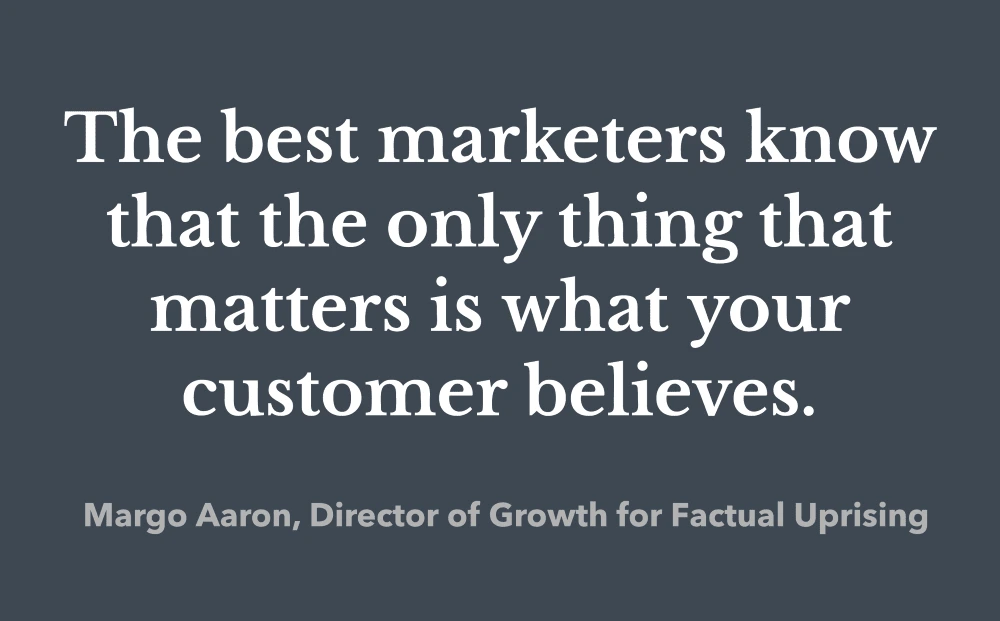
Don’t just optimize titles. Optimize thought sequences.
Your page title serves three primary purposes:
- To provide searchers with a description of your page.
- To provide Google with information that helps it determine how relevant your page is to a search query.
- To provide messaging to searchers that drives them to click on your result.
Succeeding in this final purpose will determine whether your pages achieve click-through rates that outperform average rates in Google. With page titles, I found an easy technique for presenting the right messaging to searchers: brand positioning.
Related: 8 best practices of high-converting websites
Why brand positioning?
Phillip Kotler, Professor of International Marketing at Northwestern University, defines brand positioning as “the art of designing the company’s offering and image to occupy a distinctive place in the target market’s mind.”
Occupying a space in the searcher’s mind is how you compel them to click on your result instead of your competitors’.
A case study
Here’s an example from a page on our site targeting the keyword “ebook templates.”
The original title for our eBook templates page was the following:
Free eBook Templates & Examples | Lucidpress
This title follows Google’s best practices: it accurately describes the page, it’s unique, and it’s brief but descriptive.
It also meets the first two purposes of a page title: it provides searchers with a description of the page, and it provides Google with information to determine how relevant your page is to a search query.
What it lacked was messaging that compelled searchers to click on our link. Nothing in the original title helped “occupy a distinctive place in the target market’s mind.”
Our hypothesis was this: If we could help searchers imagine how our eBook templates would help them grow their brands, then we’d be able to compel them to click on our result over the others.
Keeping this brand positioning in mind, here’s the new title:
Free eBook Templates & Examples to Help Build Your Brand
The result: a 118% increase in the click-through rate for the keyword “ebook templates.”
Incorporate brand positioning into your page titles
To incorporate brand positioning into your page titles, I’ve found it helpful to create a brand positioning statement for each page:
Our [subject] page helps [the audience] [achieve a result] so they can [benefit].
In the example for our eBook template page, here’s the statement we came up with:
Our eBook templates page helps small business owners position themselves as an authority so they can grow their brands.
Bonus: The power of branding
According to Marty Neumeier, author of The Brand Gap: How to Bridge the Distance Between Business Strategy and Design: “Brand will become the most powerful strategic tool since the spreadsheet.”
Data from a study we conducted at Lucidpress with the global marketing research & advisory firm Demand Metric seems to back up this statement.
In this study, we found that the average revenue increase attributed to having a consistent brand is 23%.
[Click here to view our full report on how brand consistency can help drive your company’s growth.]
We also found that brands with consistent presentation are 3-4 times more likely to enjoy excellent brand visibility than inconsistent ones.
This is the power of branding—the ability to improve organic search performance for your website and drive revenue growth for your organization. Try it on your page titles to see if it holds true for you, too.
Next steps
Ready to create compelling page titles?
- Create brand positioning statements for your high-priority pages.
- Incorporate your positioning statements into your titles.
- Track changes in click-through rates and rankings using Google’s Search Console.
Feel free to leave a comment below and tell us how it went.
Learn more about how brand consistency impacts your business in our free report.
A well-constructed digital marketing campaign can offer limitless possibilities for businesses who are open to implementing new, proactive strategies to go along with their most-revered traditional ones. After all, mixing up some old and new campaigns can bring interesting and promising results to data-driven businesses.
Among the most cost-effective ways to build and maintain a connection with your audience is through an email newsletter program. Yes, those recurring emails you’re used to receiving from your favorite brands and personalities can also be a catalyst for your own brand’s long-term success.
Related: How to make a newsletter in 9 steps
It’s easy to set up, too. For example, newsletter software like ActiveTrail’s email marketing automation platform (which offers newsletter templates and a responsive email editor) can be a great complement to the visuals you design in Lucidpress. But in any case, if you’re not yet implementing this strategy, here are 4 reasons to set up your own newsletter program soon.
Stabilize the flow of information
Your website and blog might offer the best content on the internet, but the thing is, most online visitors will still rarely spend more than a few seconds on any webpage. That’s why a proactive support system should be in place to keep people coming back. Remember, a blog often requires people to initiate contact, and as a business, this behavior can translate to inconsistent returns. But if you have an ongoing newsletter campaign, you can conveniently reach out to your customers and drive further engagement. By giving your audience instant access to promotions, new products and other updates, people will have a much easier time understanding what your brand can do for them.
Increase brand awareness
A newsletter can carry a substantial amount of information, making it easier to create awareness around your products and services. By proactively sending out new messages, customers and prospects will come to feel your brand is familiar and will think of it more often. It’s an efficient and consistent way to remind people of your presence, and if your content is timely and compelling, it’ll drive your audience to act.
Connect with new prospects
It’s no secret that people love to window-shop online. Much of the time, people are passively looking for products and services that they want, but they simply don’t have the time, money or right reason to buy now. A newsletter that provides prospective clients with valuable information helps them make favorable decisions when the right time comes. Use your newsletter to prove your expertise and stay in touch with potential customers until they’re ready to strike a deal.
Keep existing customers in the funnel
You lose some and you gain some. But how about gaining more? Companies can never completely eliminate churn, but a thoughtful newsletter campaign can certainly reduce the risk of annoying your recipients. By keeping them in the loop, getting their feedback, and introducing them to your latest offerings, customers will feel like you have something more to offer and that you’re consistently improving your services. The more you stay in touch with customers, the more likely they’ll feel valued and appreciated. []
Are you feeling inspired and optimistic about starting your own newsletter campaign? Don’t wait—roll out a program now and keep the deals coming in, not only from your existing customers, but from the thousands of prospective customers out there.
Here’s more than a dozen free newsletter templates to help you get started.
A friend of mine says she could not help but be swayed by what people were saying about the importance of social media for increasing sales. Some people kept rhapsodizing about how they were able to achieve rocket sales by establishing brand recognition and strengthening their brand’s presence in social networking sites.
So this friend opened an account on Facebook, created a blog, squeezed in a post here and there, and sent out newsletters to introduce her product—and generated no significant increase in sales at all. Why?
Related: 7 serious social media mistakes brands still make
The truth about the use of social networking sites
My own research shows that I should not rely on luck to sell my brand—not even when I use social networking sites. I cannot expect mere presence in social networking sites to work magic and automatically land me great sales.
How can I successfully market my brand in social media? How can I increase customer conversion rate?
I looked into case studies and marketing research. I read up on what the technical marketing experts had to say. Here’s what I found.
Put your brand where your target market is
Alex Chris is an author and Digital Marketing Consultant. He is an expert in Internet Marketing and SEO. He says that based on updated surveys, Facebook dominates the social media scene today. A massive 1.79 billion people actively use the site monthly.
Alex says that you have put your brand where your target market is. With 60% of people on the Internet using Facebook, there is no greater tool to promote your brand, find new customers and gain a loyal following.
He suggests that you create an optimized Facebook page, add friends to your personal Facebook page, and get as many “likes” as you can. He suggests putting a “like” box in your website. You have to put this “like” box in a conspicuous, readily accessible spot.
Create relevant content
Alex and a great number of other marketing specialists, say that it is not enough to create social presence. You have to create high-quality content for your followers. If you are able to do this effectively, you have a greater chance of turning your followers into constant website visitors, and eventually to customers.
Connect with your audience before selling your product
Kristen Matthews is a creative digital strategist. As an influencer marketing consultant, she has worked on a variety of case studies with innovative brands.
A Huggies case study highlights the need to create not just any content, but one that emotionally connects to your target market—even before you push your brand.
Speak, listen & respond to your audience
Brittany Berger heads the Content & PR Division of Mention.com. She says that when you send out newsletters as part of your marketing campaign, you speak directly to your target market.
Make your audience feel that you are listening to them. You create positive vibes when you respond as soon as you can to any queries or points that they want to clarify.
Do not be too promotional
When I create posts, I am representing a vision, specific objectives, and explicit principles. I am also creating awareness and recognition of my business brand.
I am not simply selling. I am informing and educating my audience.
If I become too promotional and focus exclusively on trying to sell my brand, people may see my posts as self-serving. I may lose my audience.
Online entrepreneur, writer, and founder of UpFuel.com Chris Guthrie agrees that you have to find the right blend of marketing and educational values. The right mix provides true value for your customers. It will also give you the opportunity to sell your brand.
Cater to your audience
I have a website on social media. I have a responsibility to my followers. I have to come up with content that has to do with my particular niche. I have to create posts that are engaging and useful to my audience.
If I want to maintain a loyal following, I have to go out of my way to share relevant posts in a variety of interesting ways that include written articles, videos, info graphics, images, and charts.
I want my followers to feel that they are important to me. If I send out e-mail, I have to respond to queries as soon as possible.
If I do not think my content through and create posts that do not offer anything substantial, I may end up hurting my business reputation instead of helping spark brand awareness.
In a nutshell: what to do
- To sell a product or service to people, build a strong social presence.
- Elicit interest. Build trust.
- Provide appealing and relevant content.
- Use storytelling effectively.
- Find out your audience needs and wants. Tell your story based on these.
When you are able to do these, you will be able to generate more traffic to your website. You will be able to create a bigger following. And you will be able to enjoy a higher conversion rate.
Ready to drive more leads with social media? Grab a copy of our free eBook: How to adapt your brand to social media
Here’s the thing: the in-person experience isn’t dead. And furthermore, direct mail marketing isn’t dead. It’s an audacious statement for sure. But like the in-person shopping experience, direct mail marketing is just different. It’s not the norm anymore. But that’s what makes it all the more unique and effective.
That said, there’s no doubting that online marketing has taken the world by storm. Not only is online video consumption reigning supreme over traditional TV viewership, but it seems the world has gone mad for — and forgot about — the value still held in offline marketing.
Direct mail marketing happens to be an excellent example of offline marketing. Think of direct mail marketing as you would letters, postcards and brochures landing right in the mailbox of your ideal customer. That’s pretty spiffy!
What is direct mail? Direct mail is a form of direct marketing where promotional materials are sent to prospective customers in the mail.
Related: Building a local brand—5 essential things to know
Your mailbox — you know, the metal one with your address on it — has a bad reputation. Meanwhile, your email delivers discount codes for your favorite shops and other exciting tidbits of information. But that IRL-mailbox space is filled with bills, junk mail, earwigs and who-knows-what-else, right?
Sometimes, but not always.
While you’re certainly bound to receive bills, junk mail and find the occasional earwig in your mailbox, you can also count on uncovering letters from family members or collateral that’s seemingly custom-fit for your needs. It’s almost as if those ads you’ve been seeing all over social media popped up in your mailbox, which is pretty cool, right? That’s what direct mail marketing has the capacity to do.
So, what can direct mail marketing offer that online marketing can’t?
Direct mail marketing gives customers a tactile, interactive experience that they (perhaps unknowingly) crave and miss when they get a coupon emailed to them or when they are bombarded with an ad on social media.
But direct mail marketing doesn’t stop there — it delivers three other noteworthy factors.
Direct mail marketing is easy to understand
One reason direct mail marketing is more effective is because it’s easier to understand. One study found it takes 21% less cognitive effort to process, meaning your audience (or prospective customer) don’t have to invest time or extra brainpower into your postcard, mailer or any other type of direct mail marketing campaign.
The success of any marketing campaign — whether it be direct mail marketing or an online campaign— is contingent on whether or not it resonates with your customers. Because, if your target audience is finding the content difficult to understand, or if they feel confused or lost at any point in the content journey (or hile reading the collateral), your campaign is unlikely to meet success objectives.
Direct mail marketing feels more memorable
Forgive us for being a tad melancholic, but, there’s something incredibly heartening about receiving a letter or a package in the mail. It feels very human — as if there’s another person on the other end of the care package or neatly tucked behind the envelope. Someone had to go to the effort to writing said letter or find knick knacks to stuff into a box. You remember mail — along with the person who sent it and why they sent it along.
Plus, studies show that millennials who spend more time with a physical ad in hand have a stronger emotional response to the marketing campaign, lending a stronger overall memory of the ad. Who knows, you could be on the list of the next generation’s most-loved advertising campaigns by optimizing your use of direct mail.
Direct mail marketing has stronger response rate
Direct mail has a better response rate than email marketing, with 4.4% of campaigns receiving a response when delivered through the mail, compared to just 0.12% online. []
For example, for content (in a campaign) that’s delivered to 1,000 people, 43 more people will interact with your direct mail than your emails.
As in, you’re missing out if you push your entire marketing budget into email — especially when direct mail can be more cost-effective.
The Do’s and Don’ts of direct mail marketing
Want to stand out from the crowd and make sure you pull off a marketing campaign that drives a high ROI? Here are three tips.
DO proof your stuff
Typos or misspelled names are a surefireway to undermine your authority or make a customer doubt what you have to bring to the table. Proofread your stuff before sending it out. And make sure you get the customer’s name right.
DO have fun — Get creative
Get creative with you direct mail marketing campaigns! Don’t just fire off a boring letter that could get mixed up with a prospective customer’s bills. You want to create something memorable — something that familiar or maybe even something nobody has seen before. Don’t be afraid to throw a proverbial party in their mailbox!
You can do this by sending:
- Foldable origami
- Customized postcard designs
- Interactive letters, where your audience needs to do something to reveal a message
A fantastic example of creative direct mail marketing comes from the team behind World Water Day’s campaign. Their aim was to raise awareness about the event, but they opted to create a direct mail with words that only became visible when soaked in water.
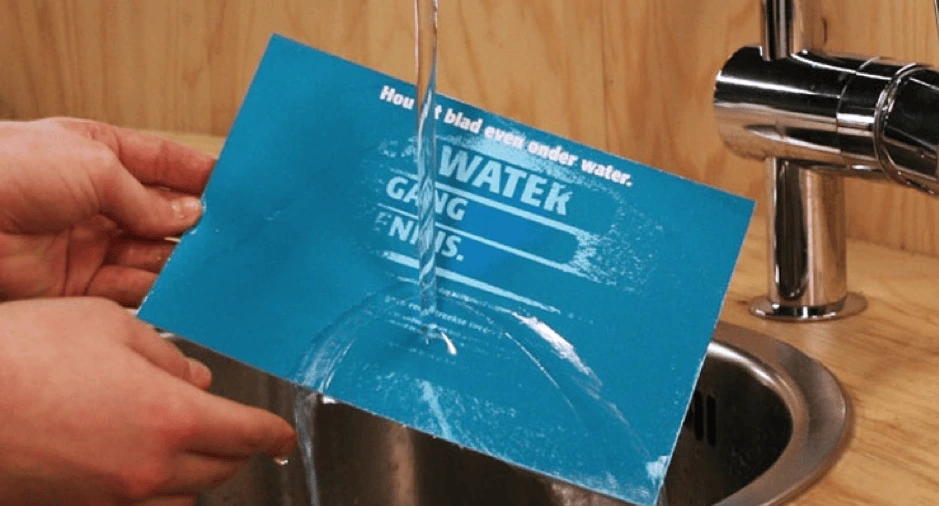
Not only did this direct mail campaign explain World Water Day’s campaign aim creatively, it also became an interactive piece of content. Interactive content has been proven to generate 2x more conversions than the alternative. That’s pretty genius, right?
Lucidpress: Click the image to use the template
Use one of our direct mail templates as inspiration for your own direct mail piece. Switch out colors, fonts and texts to create your direct mail postcard or flyer in seconds.
Browse all direct mail templates



DO emotionally engage customers
The second way to ensure your direct mail marketing campaign is a success is to make your audience feel something — any type of emotion. After all, there’s such a wide range of them. Emotion has been the marketer’s secret weapon for years. Various studies show that people rely on emotions, not just logical information or data, to make buying decisions.
Feelings of anger, disgust, affirmation and fear often top the list of emotions that work well in advertising.
A fantastic example of this comes from the Natural History Museum. In an attempt to educate local people about the danger of animal extinction, they sent an eraser to their audience with a quote about the topic.

Because their audience could see a visual representation of extinction in their daily lives, it made them stop to think about how serious it is… and want to act.
Pick an emotion and drive it home through your next direct mail campaign. You’ll soon see the impact emotion has on marketing—but the victories will be for your own brand.
DO put your own spin on it
For the most part, mailboxes aren’t fun environments. Bills, bank statements and lonely newspapers often clog up the mailbox marketing route. But, you can stand out by making your direct mail marketing campaign a little unique.
A fantastic way to achieve a little uniqueness is through juxtaposition. Can you think of a smart, innovative way to show how powerful your offering is by comparing it to something completely different?
Let’s take this direct mail campaign for example. Created by the theatre team behind a local performance of Macbeth, they wanted people to visit their show. Instead of online marketing, they exploited their direct mail opportunity and found a way to stand out in a mailbox.

You’d probably never compare a Shakespeare play to a fast food joint, right? But that’s part of the reason why it works.
The juxtaposition of both elements makes you take a second take at the direct mail rather than toss it in the trash. This type of content experience (within direct mail marketing) is bound to make an impact on an audience, one who possibly has an interest in both but would never expect them to be paired together.
All in all, direct marketing provides you or your creative team with untold opportunities to lean into the creative, get weird and try new things. Plus direct mail marketing allows you to access new customers or get a feel for a prospective audience who might otherwise pass up your product or services.
DON’T skip doing the proverbial “leg day”
Leg day for direct mailing entails defining your audience and running some tests before you send out the direct mailers. Now, neither task needs to be a heavy lift. Defining your audience can be as simple as knowing who your product is best suited for and tailoring where and what neighborhoods you send the direct mail to based on this information.
Additionally, try sending a few flyers or direct mailers out to a small segment of your target audience. Make sure to include trackable tests, like a QR code or a custom URL (which we’ll touch on more momentarily).
DON’T forget to set goals for the campaign
Consider the following questions. As in, are you looking to drive brand awareness or boost sales of a particular product? Are you looking to assess brand awareness, and if so, how will you measure success or failture? Alternatively, if you want to increase sales, what is the target revenue or fiscal marker for your campaign? Specific goals will give you a benchmark to measure (and brag about) the campaign’s success, and it will help you drive improvement based on the results.
DON’T ignore the importance of a CTA
Simply put: You need a way to measure your goals and attribute which-sales-to-what-campaign-directive. Well, a CTA can help with that. Start by creating a custom URL to include in your direct mailer. This custom URL will empower you to track visits and sales from the website location, allowing you to attribute conversion and ROI to your direct mail campaign.
DON’T spam your customers
Inundating your customers with a lot of direct mail, emails and more is not the best way to get their attention. Sure, you’ll be top of mind, but it’ll be because you’re irritating them — not inspiring them or addressing a pain point. You don’t want to undermine the relationship you’ve worked so hard to build with them, so be mindful of who-you-send-what-where-and-when.
You’ve got mail — Lucidpress mail
If you couldn’t tell already, we’re big fans of direct mail. Now, the exciting part about Lucidpress is that we don’t just empower anyone to create compelling, effective content — we also make it easy to conduct a direct mail marketing campaign.
Choose from any of our direct mail marketing templates to customize and edit. Or, alternatively, if you’re feeling brave, you have the option to design your own. Then, all you’ll need to do is:
- Upload a .CSV file containing the details of people you’d like to target,
- OR use radial search to select a local delivery area.
Once selected, press the proverbial “go” button and use the direct mail marketing integration to send your mail directly within a matter of days. There’s no need to stop at your local post office with oodles of mail, thus, taking the stress out of building a direct mail marketing campaign.
As you can see, direct mail isn’t an old-school marketing technique that should’ve stayed in the 00’s. These tips, along with our new features, could be the combination you need to build a direct marketing campaign that drives excellent results for your business.
Learn more about the direct mail features in Lucidpress, and give it a test drive.
Bonus: Direct mail infographic
Craving more data? Check out this illustrative infographic about direct mail from our friends at Colourfast.

Direct marketing can be extremely effective for businesses focused on serving specific geographic areas. By sending letters, flyers, and other marketing materials straight to prospects’ homes or workplaces, you can generate business in a cost-effective manner.
Related: Direct mail: Does it still work?
Direct marketing (also known as direct response) is an umbrella term that includes email, online display ads, paid search, and direct mail. The common denominators are 1) they target specific people and 2) they ask for some type of action.
The requested action could be anything from giving you a call or redeeming a coupon to scheduling a free consultation or starting a trial membership. The possibilities are limited only by the marketer’s imagination.
In this post, we’ll focus mostly on the time-tested technique of direct mail, which remains very profitable for realtors, gym owners, franchisees, and other businesses focused on serving local communities.
How can you measure your performance?
Let’s discuss the key metrics of direct marketing campaigns. Understanding these is the first step to ensuring that your strategies are always improving.
Direct mail open rate
When most people get their mail for the day, the first thing they do is separate the “junk” pile from the stuff that deserves their attention. Getting our messages into the stuff-to-open pile is the first hurdle direct mailers must clear.
How often does this happen?
Unfortunately, because we aren’t in prospects’ homes or offices with them, this is a difficult metric to track. Paper mail is a different animal than an email campaign, for instance, because email marketing software allows us to track how often our messages are opened and clicked.
It’s unlikely you’ll know what your direct mail open rate is. That said, prospects can’t respond to a message they haven’t read, so we want to do everything we can to increase it. That’s why seasoned marketers test different variations of the same direct mail package. Seemingly subtle details—like the envelope color or the font of your prospect’s address—can make a significant impact.
By sending out two versions of the same marketing message (a process called A/B testing), you can track which version performs best. After enough testing, the winning version becomes the “control,” which you can test against newer variations. This ensures that you’re constantly optimizing your direct mail packages to get opened as much as possible.
Let’s say you’re a realtor looking to build your client base in a new neighborhood. You decide to send out 500 letters introducing yourself and asking for interested recipients to give you a call. Your message is the same in every letter, but the envelopes are different. 250 are white. The other 250 are yellow.
You get 13 calls from the white group, but only 6 from the yellow: a statistically significant result. We don’t know for sure how many people opened the envelopes, but because the response was so much higher with the white group, we can assume it’s the better option moving forward. Next campaign you might test it against another color, like light blue.
Direct mail response rate
The response rate measures how many prospects follow up after seeing your messages.
A response isn’t necessarily the same thing as a sale. It often will be if you’re selling inexpensive impulse items, like a pizza store owner mailing out coupons. In those cases, responding (using the coupon) is the same thing as becoming a customer. But that isn’t always the case with more expensive products (like real estate), when people might respond before they’re ready to buy.
How do you measure this?
The challenge becomes figuring out which prospects responded due to your direct mail as opposed to other marketing channels. Here are just a few strategies you could use to track response rates:
- Call tracking. Assign unique phone numbers to specific direct mail campaigns, so when prospects follow up you can see where they came from.
- Coupon or discount codes. You’ve probably seen these in your own mailbox. Local businesses often create special coupons for direct mail campaigns. When prospects redeem them, it’s easy for the business owner to track their success.
- Exclusive offers. You could create special offers exclusive for direct mail recipients, so you know they couldn’t have discovered them anywhere else.
- Personalized URLs. A tech-savvy way to track responses is to have direct mail recipients follow links to unique landing pages you’ve created for the campaign.
- Just ask. Businesses often ask new customers how they heard about them, collecting responses via informal surveys.
Don’t worry if your response rate seems low. In 2017, the Data & Marketing Association’s Response Rate Report found that the average response rates sent to houses was about 5.1%. The same report revealed that oversized envelopes had the highest response rates, probably because they stand out from the pile.
Imagine you own a hamburger restaurant. You decide to send out coupons to promote your new curly fries. You send out 2,500 coupons, and 175 people end up redeeming them. What’s your response rate?
The formula is simple. All you have to do is divide the responses by the total pieces sent. In our burger example that turns out to be 7%—a great response!
ROI
Direct marketing can be extremely profitable, but there are certainly still costs involved. Everything from accessing mailing lists and databases to printing services, postage and the paper itself—these things add up.
Your marketing budget is limited. Tracking your results will ensure you’re allocating every penny where it’s most effective.
That’s where ROI comes in. This acronym, which stands for “return on investment,” assesses the revenue your campaign brings in relative to its cost. It’s probably the most important metric to pay attention to because you can compare it with the results from other marketing efforts.
Say you’re a gym owner offering a great deal for a new membership. You spend $6,000 on your direct mail campaign, which results in $7,800 of new business. You want to know your ROI.
The formula to calculate ROI is as follows: (revenue – campaign cost) / campaign cost. So, in our example, we get (7800 – 6000) / 6000, a very respectable 30%.
Your turn
Although many small business owners are overlooking direct marketing in 2019, it remains a viable strategy for businesses targeting local areas. You might use email, direct mail, pay-per-click, or all of the above.
Understanding the key metrics will help you see how well your campaigns are paying off. Continuing to track them while you experiment with messaging will ensure they’re as profitable as possible.
Learn more about the direct mail marketing service in Lucidpress, and give it a test drive.
Okay, so you’ve recently made the conscious decision to focus more of your energy on creating content with the hope of collecting more leads.
As an avid devourer of content yourself, you’ve seen a ton of other brands leverage content to generate massive amounts of buzz for their companies.
You’ve heard the success stories and statistics. You know content marketing can drive in 3x as many leads as traditional marketing—and it costs businesses 62% less than traditional methods, too.
Related: 5 myths that devalue your content marketing strategy
So, you decide to give it a shot. You spend hours creating a number of insightful and informative blog posts that you know your target audience will find valuable. You post them on your site, sit back, and wait for the new customers to start rolling in.
But… nothing happens. Those blog posts? Nobody’s reading them. Or—and this might sting even worse—people are reading them, but it hasn’t made a lick of difference to the size of your customer base.
In either case, it can be incredibly disheartening to realize your efforts haven’t paid off as well as you thought they would. On top of that, figuring out where you went wrong can be rather difficult, which may lead you to throw in the towel on your content marketing initiatives before they even get off the ground.
Before you throw your hands up in resignation, though, let’s take a look at some of the most common reasons many content marketing campaigns fall short of their intended goals.
4 content marketing mistakes that may be costing you leads
Before we dive in, let’s admit that the true list of reasons a given content marketing campaign could fail is inexhaustible. Because so much goes into content marketing, Murphy’s Law can rear its ugly head at almost any given time, for many different reasons.
For our purposes, though, we’re going to discuss some of the overarching mistakes and problems that could sabotage your content marketing campaign before you even get started.
Not focusing on your true purpose
Presumably, your goal is to generate more leads (and eventually more sales) by publishing intriguing and informative content for your audience to devour.
But have you really thought about how creating such content will actually lead more people to purchase your product?
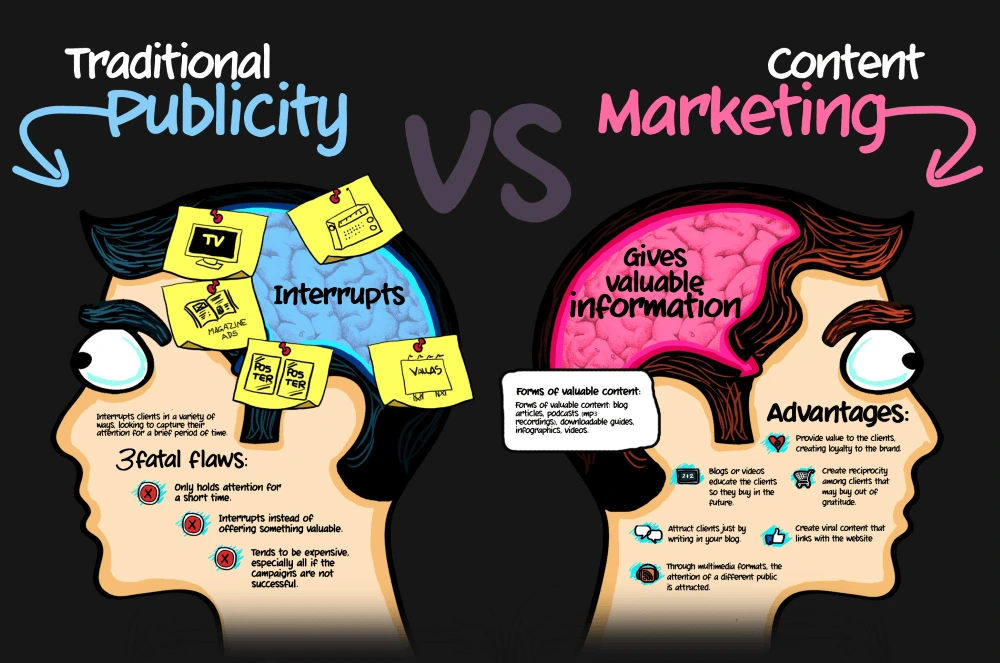
Source: 87 seconds
The only thing worse than seeing no increase in your visitor count is seeing an increase in your visitor count but no increase in your sales numbers.
As you begin creating content, it can be easy to lose sight of the fact that your purpose is to create awesome content that leads your readers toward conversion. It can be easy to slip into a routine of churning out pieces of content that, while interesting and informative, simply don’t do anything to move your readers further along the buyer’s journey.
Solution:
Ask yourself the following question before you begin creating any piece of content:
How will this content benefit my reader and bring them closer to conversion?
It’s essential to keep in mind that content is not your product; it’s part of your marketing plan. [] While the content you create absolutely should provide value to readers, it should also provoke them to take action and engage further with your brand.
For individual pieces of content, you might aim to get your audience to sign up for a mailing list, follow your brand on social media, or share the article they’ve just read. Depending on the context, you might ask them to sign up for a demo of your product. While such calls-to-action are typically found at the end of a piece of content, they can also be placed within the content as appropriate.
Over a longer series of content, your goal is to build your readers’ understanding and curiosity about your brand and the services you provide. As this article from Copyblogger points out, you can use content to create “open loops” in your readers’ minds that essentially keep them wanting more—meaning they’ll look for ways to engage with your brand that ultimately may involve making a purchase.
Always remember that your main goal is to have them come away from your content closer to converting than they were before they read it.
Writing for a mass audience
As the old saying goes:
“If you try to please everyone, you’ll end up pleasing no one.”
Unfortunately, when getting started with your content initiatives, it’s tempting to create content that you believe will appeal to your entire consumer base at once. In doing so, you end up creating content that is either:
- So general that it doesn’t provide value to any individual audience members
- So packed with information that it completely overwhelms your audience
In either case, the result will almost certainly be the same: your potential customers will bounce from your content without taking the action you hoped they would.
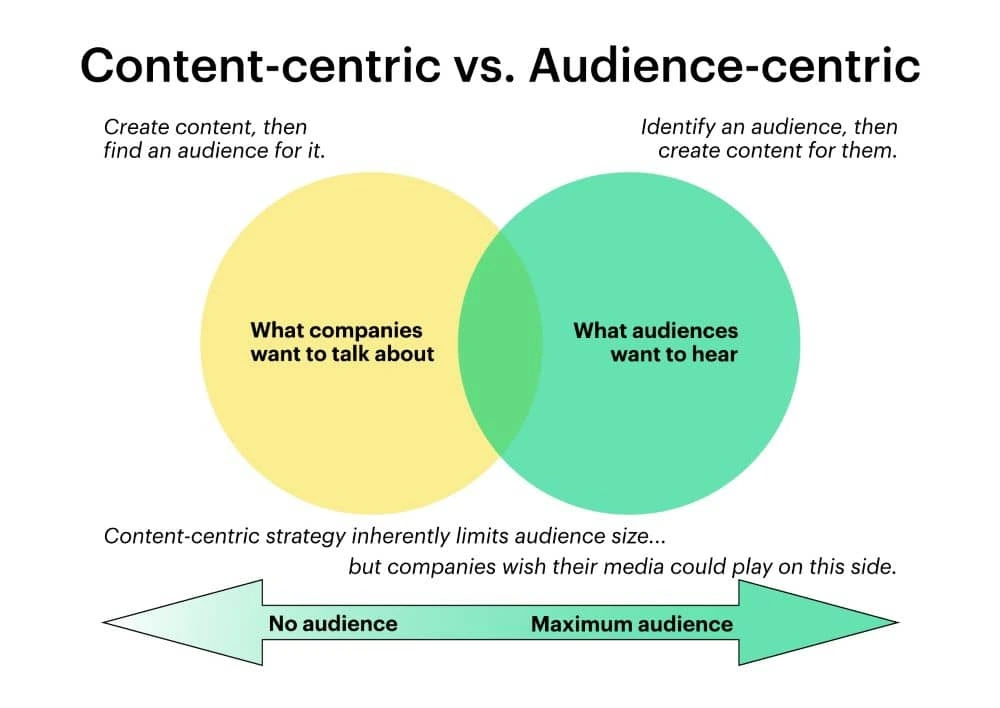
Source: Content Marketing Institute, lovingly recreated in Lucidpress
Solution:
First things first, make sure you’ve developed a variety of personas to target. Find out as much as you can about the people who belong to these segments: their demographic and geographic data, their personality types, and their actions and behaviors as consumers.
Once you’ve defined and developed a number of customer personas, you can begin planning content intended for each of them (rather than using a “one-size-fits-all” approach).
While this means you’ll be creating more pieces of content, you’ll ensure each piece of content will resonate with its intended audience.
You can make sure the right content gets in front of the right person in a few ways:
- Categorizing posts on your blog by topic
- Implementing a search function on your site
- Allowing mailing list subscribers to choose which content they receive in your newsletter
Focusing on one content format
Typically, when most people hear the phrase “content marketing,” they automatically think about blogs.
But there are many, many more types of content out there for you to choose from.
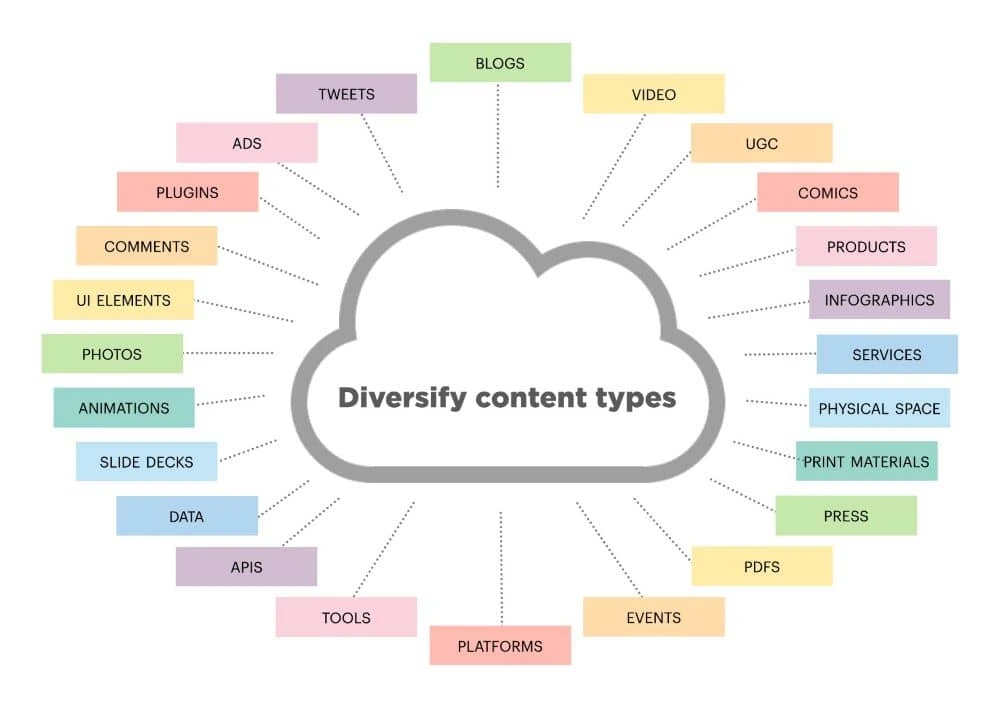
Source: iPullRank, lovingly recreated in Lucidpress
Content marketing is the act of using content to market your brand. With that in mind, the following are just a handful of content types that you can leverage for marketing purposes:
- Podcasts
- Webinars
- Social media posts (see templates)
- eBooks (see templates)
- Infographics (see templates)
Simply put, sticking to one type of content is a good way to bore your audience. No matter how valuable your blog posts may be, your readers will likely get tired of them at some point if you don’t change things up a bit.
Solution:
Your first order of business is to determine which formats will best engage your audience.
Some individuals devour podcasts on a daily basis during their morning commute, while others would rather read an eBook while relaxing on their couch at night. Still others might not have the time to devote to these ventures and would prefer to get quick-hitting information via infographic.
As you do when figuring out what your audience wants to know, it’s also important to determine how they want to receive this information.
Even though you’re going to create content in a variety of formats, that doesn’t mean you need to create completely new content for each. In other words, you can repurpose content you’ve previously created and present it through a different format.
You’ll definitely want to tweak the content so it fits its new platform, but generally speaking, the meat of the content will remain the same. For example, when repurposing a blog post into an infographic, you’d typically include only the hard-hitting facts and statistics mentioned in the article (leaving out the “discussion” parts).
By repurposing your most successful content in a variety of formats, you can give the piece maximum exposure across the customer segment it was intended for.
Not following up (or through)
In the intro, we set up a hypothetical scenario in which a content marketer creates a handful of blog posts, publishes them, then sits back and waits for business to start booming… and it never happens.
A big mistake many marketers make when starting out with content is living by the old adage, “If you build it, they will come.”
It just doesn’t work that way. With over 2 million blog posts being published every day, the chances of new readers just happening upon your content are practically zero.
But, even assuming you do generate some traffic to your new content, you still haven’t succeeded yet, and you can still miss out on major opportunities. Another mistake beginner content marketers make is failing to engage with their audience members after they’ve reeled them in. They also miss out on the opportunity to not only nurture these individuals through the buyer’s journey, but to learn more about their needs.
Solution:
The solution here is two-pronged.
First, focus on promoting your content. There are a number of ways you can do this, including:
- Sharing links via social media, adding relevant hashtags to the post
- Posting links in appropriate online communities, such as Reddit or Quora
- Engaging with influencers and bloggers who write about your industry to see if they’d be interested in sharing your content
Once you’ve gained some visibility and have begun seeing audience members engage with your content, don’t let them go. If they’ve left a comment on your blog, keep the conversation going; if they’ve shared your content on social media, shoot them a quick “thank you”; if they seem to be looking for more information, give it to them!
Technically speaking, once your content has attracted a potential customer, it’s done its duty. But the work you put into this content will be for naught if you don’t follow up with the lead as soon as you possibly can.
Key takeaway
It’s no secret that content marketing can be an effective way to attract highly qualified leads that have a good chance of converting. This is, in large part, why 92% of companies view their content marketing efforts as a business asset.
But if done haphazardly, your content marketing efforts can lead to nothing but wasted time, energy and money.
Before you dive into your next content marketing campaign, keep in mind that the purpose is not just to create amazing content, but to create amazing content that ultimately leads your audience toward conversion.
Learn how Lucidpress can streamline your brand’s content marketing and keep your whole team on the same page.
Think of some of the most iconic brands all time. What comes to mind? Nike? Apple? Disney?
Most likely you think about a logo, a slogan, or a general aesthetic that is unique to the brand. Whether sleek, futuristic or full of princesses, you should be able to conjure up some visual.
Related: How to maintain brand consistency in a sales organization
Why do these brands leave such a strong impression? Because they have been able to craft a consistent, creative message that sticks with you.
Any company will benefit from brand consistency in all touchpoints along the funnel. But before we talk about how they benefit, let’s break down what this really means.
What are the touchpoints?
According to Salesforce, consumers interact with 6 to 8 touchpoints just to get to sales in the funnel. That’s a lot of times to touch one brand before you commit to a conversation. And that’s only the top of the funnel.
As someone is transitioning from an unknown prospect to a customer (and an advocate), these are some of the touchpoints they encounter.
- Before purchase: website, blog, emails, social media, paid ads, public relations, sponsorships, event booths
- During purchase: website (again), local branches, delivery methods, e-commerce cart
- After purchase: customer support, knowledge base, customer surveys
- Bonus funnel: job postings, candidate communications
As you put effort into each of these touchpoints, you want your audience to connect the dots. This saves you time, effort and money down the road.
What do we mean by creative consistency?
The Oxford English Dictionary defines consistency as “the quality of achieving a level of performance which does not vary greatly over time.”
In a creative sense, that’s assuring your logos, design elements, messaging, tone and imagery stay the same from one touchpoint to the next.
This is often achieved by first implementing a brand style guide and templates across teams, then maintaining open lines of communication and support with other teams creating touchpoints.
Creative consistency means a level of work with your brand over time which does not vary greatly, such that people will recognize your brand from one interaction to the next.
Why is this important?
Creating a consistent brand image from one touchpoint to the next is important to for both psychological and economic reasons within your organization. It can help your company achieve the following results.
1. Makes your brand easily recognizable
Humans are hard-wired to look for patterns. Since the beginning of time, we’ve looked for patterns as a way to survive. We’ve used them to speed up our information processing, as well as look for dangers in our environment.
Creating a consistent brand helps people easily recognize and place your brand over time. It also helps people be more comfortable interacting with your brand along different touchpoints because they know what to expect.
2. Builds trust across channels
Have you ever gotten an email that just doesn’t look right because it’s different than what you expected? If so, it’s entirely possible that was a dangerous phishing email—and hopefully, you deleted it. Remember our reliance on recognizing patterns to survive? The same goes for building trust.
Since humans are hard-wired to look for patterns, we’re also wired to be suspicious of anything that deviates from the norm. Keeping your logos, colors and messaging consistent helps people see that they can trust your brand.
This goes double for any communications from your support and services teams. Since people reach out to those teams when they’re vulnerable and need help, creating a pattern of trust gives them reason to be comfortable working and sharing with your team.
3. Sets expectations with users
Have you ever clicked an ad for an article, only to find out the article was not what you expected to read? It doesn’t feel good for the user. How do you know you won’t be disappointed again the next time you click? Users want their expectations met as they click from one touchpoint to the next.
As users progress through your brand’s touchpoints, they’ll start to recognize each one as part of a larger picture. Everything you create will be part of that story. Creating consistency across everything from ad copy to messages from sales reps will reinforce the customer’s expectations as they move from one phase to the next in your sales process.
4. Lays a good foundation for content
Before you build a solid marketing plan, you have to start with a few building blocks—create some personas, map your customer journeys, inventory your assets and resources. Imagine how hard it would be to produce creative brand content when you’re missing those pieces.
To build an effective campaign, you have to know what imagery and messaging resonate, and what your audience expects to see. Do you have a quirky mascot, tagline or hashtag that you can build on? Then you can iterate on that concept’s success to tell a better story.
5. Promotes effective storytelling
One-off, single-channel interactions are out. Omni-channel, multi-touch processes are in. This is why we use techniques like ad re-targeting and marketing automation. As a marketer, you must connect the dots from one channel to another.
Consistency across these marketing touchpoints builds a story over time. They may not see the pieces all at once, but they will feel their cumulative effects. You’re more likely to respond to retargeting ads when the brand is one you recognize and trust.
6. Links everything together to create a single brand experience
Think of how much money you spend to acquire a single customer. Almost always, that acquisition is not done as a single event, but done over the course of multiple touches. Each of those touches costs money to create (either in dollars or in time). To maximize that investment, potential customers should feel these touchpoints form a single experience.
Don’t try to reinvent the wheel with every project or campaign. While we should always be improving and building better campaigns than the last, it helps to start with a consistent design, template or ad, rather than continuously spending time or bandwidth to re-design it.
Key takeaway
Building touchpoints with creative consistency leads to an effective, cohesive, trustworthy brand, and the more time your company can spend on the same page working towards that vision, the better.
Want to know more about the impact of brand consistency? Download our free 32-page report, chock full of stats & great insights.
If your real estate business is growing, it’s only a matter of time before you’ll need to reevaluate your marketing strategy. “Growing pains” are definitely real, and your agents will feel the squeeze as you try to scale your marketing efforts for larger audiences.
Related: Should you hire a real estate marketing agency?
When you find yourself at this point, it’s time to automate. Real estate marketing automation software will save agents time and help you reach and nurture leads more effectively. It handles many complex tasks that are either too difficult or time-consuming to do on your own. But like any software, it comes with serious considerations, such as cost and learning curve.
In this post, let’s go over what marketing automation is, how it can help your real estate business, and how to choose the right software for your brand.
What is marketing automation?
Marketing automation is the process of automating certain repetitive marketing tasks. It’s designed to support multiple channels, so your marketing efforts (and your brand) stay consistent across the board. Most marketing automation platforms support websites, emails, and social media.
Marketing automation use cases
Let’s go over a few examples. Here are some of the ways agents can use marketing automation software to work more efficiently.
Reduce cart abandonment. Imagine you sell products on your website. It could be branded merchandise, online courses, or real estate services.
Ideally, when someone adds an item to their cart, they will complete the transaction immediately—but, that’s not always the case. They may have been looking for more information, like shipping prices, before making their decision. Or, maybe they realized they can’t afford to pay today.
Either way, the result is an abandoned cart and lost sales.
Marketing automation software can help you capture this information and add this lead to your database. Then, you can target this lead with a follow-up email that encourages them to return to their cart and finish the sale. You could provide them with a discount, free shipping, or some other enticing offer. This email could be the key to persuading the buyer to complete the sale.
Nurture your blog subscribers. If you’re investing time and resources into content marketing, your goal is to engage an audience who may not be ready to buy today, but they will be in the future. Maintaining an active blog is a popular way to build an engaged audience of subscribers.
So, how do you move these people toward sales?
Real estate marketing automation can help agents set up email campaigns to nurture those blog subscribers. You can even divide your audience into segments and send them relevant, customized content—like local listings. Regular contact will keep your brand top-of-mind, so they think of you first when they need an agent.
Identify leads who are ready to buy. Sometimes, it’s hard to track all the leads in your system and prioritize the ones most ready to buy. You don’t want to miss a sales opportunity while it’s hot, so you decide to prioritize leads who’ve completed certain actions on your website.
But… which activities should you track, and how?
A good marketing automation program will provide reliable data on the actions that demonstrate high interest:
- Landing page visits (such as visiting your pricing page more than once)
- Email opens (like opening a demo email, but not clicking through)
- Lead scoring (assigning a number to a lead based on how many actions they’ve completed)
Based on this information, you can be confident that you’re reaching out to a real estate lead at the right time.
Benefits of marketing automation
Now that you understand what real estate marketing automation is and how it can be used, let’s review the benefits.
Marketing automation software saves time. Creating customized campaigns won’t take as long as it used to. Because your agents don’t have to spend time performing repetitive marketing tasks, they have more time to spend face-to-face with clients—closing more sales.
It makes your advertising more effective. Because marketing automation software uses data to make decisions, you can be more confident that your message is reaching the right people at the right time. From email automation to SMS messaging and mobile push notifications, this software streamlines a variety of marketing techniques, so agents can focus on getting the best results from each.
It makes marketing management easier. Before automation software, agents had to spend hours every week performing repetitive tasks and sifting through the data—introducing many chances for error. Now, a program can manage these things for you, and all you have to do is maintain and optimize your campaigns.
Lead gen best practices
If you’re interested in marketing automation for real estate, you’re probably already generating a fair number of leads. If not, you might want to get your lead generation efforts up and running first, so you can get the most out of your real estate automation software.
In either case, it’s never a bad idea to review lead gen best practices. What makes a good lead generating strategy?
Move leads down the funnel. Remember the classic customer conversion funnel? It describes the journey a buyer makes through the stages of awareness, interest, desire and action. For each stage in this funnel, you should have landing pages and content to match. For example:
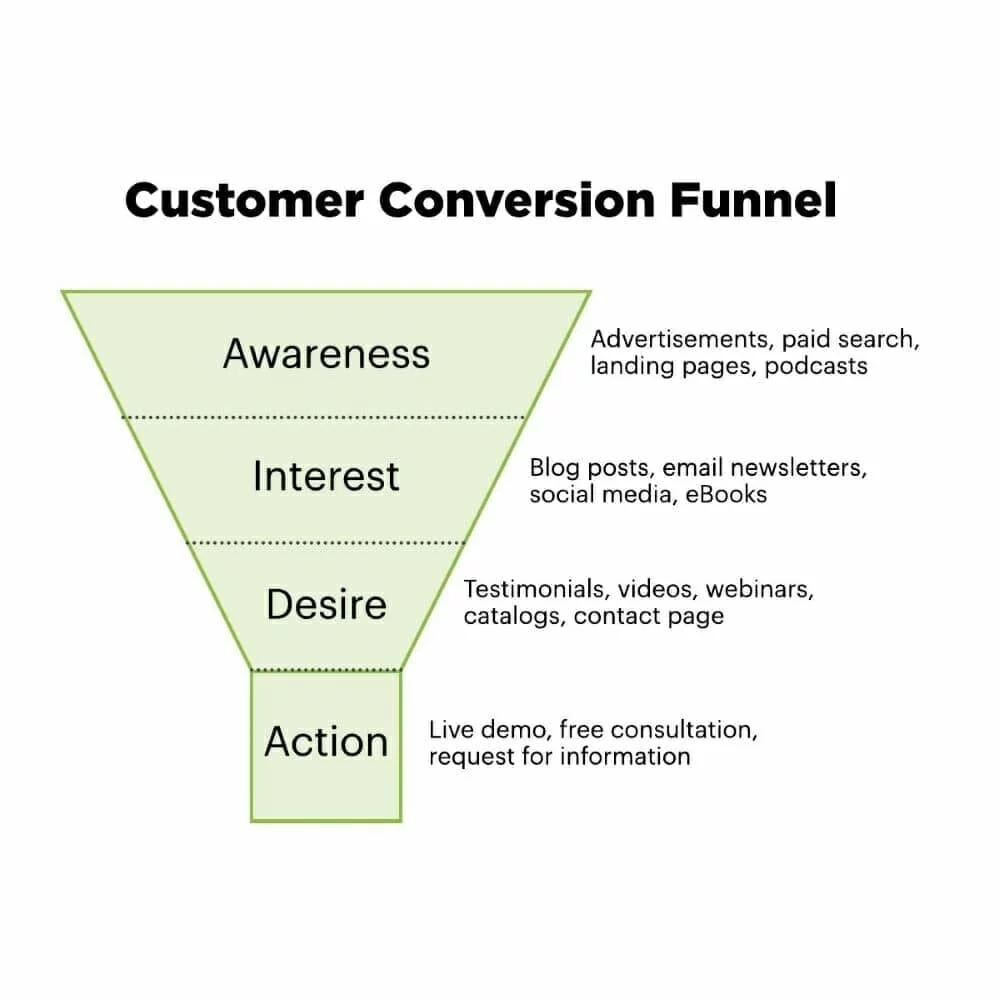
When you have all these pieces in place—and you use clear calls-to-action to connect them—buyers will move seamlessly through the stages with fewer obstacles and objections. Marketing automation software can help you manage and deliver that content, so your leads don’t get lost or go cold.
Build your own email list. If you’re just starting out, it’s tempting to purchase email lists. But when you buy a list of addresses, you’re getting the same tired list that many other agents have used before you. Bottom line—it will never be as effective as the list you build yourself.
Make it easy for people to subscribe to your blog and email newsletters. Put sign-up links on your website, blog and social media channels. Collect email addresses from clients and prospects you interact with, then add them to your email list. Offer incentives to sign up for your email (e.g. coupons, sweepstakes, listings info), and remind people about it both online and offline.
Because this list is targeted and unique to you, you’ll enjoy better open rates, click-through rates, and conversion rates.
Maintain brand consistency. It’s often said that a prospect requires 6 to 8 “touches” from your brand before they become a lead. These touches can come in the form of advertisements, listings, webpages, emails and social media posts—all different channels.
If your brand identity & messaging aren’t consistent, you risk losing and confusing your audience. That’s why brand management is so important. Make sure agents are all using the same brand assets (colors, logos, fonts) and messaging (voice, tone, offers). The consistency will help buyers recognize, remember and trust your brand.
Related: The complete real estate marketing guide
Which software do you need?
To figure out which real estate marketing automation software to use, you have to ask yourself a few questions. The answers will provide a rubric for evaluating all the options out there.
Am I using inbound or outbound marketing? Generally speaking, there are two types of marketing: inbound and outbound.
You can think of outbound as “push marketing,” where you push a message out into the world (e.g. advertisements) in hopes of attracting the right people to your brand. Outbound marketing includes:
- Print & broadcast advertisements
- Direct mail
- Paid social ads
- Paid search & display ads
Conversely, you can think of inbound as “pull marketing,” where you publish and distribute messages (e.g. web content) that interested buyers search for online. Inbound marketing includes:
- Blogging
- Organic social media
- Organic search
- Emails to your list
Which strategy do you use most often? In reality, most real estate brands will use a mixture of both. Outbound marketing is good for building initial brand awareness. Inbound marketing is good for driving qualified leads. Both can contribute to a healthy sales pipeline.
Determining what type of marketing you use the most can help you prioritize which automation software to consider. Some specialize in one or the other, and some cover both.
Which channels do I use (or want to use)? This question dives a little deeper than the last. Rather than thinking in broad categories, get specific about the marketing channels you want to automate.
Different software will specialize in different channels. Make a list of the channels that are “must-haves” and “nice-to-haves.” Your lists could include:
- Website actions
- Social media
- Content publishing
- SMS messaging
- Mobile push notifications
As you can see, the potential of real estate marketing automation goes far beyond email. But, not every agent will need all the bells and whistles. As management, it’s up to you to decide which features are most relevant for your agents. Then you can filter out the software that doesn’t meet your needs—or, perhaps, far exceeds them.
What tools do I need to integrate with? Chances are, you’re already using a slew of programs to manage your business. Marketing automation could replace some of those, but of course, not all. It’s important that your marketing automation software plays nicely with the other tools you’re using.
Linking your marketing automation software to other tools will increase its usefulness. They provide useful data your software can use to make decisions.
Examples of tools you could link to your marketing automation software:
- Salesforce (CRM)
- Microsoft Dynamic (CRM)
- Google Analytics (data)
- Kissmetrics (data)
- Facebook (social)
- LinkedIn (social)
- Eventbrite (events)
There are thousands of examples (just glance at Hubspot’s integrations page to get an idea!). Take a close look at which tools you could replace with marketing automation and which tools you’d need to integrate.
Related: Real estate marketing software that outperforms competitors like Imprev
Important evaluation criteria
It’s not just the software that you’re evaluating—there are other reasons to choose one program over another. Here are a couple of additional considerations.
Implementation and ramp-up. Setting up a new software is not an easy task, especially one as complex as marketing automation software. (Switching from one software to another can be even harder, as we learned here at Lucidpress when we switched from Hubspot to Marketo.)
Make sure you have a plan and a timeline for implementing the new software: importing data, connecting tools, adjusting code, and setting up initial campaigns.
Also think about the ramp-up. Which campaigns are absolutely necessary to get started? Which ones can you hold off or pause while you get up to speed?
There’s also adoption: Who needs to learn and use this software regularly? Make sure you have any training resources you need, and that all agents are on the same page.
Service and support. If something breaks or doesn’t work, who do you call? If you’re comfortable troubleshooting yourself—or if you have an IT person—you might not need additional support from your marketing automation provider.
But if you’re not, it’s worth asking about services and support. What’s included in your subscription? If your agents need more help or training, is there an extra cost associated with that? How responsive is their team? You can include all of these in your evaluation.
Marketing automation comparison chart
Now that you know what marketing automation is and how it could help grow your real estate business, it’s time to start evaluating providers. We’ve chosen a handful of software programs that are popular with real estate brands and compared them below.

View and download this table here.
To find out more about the 7 programs in our chart, visit their websites:
You can use this as inspiration to create your own comparison chart in Lucidpress, Google Docs or Excel. This will help you keep track of the marketing automation software you research, so it’s easier to make your final decision.
Your brand matters. Learn how to protect and elevate your real estate brand in this branding essentials guidebook.
A well-designed website is a valuable investment that will generate revenue for your business—but 38% of people say they won’t explore a site if they find it unattractive. If your website hasn’t been updated in a while, your web design could unintentionally be hurting your business by turning people away at the door.
If it’s time to refresh your website, we’ve put together a list of 10 website design best practices and coupled them with the do’s and don’ts of great web design. Follow these best practices as you update your site.
1. Target audience
- Don’t ignore the users
Always keep your target audience in mind. Your point-of-view, as a professional, might be very different from that of the user. Pretend you’re visiting your website with fresh eyes. Walk through the user’s journey as they explore different pages. Focusing on this experience will help you create a user-friendly website.
Good design addresses the target audience with a brand personality users want to engage with. Check out this website, Crypton. It’s designed ideally for a tech-savvy audience.

Source: Crypton
Parallax scrolling heightens the user engagement here, but you don’t have to include parallax functionality on every website. Research your buyer personas and use design elements, functions and colors that make your target audience feel right at home.
- Do optimize for search
Websites that don’t rank well on Google and other search engines have very little chance of breaking through the noise. As you update your website and add new pages, make sure you’re following the most recent SEO guidelines. Your page titles, meta descriptions, and content are all important players in driving better search signals.
2. Layout
- Don’t create a cluttered layout
Have you seen websites that look like rows of boxes—all different sizes and arranged haphazardly? Would you spend more than two seconds sorting through it? Probably not. That’s because cluttered websites are visually confusing; the viewer doesn’t know where to direct their attention. A well-organized layout, on the other hand, guides the viewer where you want them to go.
- Do create a focal point
So, where do you want your visitors to go? It depends on the purpose of your website. An e-commerce site will drive visitors to purchase, while a SaaS site might drive visitors towards a demo or a free trial. Whatever purpose your website serves, make it the focal point of your homepage.
- Do use catchy headlines and call-to-action
The first things that attract a visitor’s attention when she lands on your homepage are the headline and call-to-action. Not the contact info, articles or product specs, but these two elements. For this reason, the more action-oriented your headline and CTA are, the higher your chances of success rise.
CTAs are designed to incite an immediate response from a customer. That’s why clear, concise CTAs are more effective. One software company reported that their site’s conversion rate increased by 106% after it got a makeover that included a clear, direct call-to-action.
3. Color scheme
- Don’t use all the colors
Using too many colors will make your website design clash. Colors have strong psychological impact, and they will affect a viewer’s opinion of your brand. If you’re unsure how many colors to use, the rule of thumb says your design should not use more than three colors. If you’re working with a brand palette, you might be able to use more, as long as you balance them well.
- Do use color combos that enhance your content
Your website’s colors should reflect the brand, complement the content, and visually delight viewers. [] Avoid selecting random colors just based on what you like. Instead, think about the brand and its users. If you have a primary color but don’t know how to make color schemes, you can use an automatic color scheme generator to help fill out your palette.
4. Text placement
- Don’t fill the page with long paragraphs
Just like the layout, you don’t want the design to be cluttered with text. If you have long-form content on the website, create a clean, spacious design that divides the content into readable chunks. You can do that by adding ample white space, using images, and creating proper flow.
- Do make it easily scannable
If your pages are easy to scan, you have a better chance of luring readers to the bottom. Attention spans are short online, but if you can make your content easy to absorb, readers will get more value from it. In addition to high-quality writing, use headings, bullets, quotes and blocks to emphasize the essentials.
- Do establish trust & credibility
Potential customers are less likely to enter their contact information or make a purchase if they suspect that your website is not secure or trustworthy. Communicate your trustworthiness by featuring customer testimonials, case studies, reviews, security badges and your privacy policy. Make sure your contact information is easy to find so visitors know they can reach you. All of these signals will help you establish trust and credibility as a reputable brand.
- Do communicate your value proposition
Use compelling language to convince and show readers how your brand will add value to their lives or resolve their problems. What benefits can customers expect to enjoy by making a purchase or signing up for your service? What features make your products better than what your competitors offer? If you can excite your visitors with your value proposition, you will see your conversion rates improve.
5. Search & navigation
- Don’t make it hard for users to find what they need
Everything on your website should be easily searchable. Whether it’s the sign-up form, the “About Us” page, or your contact information, readers should not have to spend more than a few seconds finding it. To make things even easier, include a search box so people can find things that don’t align with the page’s primary focus.
- Do set up proper navigation
If your site requires users to sign up, use colors to make the navigation simple. For instance, if your navigation headers are blue, make your sign-up button green or some other color. Organize your content into categories that users can browse if they like. You can also organize content on various hub pages.
With good UX, your website tells the world that you think clearly about the end user. See Crunchbase’s website; its UI is done beautifully. There’s the search bar on top if you want to explore specific results, or you can click the menu on the left side to browse sections that interest you.
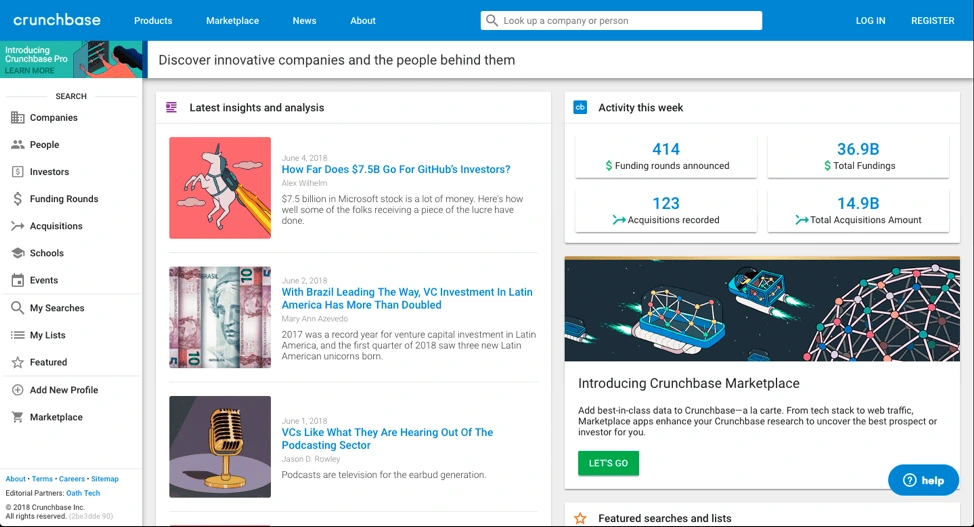
Source: Crunchbase
6. Fonts
- Don’t use too many fonts
A website that uses five different fonts loses users in seconds because it takes too much effort to read. Too many fonts on the screen can make a website look chaotic and unprofessional. The ideal number of fonts is three: one for main headings, another for sub-headings, and the third for the body text.
- Do select the right font sizes
Font size has a huge impact on legibility. It’s important that they’re neither too big (taking up half the page) nor too small (uncomfortable to read). The sizes of your fonts should reflect the importance of each element. For example, section titles and taglines are more significant than the body text, so they’re bigger. This helps readers scan the content, too.
7. Images
- Don’t use too many images
Too many images will crowd out your message, so use them sparingly and impactfully. Remember, search engines can’t read images very well, so don’t rely on them to convey text. If you’re using a background image, keep it under 1 MB. Large images slow down your site’s loading time.
- Do make it visually attractive
People think visually, which is why images are so effective. Feel free to use images in your web design, but find ones that are visually attractive, high resolution and not pixelated. Make sure the images you use reflect your brand’s personality. Don’t forget that you can also use textures and gradients to add visual appeal.
8. Mobile compatibility
- Don’t forget to optimize for mobile
57% of mobile users won’t recommend a website that’s not optimized for mobile. More people are browsing and shopping on mobile devices, and they expect websites to provide great mobile experiences. Invest in responsive or mobile-first design so you don’t miss customers during crucial moments.
- Do test for functionality
It’s not enough for your website to look good on mobile—it needs to be fully functional as well. Give your mobile users the tools to get things done, such as product search, store locators, service details, and more. If you can seize these opportunities, you won’t lose customers who are searching on the go.
- Don’t compromise on speed
People are not patient, and slow-loading webpages will almost certainly lead to a higher bounce rate. If your page takes longer than five seconds to load, it’ll frustrate your visitors and give them a reason to search elsewhere. To increase the loading speed of your webpages, consider removing any nonessentials, such as videos or large images that take extra time to load. Compressing images will also reduce loading time. Finally, utilize browser caching for storing cached versions of static resources to speed up your pages significantly.
9. Conventional vs. unique design
- Don’t ignore the power of convention
People are used to certain structures and formats on the web. This familiarity makes it easier for the brain to absorb content and make decisions. Your visitors shouldn’t have to be detectives to figure out who you are and what you offer. The power of traditional web design is that users will understand what your website is about with a single glance.
Your above-the-fold section should do the job
A Nielsen study says the majority of your website visitors will spend 80% of their time above the fold. That’s the section you see without scrolling—call it the opening screen.
The best websites explain what they do in this opening screen. A general practice is to use a headline (think your company’s tagline or mission statement), followed with a brief subtitle text describing your services or products. Top it off with a CTA button to direct visitors toward the next stage in your conversion funnel.
Airbnb does this brilliantly; the headline is the CTA. While there’s no subtitle text, their call-to-action is strengthened by a slideshow of awesome travel photos. Just beneath the headline, a search bar is intuitively placed. The example text in the search bar encourages interaction.
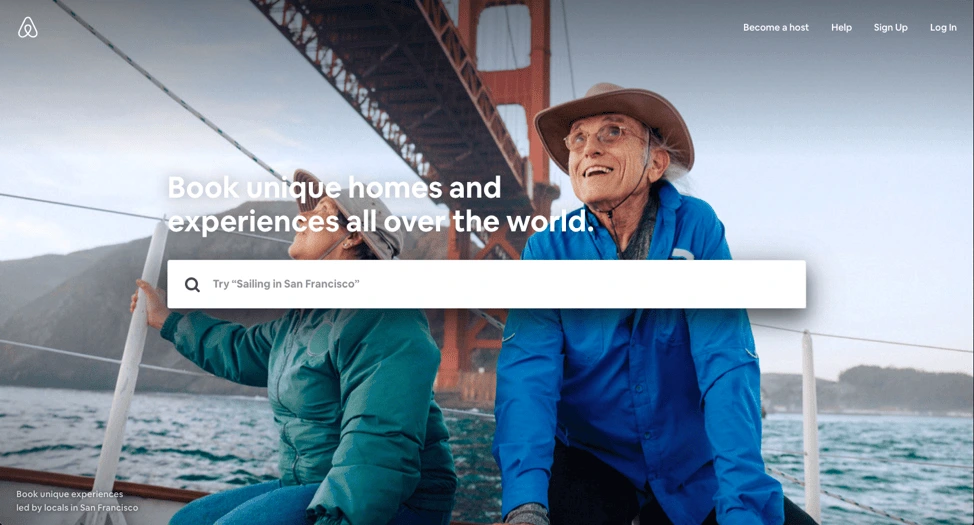
Source: Airbnb
- Do use floating menus
It’s very frustrating for users to have to move all the way to the top or bottom of a page to navigate the site. What many websites have now are floating menus: menus that move along the top or side of the screen as you scroll, making navigation a lot easier.
AMD, a giant in the computer hardware business, uses floating “share” buttons that visitors can use to share the content they find interesting across a variety of social sites like Twitter and Facebook. This helped AMD drive a whopping 3600% increase in social sharing, as more and more people found and shared their pages.
- Do be creative & unique
Still, you do want your brand to stand out from the crowd. Be creative, and use elements that make your site unique without disrupting the flow of information. Whether you experiment with moving images, video, or other design elements, try different things and monitor the results. You might be surprised what works.
10. Test it out
- Don’t forget to take it for a test drive
Once you’re done designing the site, test it to make sure everything is working correctly. Use multiple devices to navigate your website and see if it’s doing what it’s supposed to do. A user’s experience can vary depending on device type, internet browser, and location. Try to recreate different scenarios so you can catch any bugs or performance issues before they do.
- Do think like a CEO
A successful web designer needs to think like a CEO as well as an artist. This will help you view the website with business strategy in mind. Critical evaluation will give you a site that looks good, is user-friendly, and helps the business reach its goals.
Ready to design? Try Lucidpress today to create professional, compelling graphics for your brand’s website.
When you send out direct mail to prospects in real estate, it’s inevitable that you’re going to get calls from seemingly unmotivated people. If you’re not drawing motivation from your leads, then your competition will be converting your leads instead of you.
Related: How to follow up your real estate direct mail campaigns
Based on the process I use for my own business, this article will teach you how to answer calls from inbound leads and how to handle appointments.
Follow a call frame
A lot of gurus will provide everyone with a script, but if you’re following a script and the conversation steers away from it, you’re going to sound salesy and unnatural to your leads. You need to have a frame to work with rather than an exact word-for-word script, because the nature of your calls will be dynamic.
We follow a call frame that looks like this:
- Set your time frame.
- Set your agenda.
- Determine your outcome.
This makes your conversations feel more natural, giving you room to implement strategy as the opportunity occurs (instead of trying to bend the conversation to your will).
Set your time frame
Whether someone calls you in response to your direct mail campaign or you’re just returning their call, the prospect has no idea what to expect. Our goal is to inform them, so we put them more at ease.
Of course, sometimes the timing isn’t ideal. What if your prospect was taking a break at work when they called you, and by the time you call back, they’re hiding in their cubicle and whispering to avoid being overheard? You won’t be able to take them through the entire sales process on the call, cutting yourself short.
To avoid being cut off, we always begin the call by letting them know it should only take about 5 to 10 minutes, and we make sure that works for them. Most of the time, it does. On the rare occasion that it doesn’t, we schedule a time to call back when they’re able to talk. We want their full attention—so they aren’t focusing on when they have to get off the phone.
An example of how this introduction might sound:
“This call will take me 5 to 10 minutes to answer all of your questions, ask you some of our own questions about the property, and explain what the process will be moving forward if we decide that this house would be a good fit.”
Set your agenda
Along with setting the time frame, the introduction needs to tell the prospect what will be happening on the call. Remember, they don’t know what to expect. Most likely, they’re on guard.
We set the agenda of the call by acknowledging that they probably have a few questions for us, assuring them that we will answer their questions. We add that we have a few questions for them, and that if we are a good fit for them, we’ll proceed to the next step in the process.
When you set an agenda with your prospect, you’re building credibility and trust. You’re handling the call in a professional manner that sets you apart from your competition—especially when they’re getting handfuls of direct mail saying “We buy houses.” We’ve gone to appointments where homeowners had stacks of direct mail from real estate investors. Going the extra mile to build trust will definitely help you stand out.
Acknowledge their questions
When you mention that you’re aware they probably have questions, you’re giving them permission to ask all the questions they want. After all, selling a house to an investor is a big deal.
People traditionally sell houses through a realtor, which can take months to close. With an investor, it could take only a couple of weeks. There are lots of questions lingering in a seller’s mind, and they deserve to ask and be reassured that this is right for them. Transparency will only help you.
Inform them of the next step
Near the end of the call, we usually know whether or not it makes sense to move forward. This is where you remind them that, if this isn’t a good fit, it’s totally okay to say no. People love being able to say no because it gives them a sense of freedom and comfort in the process. They know that you won’t pressure them if they decide this isn’t the route they want to take. Once you take the pressure off, you can really dig into the motivations of the seller.
“If you’d like to get our best offer on the property, we’d have to come out to see it and verify that the conditions match our repair estimates. The appointment should only take 30 minutes to an hour. We’ll just walk through the property and check out the condition. After that, we can make you an offer, down to the penny. If that works for you, I can schedule the appointment for Monday at 1 p.m. or Tuesday at 9 a.m.”
Determine the outcome
Do you ever find yourself hanging up the phone with an inbound lead, wondering how the phone call went? Determining your outcome on the phone and setting expectations provides clarity on what you need to do next in the process—whether that’s determining it’s a dead lead, dropping them into the follow-up process, or going to an appointment.
So, you’ve determined that the prospect needs your services while on the phone. You’ll want to explain what the process looks like at the appointment. This includes how long it takes, what you’ll do at the property, when they can expect to receive an offer, and what their options are. After explaining this process, set the appointment. Now you and the homeowner have a clear idea what’s going to happen next.
If you determine that your services don’t align with the homeowner’s needs, then explain to them that you don’t want to waste their time and you don’t believe you’re the best solution for them. Always genuinely offer to point them to a service provider who could help them. Offer your network of real estate agents, property managers and contractors to see if you can help them further.
Determine their motivation
The goal of any call with a prospect is to determine their level of motivation. One way to gauge this is to “go negative.” This simply means to pull back from them throughout the conversation.
The analogy goes that, if you chase a dog, they will run away. But, if you run away from a dog, they will chase you. Going negative will help you determine if the person is a legitimate lead, meaning you’ll know whether they have a problem your company can truly solve. Simply put, you just act a little less interested in your prospect to see if it makes sense to do business together.
Examples of going negative:
- “It seems like a great property. I’m not sure why you would want to sell it.”
- “It seems like this property would make a great rental. Have you considered just keeping it and renting it?”
- “It sounds like you’re looking for top-dollar on the property. Have you considered listing it with a realtor? It’ll take a little longer, but you’ll get the most money.”
There are two benefits to using this strategy. One, you’ll flush out all the normal objections a potential seller could have by bringing them up first (prompting them to justify why that won’t work). For example, you might hear something like, “No, I hate working with realtors. I just want to sell it and be done with it.”
Flushing out the objections will clear a path for you. As investors, we have to make lower offers so that we can turn a profit for our business. If you don’t flush out the objections, you will get responses like, “You know what? That’s a little low. I think I’ll just keep it as a rental or list it with a realtor.” After you’ve flushed out these objections, they can’t use them anymore. They just told you they didn’t want to keep it, rent it or list it.
The second benefit is that you determine their motivation. Sometimes, we cover so many objections that sellers just say, “I don’t want to do any of this. I just want to sell it to you guys and be done with it. Give me an offer.” In the seller’s mind, you’ve become their best option.
“Just give me an offer.”
We encounter it daily. People will put on their negotiation mask and demand an offer over the phone. When we started up our business, we’d always try to justify why we need to see the property to verify its condition. It hardly ever worked.
So, we switched up our approach. When someone demands an offer from us right away, we ask, “Would you rather have an offer, or would you rather have our best offer?”
The obvious answer is that they want our best offer. At this point, sellers usually quit hassling us about getting a quick offer. We explain that, to make an intelligent offer, we need to see the property and make a list of repairs needed to get the offer down to the penny. This flushes out people who are simply shopping offers, and it saves your company time and money when you avoid them.
Key takeaway
Now you have a call framework to draw out motivation from your direct mail inbound calls. Don’t get caught up in the nitty-gritty of a script. Instead, focus on getting your prospect’s guard down, setting expectations, going negative to gauge their motivation, and setting an appointment with them.
Want more great tips on how to set up real estate marketing campaigns? Check out our comprehensive real estate marketing guide for ideas & inspiration.
If you’re among those who think email marketing is too old-school to be effective these days, you’ve got the wrong idea. Email marketing is still a powerful tool that can help your brand shine.
Related: 8 tips to get more responses to your email marketing
What makes email so effective is the fact that it’s a permission-based marketing channel, one that gives you a chance to reach customers in a personal place—their inbox.
When a prospect signs up for your emails, they’re expecting a welcome email that introduces them to the brand. As this is the first email your subscriber will receive after being added to your email marketing list, it’s crucial to do it right.
9 best practices for your welcome email
1. A timely introduction
Your new subscriber wants to know more about your products & services at the time they sign up for your emails. Take advantage of their interest by sending out a welcome email as soon as they sign up. If you miss out on this opportunity, there’s a real possibility that the subscriber will forget about you and lose interest in your brand.
2. Crisp subject lines
All the work you put into crafting an engaging email will be for naught if your email doesn’t get noticed in a crowded inbox. Add an extra zing while crafting the subject line for your welcome email.
To make your email feel more personal, try using personalized subject lines. People are attracted to their own names, so this will lead to higher open rates. Here’s an example from Google:
Subject line: Smiles Davis, Welcome to your Google Home Mini

3. A pleasant greeting
Greet your new subscribers with a warm welcome email that’s personalized to their interests and preferences. Even when you’re sending automated emails, you can write them in a way that feels personable and real—like they’re coming from a human being and not a robot. Consider using an employee’s name and picture, so subscribers can visualize who’s behind the emails they get from you.
4. Guiding them through the next step
Making your customers wait too long isn’t good practice. You’ll have far better results if you intentionally build brand loyalty and guide customers through the purchase process.
For example, if you’re an online cosmetics brand, tell them why they should choose your brand over the many other brands in the market. Give them an overview of your products and how they can browse your app or website to find the cosmetics they want. If there are other actions you want them to take, spell those out as well—like in this example from nDash.
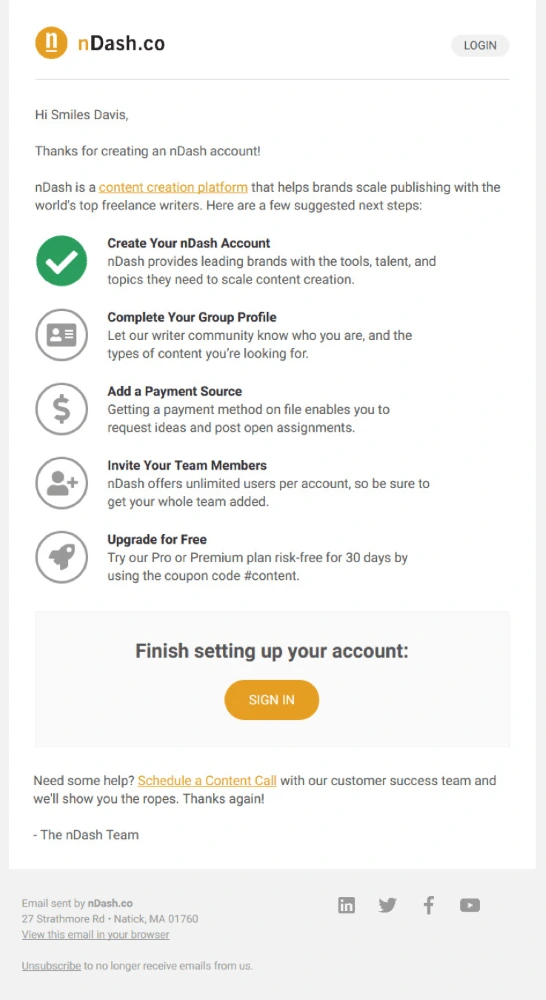
5. Include freebies in your welcome email
This is your chance to win over new subscribers with low-cost goodies. People love free stuff, so this will endear your brand to them right out of the gate. If you can’t afford to give away items for free without a minimum purchase, consider including a discount or promotion instead—such as a percent-off coupon or a buy-one-get-one promo code.
6. Hit two goals with one email
According to email marketing best practices, it’s recommended to include links to your social media profiles in your email. Ask them to like or follow you on the platforms you use most.
This is an especially clever move for e-commerce brands, since they need a strong audience to build their reputation and provide social proof. Even if you’re not an e-commerce brand, you can build buzz and loyalty by directing subscribers to your social channels.
7. Ask to be whitelisted
Being whitelisted can enhance your deliverability rates and make it easier for subscribers to find your emails in the future. It also helps to keep your emails out of the Spam folder. See how Travelocity asks people to whitelist them in the section titled Subscription Information:
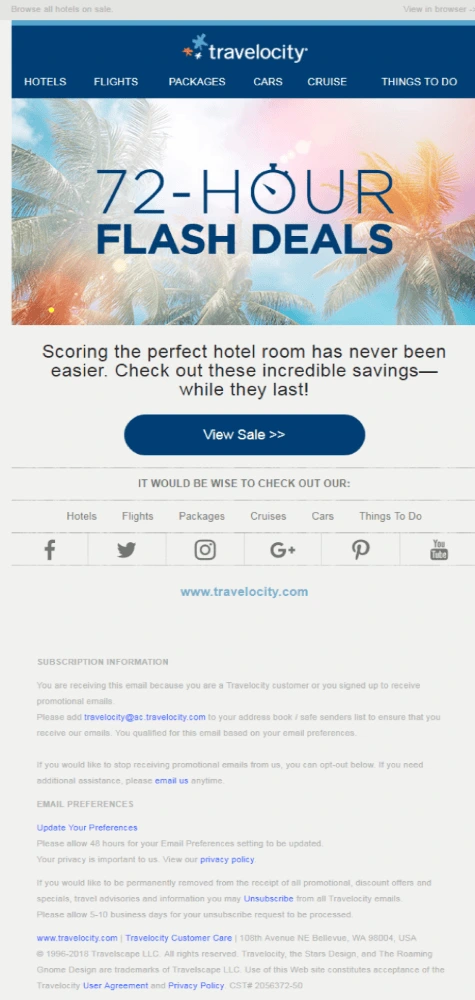
8. Give them a way out
You should always give your customers the option to unsubscribe from your emails at any point. By doing so, you’ll retain genuine subscribers in your list—people who are actually interested in reading your emails. In turn, your engagement metrics will rise, because you’ve eliminated those who aren’t interested in purchasing from you. (Also, unsubscribes are always better than spam complaints.)
9. Include free shipping
For e-commerce brands, one major obstacle your subscribers face while shopping online is high shipping charges.
Ease that friction and encourage first-time buyers by offering free shipping on their first order. Try mentioning it in your welcome email to delight your new subscribers. Creating a happy customer at the onset goes a long way toward building loyalty for your brand.
Mantras to keep your welcome emails engaging
- Pin your top content
Play your cards right with a welcome email that features your best content and gets them excited about your brand for the long haul.
- Avoid no-reply
Do not send your emails with a no-reply email address. It feels impersonal, and it’s important to assure your subscribers that you’re listening to them. They should know there’s a person behind the email ready to hear their problems and feedback.
- Make it compelling
Make your email compelling with content. Welcome emails should catch the subscriber’s attention from the moment they open it. If you’re struggling, try adding a dash of fun or humor to your email. Include interactive elements like GIFs, accordions, cinemagraphs or videos to make it more visually appealing.
- Build anticipation
Create a sense of anticipation with your welcome email. Don’t spill all the beans right at the beginning. Each email should leave the subscriber waiting for the next one. Find a way to highlight your best content and maintain curiosity in your subscriber’s mind so they look forward to hearing from you.
- Try a welcome email series
Instead of just sending one email for the sake of formality, consider sending 2-3 welcome emails as a series to initiate your subscribers. In a welcome series, you can introduce and explain different pieces of your business and entice subscribers to purchase from you.
- Write accessible emails
With one billion people in the world living with some form of disability, it’s incredibly valuable to write accessible emails that can be understood by everyone who receives them. Think about all the ways people might interact with your content—for example, different devices and browsers. How does your email sound when it’s read out loud to a blind audience? What does your plain text email look like? When your message is more inclusive, you have a wider audience to nurture.
Key takeaway
Welcome emails are an excellent opportunity to introduce subscribers to your brand, encourage purchases, and lay the foundation for loyalty down the road. Make sure you include all these essential elements in your welcome emails to set your brand up for success.
Kickstart your next email marketing campaign with our free newsletter templates.
Since 2008, real estate has gone up by an incredible 11.4% and created a fantastic opportunity for real estate agents to sell more clients.
Millennials will quickly become over a quarter of the real estate market, and only 1% of those millennials didn’t search online while looking for a house. Just one percent.
Related: How to handle inbound real estate leads
The internet has forever changed the way real estate agents get leads for their business, and you’re definitely behind the curve if you haven’t optimized your website for lead generation.
How do you generate real estate leads online? In this guide, you’ll learn various methods for obtaining quality leads online and the secret to converting your website into a real estate marketing machine.
Let’s get started.
1. Social media
If you’re not a frequent user of social media, it’s time you got started. Most people have a Facebook account, and many are active users on Instagram as well.
Instagram in particular is a fantastic avenue for sharing high-quality images and videos of properties and advertising your latest content (e.g. blogs & newsletters) effectively. By engaging with different channels each day and adding value to others, you’ll begin building a devoted following online.
Lots of real estate agents don’t do social media because they lack time for it. But with tools like Buffer and Hootsuite at your disposal, you only need an hour to set up a whole week’s worth of posts. All that’s left is checking the comment threads and responding whenever you have a few seconds throughout the week.
Read more about social media for real estate: How to build a social media campaign for real estate
2. Website
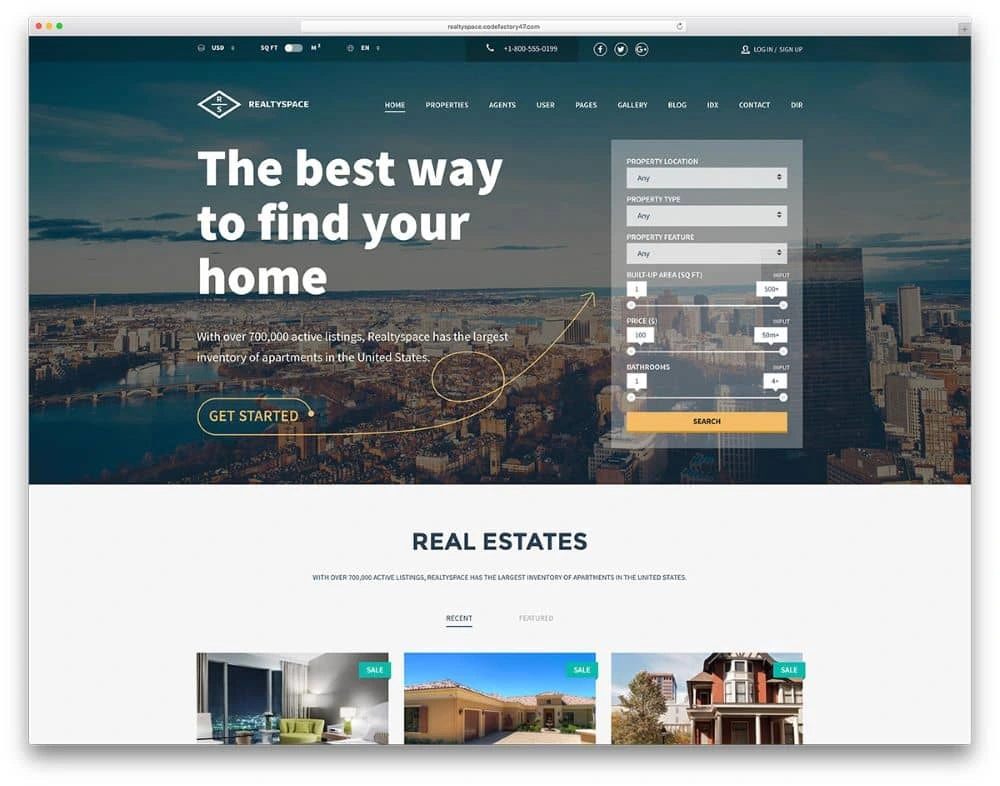
Source: Colorlib
If optimized properly, your website could be the foundation for attracting real estate leads online. It gives you the ability to provide value to your target market and help them engage with your brand.
Many real estate agents make mistakes in this area, and your website is not the place to describe your greatness in detail. Make your copy about how you’ll add value and better the lives of your customers.
An easy way to check whether your website is focused on your target market is to count how many times your site uses the word “we.” Customer-focused websites will use the word “you” more often.
3. Newsletter
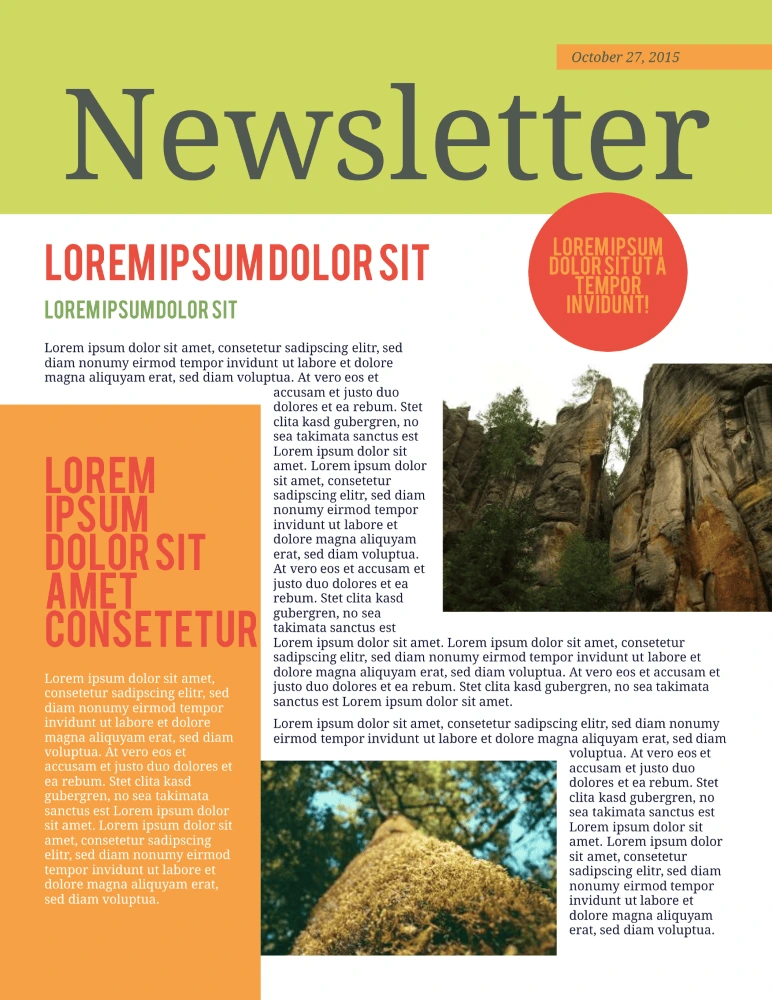
See more newsletter templates from Lucidpress
It’s always a good idea to keep your name top-of-mind, and a newsletter is a great way to do so. Newsletters can share real estate news, recent listings, and tips to deal with typical homeowner struggles—like preparing your house for the winter.
A newsletter is especially useful if your leads live in urban areas. Cities such as San Francisco, Los Angeles and Chicago are massive and busy, so it’s easy to miss out on events if you’re not paying attention. It’s also an excellent opportunity to inform subscribers about the latest news and events in their area.
Read more about newsletters: 13 best newsletter design ideas to inspire you
4. Blog
Blogging is one of the most popular and effective ways to generate leads online. But like any lead-generating tool, it has to provide great value to your target market. A blog post about the staff holiday party is not going to get the leads you want.
The best information to share with your target market is actionable. This could include topics like making a down payment, picking a lender, listing their home, and working with a real estate agent.
Free advice will grow your influence and make you a valuable resource—so when someone needs to sell or buy a house, they’ll think of you first.
Read more about blogging for real estate: How to use content marketing in real estate
5. SEO
The first page of search results has only ten slots. 33% of the people searching will click on the first result. 18% will go a step further and click on the second result. The further down the page you go, the fewer clicks there are—only 4.4% click on the sixth result.
That’s why every business wants to be on top. The lower you are, the harder it gets to attract your target market’s clicks.
The ideal SEO strategy is about finding the best keywords (and phrases) to target, then using them deliberately in your content to attract the customers you want. SEO powerhouse Moz has lots of free resources and tools to help you get started.
6. Video
If seeing is believing, then showing off the fantastic features of your properties is a surefire way to win converts—and there’s no better way to do that than with video.
Videos empower your potential clients to take a guided tour of your properties. They’ll be engaged by your content, but more importantly, they’ll be motivated to reach out for more information.
A video is far more than just a slick way to show off a property. On average, an online video converts 33% of leads. If you want a more captivating way to connect with your target market, video marketing is a great way to increase interest in your properties.
Read more about video marketing for real estate: How to create stellar videos for real estate listings
7. Influencer marketing
Connecting with others in your industry is always wise, and doing it online makes it easier than ever. You can share and amplify each other’s work through social media and comment on posts each of you publish.
Influencer marketing takes this one step further. It starts by figuring out who your target market is—specifically. Then, you can find influencers who are popular among the folks you want to target. By partnering with these influencers on advertising campaigns, you can reach wider audiences and attract more people to your brand.
Read more about influencer marketing in real estate: 5 influencer marketing strategies for real estate
8. Mobile optimization
Industry professionals often spend tons of time and money making sure their website is professional and easy to use… then forget to check how it looks on a smartphone or tablet.
Mobile search has surpassed desktop search, so it’s more important than ever that your website works with mobile devices. (Google is going as far as penalizing sites that haven’t created mobile-friendly layouts.)
Make the switch. Not just to protect your website from Google, but to impress customers who encounter your brand exclusively via mobile device. Aim for the same goals as your regular website: clear copy, attractive design and intuitive function.
Want to go even further with mobile? Read more about using mobile text messaging for real estate: 5 steps to build out your real estate mobile text messaging strategy
9. Referrals
When you start off as a real estate agent (or in any field, really), you won’t have a network. So, it’s up to you to build one.
As you begin to deal with customers, don’t forget to ask for referrals. Encourage them to share your name with others—make it easy and worthwhile for them to do so. Whether it’s to their friends, family or coworkers, advertising by word-of-mouth is powerful. People are more likely to follow recommendations from people they know than an anonymous review online.
10. Retargeting
Although we covered social media all the way at the beginning of this guide, we left out one element that deserves its own section: retargeting via Facebook ads.
Facebook ads are not a popular method of advertising in real estate circles, despite how high the ROI can be. Here, retargeting simply means that people who have shown interest in your brand will see your ad again. This “interest” is measured by actions such as reading your blog posts, clicking on one of your ads, or even signing up for your newsletter.
Your conversion rate will improve if you target people who want what you’re selling. People who are actively interacting with your brand are more likely to buy than those just scrolling through their feeds. Retargeting keeps your brand top-of-mind for the folks who matter most.
Key takeaway
Leads don’t just magically appear in your inbox. You need a strong lead-generating strategy that helps you cultivate interest in your brand and set you apart from the competition. These tips should get you on the right track to generating real estate leads online.
Hungry to hear about the best marketing practices for real estate? Hop over to our real estate marketing guide for more ideas & inspiration.
Open source learning. A global economy. Shifting demographics. These are just a few realities impacting your college recruitment strategy.
According to the National Student Clearing House Research Center, Spring 2018 college enrollment across U.S. campuses was down from the previous year. University and college recruiters have shifted to overdrive in response.
Related: How to improve higher ed student retention
Some focus on radio ads, alumni referrals and online recruiting fairs. Others build interest on social media and at live events.
Regardless of the outreach method, one thing is clear: In today’s higher education landscape, recruiters must be increasingly creative and strategic to attract new students.
A varied college recruitment strategy
“The times, they are a-changin’,” sang Bob Dylan. Want to keep up? Pay attention to your audience.
Today’s students don’t want a cookie-cutter version of their parent’s university experience. They’re also not impressed by (pun alert) old-school marketing tactics.
Instead, create a varied strategy that will reach your top prospects on multiple channels. Essentially, you want to provide engaging information that helps your college sell itself.
Use multi-channel enrollment marketing
Most colleges and universities know their target demographic well, and they market to basically the same audience year after year.
However, success also depends on reaching new targets via a multi-channel approach:
- Website — a branded, responsive hub that’s easy to navigate and engaging to use
- Blog or vlog — where interested prospects go for bite-size information
- Social media — critical online outreach, both locally and internationally
- Email campaigns — important tactic for lead generation and nurture
- Direct mail — still relevant and effective marketing for certain audiences
- Phone calls — an effective, if time-intensive, method for personal outreach
- Brand ambassadors — relatable outreach by faculty, students & alumni
- Parent outreach — critical influencers of your target audience
- Campus visit days — highly successful recruiting events, up close and personal
- High school visits — successful outreach that meets students where they are
- College fairs — key events that can market your institution both off and online
- International markets — a growing segment of your target audience
Now, for a few of the most helpful enrollment marketing strategies…
Recruiting college students online
It’s no surprise that most prospective students live online, particularly on mobile technology.
So, today’s recruiting strategies must be mobile-friendly. End of story.
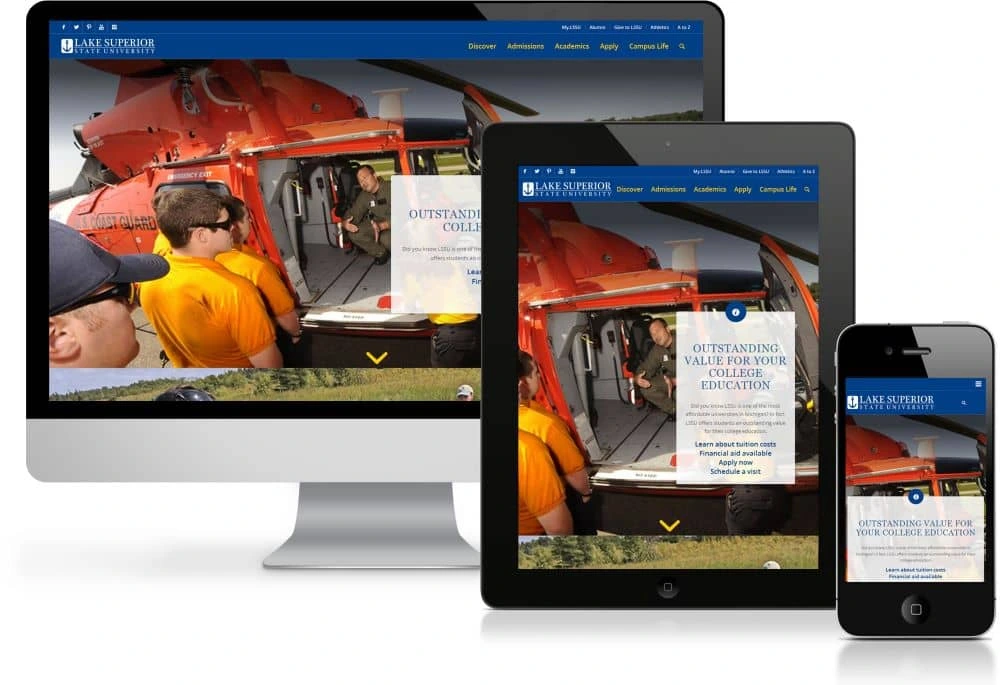
Source: Lake Superior State University
Responsive web design is no longer optional. But, you’ll stand out even more by offering mobile-friendly instruction and interactive pages.
For instance, students are wondering what they’ll learn on your campus. Why not show them instead of tell them?
Continuing education is common enough. But, standout institutions are experimenting with AR, game-based platforms and social learning models. Just one interactive feature on your site can put you ahead of the curve.
Even without all the technological bells and whistles, you can still provide value to new recruits.
Offer valuable resources
Don’t just throw a bunch of content on your website and call it good. Instead, create a user-friendly path that puts visitors at ease.
Which resources are clicked on the most? These might include:
- A catchy, above-the-fold video
- A listing of popular majors
- Programs and career opportunities
- Student and alumni testimonials
- Admissions deadlines
- Financial aid information
- Data-rich infographics
Simplify the application process
Of course, what you don’t include on your homepage can be equally important.
Generally, anything that simplifies your navigation and motivates would-be students to apply online is a good thing. Often, it means including more white space in your webpage design.
Face it—applying for college can be a daunting task even for the initiated. So, a user-friendly interface is essential.
Why not include a pithy video tutorial or a colorful step-by-step checklist to make the application process less painful?
Also, non-traditional students (e.g. adult learners, international students) generally want to know about credit transfers, flexible course listings, and financial aid options.
Build your blog
Most colleges today have a blog. What about your college?
More importantly, does your blog cover the topics your prospects care about most?
Boston University’s blog regularly shares pithy thoughts and videos by faculty members.
Likewise, Cornell University publishes “life on the hill” posts that help wannabes sample current students’ daily academic routines.

Source: Cornell
Your blog might also feature guest posts by alumni, video tours, listings of popular courses, and user-generated content.
And of course, the most popular blog posts should factor into your upcoming email campaigns.
Direct interaction with prospective students
As you can see, a successful recruiting strategy contains many moving parts. But, personal interactions (phone calls, campus visiting days, etc.) are still the most powerful of these.
According to Hanover Research:
“Despite increased digital activity, a recent survey found that the most effective marketing strategies for universities are nevertheless events‐based and involve direct interaction with potential students.”
After all, sometimes it really is about your newly upgraded facilities, swanky campus and student perks.
Most prospects who’ve gotten this far already know about your tuition costs, financial aid options, and faculty-to-student ratio. A successful campus visit just helps close the deal.
International student recruitment
Quick—what’s the Chinese version of Twitter?
If you’re recruiting students from China, you already know the answer to this question. (It’s Weibo, by the way.)

Source: Statista
As you can see, international student recruitment is alive and well at American colleges and universities.
As discussed earlier, your website needs to be user friendly and easy to navigate. This is particularly important if you’re appealing to international students.
Your site should help this target demographic understand the advantages of studying in America—and at your institution specifically.
Simple videos and infographics can also help smooth potential cultural barriers.
Do you already feature international students in your recruiting videos? If not, now’s the time to help them share their story—in their language.
As appropriate, include video links in your email campaigns. Share these on international social media channels.
Your website should also include pages dedicated to the specific needs of international students and recruits.

Source: Cornell
Reduce educational jargon
Higher education is adrift in educational jargon, which can be painful even to American-born students.
All those acronyms can be excruciating to international applicants. Whenever possible, cut them out and use a simpler description.
In the end, remember: Every positive interaction with a brand depends on clear communication.
Key takeaways
Now that you’re familiar with what it takes to build a successful recruiting strategy, let’s wrap things up by considering the real-life example of Western Colorado University. WCU’s creative team struggled to manage their recruiting strategy and materials, as they were too busy trying to keep their head above water.
Read Western Colorado University’s full case study here to learn how they dealt with their recruiting and marketing problem.
Is your school delivering a strong, consistent message with its brand marketing? Learn more in our free ebook: Branding in student recruitment
You already know that sales collateral can help your sales reps close leads much faster. They speed up the sales process by offering prospects the information they need to make a buying decision.
But, which types of sales collateral should you use? And most importantly, which ones convert best?
Related: What is sales enablement and why it matters
Let’s find out—and let’s go over the top three tips you need to know if you want to get the most out of your sales enablement content.
Here are some of the best types of sales collateral and how you should use them.
Blogs & ebooks
Let’s say you want to make a brochure to promote your business. You google around for a tutorial, and you land on our blog, where we have a step-by-step tutorial to show how it’s done.
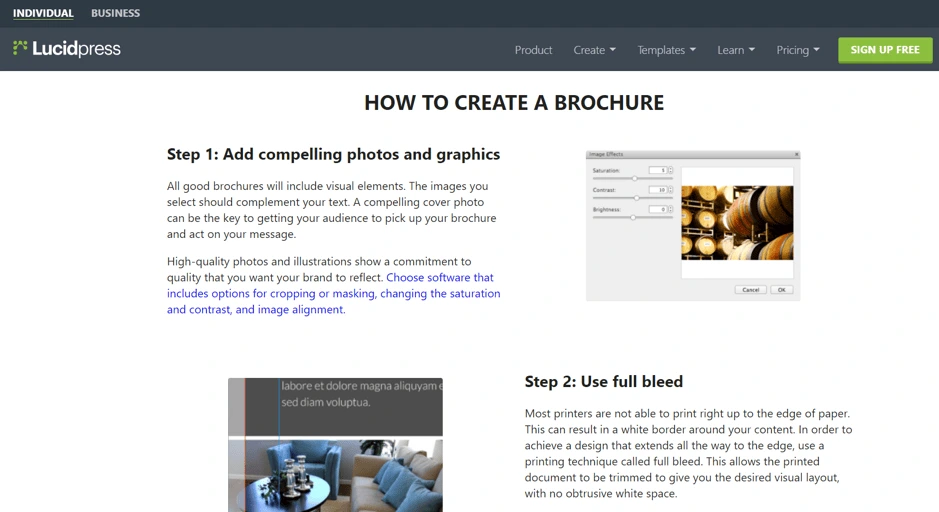
Next, you might sign up for a free account to use a template and quickly create your brochure.
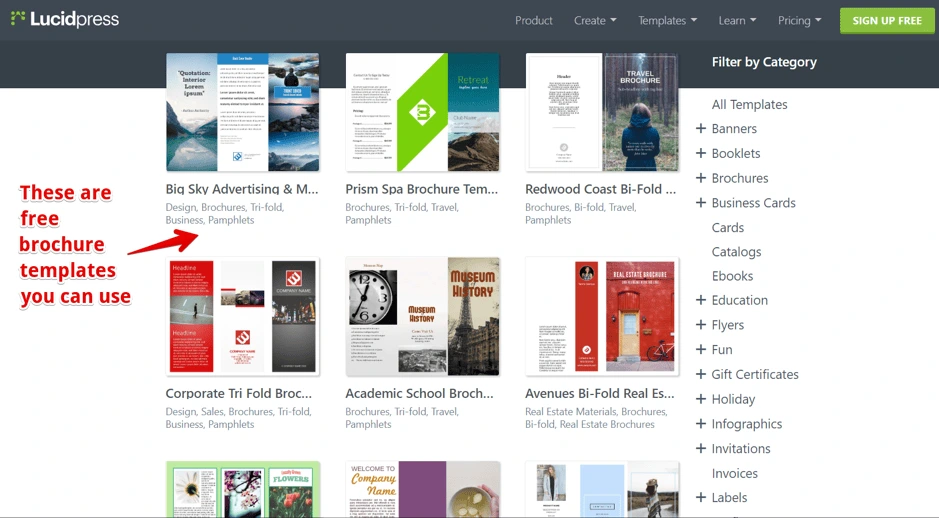
Now, here’s where the interesting part begins.
After a couple of days, you might hear from one of our sales reps. You’d already be aware and excited about our product because it helped you.
At this point, the job of the sales agent isn’t to arouse your interest, it’s to answer your questions. You’ve already completed the first part of the sales funnel before our team ever reached out to you—and as a result, you’re that much closer to conversion.
The bottom line is this: A blog, article or ebook can short-circuit the sales process and fast-forward it directly to the closing part. It helps you close more sales faster.
Landing pages
Here’s another example of sales collateral from our own brand. Our brand templating platform is well-suited for both individuals and large companies.
But, since our software serves different customers with different needs, we created two separate landing pages for them.

How does this help sales? Well, let’s say a marketing manager visits the business page and sees that she can request a quote right away. Now, the job of our sales agent is much easier.
He knows:
- why this person wants the product (for organizational use)
- which features & benefits to present
He isn’t bombarding the prospect with benefits and waiting to see what sticks. Instead, he knows exactly which of the buyer’s buttons to push.
The point is this: A landing page helps you segment your audience, and it helps your sales agents talk about what interests the buyer, which makes their pitch much more persuasive.
Case studies & testimonials
Case studies are one of the most effective types of sales collateral because they rely on a powerful principle of persuasion: social proof. []
According to Dr. Robert Cialdini, this psychological & social phenomenon is driven by the assumption that people around us are more knowledgeable about a particular situation than we are.

When a prospect reads a case study, it provides them with valuable information about the historical performance of your company. They’re able to project their business or brand into the narrative and “try on” your company as a partner. If you could help a business like theirs achieve success, it stands to reason that you could help them, too.
The bottom line is this: A case study not only makes the prospect want your product more, it also resolves objections a person might have about your company’s performance and trustworthiness.
Live sales presentations with product demos
Sales presentations are sometimes perceived as boring or annoying. Actually, they can be one of the most effective pieces of collateral—if your sales reps are properly trained.
For instance, what brochure, flyer or ebook could be more convincing than this? (Watch how sales come pouring in…)
The bottom line is this: When delivered properly, sales presentations can be one of the most compelling types of sales collateral out there. People buy from people, and live presentations are a great way to build that relationship.
Explainer videos
The biggest disadvantage of a live sales presentation is that you cannot scale it. For instance, you can’t demo a product in front of a million people at once, right?
Actually, the internet can help you do that. For instance, if we bring one million people to our website, they can see in a matter of seconds how our product can help them.
Source: Lucidpress.com
As you can see, it doesn’t have to be a super complicated video production. And you don’t have the logistics of a live sales presentation—where you have to reserve a room, take care of your guests, make sure you have the proper equipment, and so on.
The bottom line is this: An explainer video helps your prospect have an a-ha moment that brings him closer to the buying decision. It’s a scalable way to create interest & desire with your clients before a salesperson steps in.
Brochures & flyers
What do you do when a sales agent offers you a flyer or a brochure? You probably thank them politely and throw it away around the corner, right?
Well, it doesn’t have to go that way. Not if it’s clear that your brochure will provide value to the reader.
Here are a few tips to make brochures & flyers some of your most effective sales collateral:
- Put the benefits front & center—don’t just talk about your company; tell prospects how their life will be better with you.
- Create a compelling offer (like a discount or a free sample) that’s exclusive to your print materials.
- Take advantage of great design—a vibrant, colorful brochure with neatly organized sections looks far more professional than a quick job done in Microsoft Word.
Sales scripts
There are basically two ways to learn anything:
- The slow, risky way: You can try every idea and fail until you eventually find the formula for success.
- The fast, sure way: You can skip all that and do what’s already proven to work.
Instead of letting your sales reps waste time & money to learn what works and what doesn’t, why don’t you provide them with sales scripts that already work?
All you have to do is take aside your top sales agents and ask them how they do it.
The bottom line is this: Sales scripts are one of those growth hacks that can bring you 80% of the results with 20% of the effort. Plus, it costs next to nothing to implement.
Other useful sales collateral types
Sales collateral includes any materials that help reps close deals faster by offering prospects the information they need to make a buying decision.
The format can be just about anything. Above, we discussed some of the most efficient types both on and offline.
Here are some other types of sales collateral that can be handy for your sales agents:
- FAQ sheets
- Buyer’s guides
- Newsletters
- Email templates
- Technical data sheets
- Slide presentations
- Objection-handling sheet for prospecting calls
Sales collateral tips & tricks
Stay consistent with your branding
If you’re a beer drinker, you can probably guess which product is being advertised below, right?

It’s Carlsberg, and that is a banner they used at the Euro 2006 Football Cup in France. They couldn’t use their brand name due to a French law that forbids advertising alcohol or cigarettes at sporting events (even though they were a sponsor).
But because they kept their branding consistent throughout the years, they had the confidence to leave off their logo (a move few brands could pull off), and people still recognized the brand.
No matter what type of sales collateral you use, make sure you convey:
- the same value proposition
- the same benefits
- the same tone of voice
- the same keywords
- the same fonts
- the same colors
- the same brand personality
This will help you build a strong brand over time that inspires loyalty and trust in your customers—and recognition and credibility with your prospects.
Collaborate with other departments
Different departments have different insight that could help prospects make buying decisions quicker.
For instance, digital marketers could look into their analytics and find out that certain features of your product are used more often than others.
Sales reps, on the other hand, have direct objections from the field.
If your departments communicate with each other, you can get maximum results out of your sales collateral.
Make sure your sales collateral stays up-to-date
At some point, you’ll probably have to make changes to your sales materials. Maybe you’ll go through a rebranding. Or maybe you just want to refine your value proposition.
No matter the changes, you must make sure that everybody stays on the same page. Otherwise, you might confuse your prospects.
There are two ways to avoid this.
The hard way: You track all the edits you’ve made to your sales collateral in a document you share with all team members. Of course, this is time-consuming, and you can easily make mistakes.
The easy way: Use a brand templating platform to make updates much easier, and you can be 100% sure there are no errors because your changes will sync with everyone else.
For instance, with Lucidpress:
- Your team has access to all brand assets in one place.
- You can lock down branded elements in your templates that should never be changed.
- You can collaborate in real time to make sure your brand stays consistent throughout every channel.
Before creating your next sales collateral…
No matter what type of sales collateral you create, you should answer the following questions:
- How does this material help the prospect?
- How does this material fit into the buying journey of my clients?
- What are the top 3 to 5 benefits that matter most to my clients?
If you can answer these questions, you’re on the right track to create compelling sales collateral that streamlines the process and helps your team close more deals.
Learn how you can lead your organization to creating an effective sales enablement program with consistent storytelling across your sales org.
Have you ever worried that your brand messaging is a bit… generic? Does your copy sound flat and uninteresting? Do customers feel like your brand is speaking at them, not to them?
These are questions many brands grapple with on a daily basis. Some focus so much on pleasing everyone that they end up pleasing no one. Either way, the results are a tired brand and conversion rates that hit new troughs every week.
Related: How to create a voice for your brand
As any seasoned copywriter will tell you, it’s much easier to convince a single person to choose your brand than to convince a large group. By personalizing your campaigns, you add intimacy, authenticity and trust—vital ingredients for improving conversion rates.
To personalize effectively, however, you first need to understand who your buyers are. The best way to do that is to create buyer personas.
In this guide, I’ll show you why buyer personas matter for B2C brands and how to make them.
Buyer personas: Not just for B2B marketing
What does your ideal customer look like? What websites do they frequent the most? What are their likes and dislikes?
A buyer persona helps you answer these questions and more. Think of it as a fictional portrait of a specific customer that helps you understand their mindset and create better targeted campaigns.
What is a buyer persona?A buyer persona is a fictional portrait of a specific customer that helps you understand their mindset and create better targeted campaigns.[]
This specific customer doesn’t actually exist. Rather, they represent an entire consumer group. If your brand targets men aged 25-35, for instance, your buyer persona might focus on a 28-year-old single male who works in finance and enjoys playing video games.
Essentially, you create buyer personas so you can create campaigns that are more relevant and personalized. Instead of speaking to everyone’s concerns, you can tailor your messaging to address the concerns of a specific group.
This sample persona from the Buyer Persona Institute should give you a good idea of what we mean:
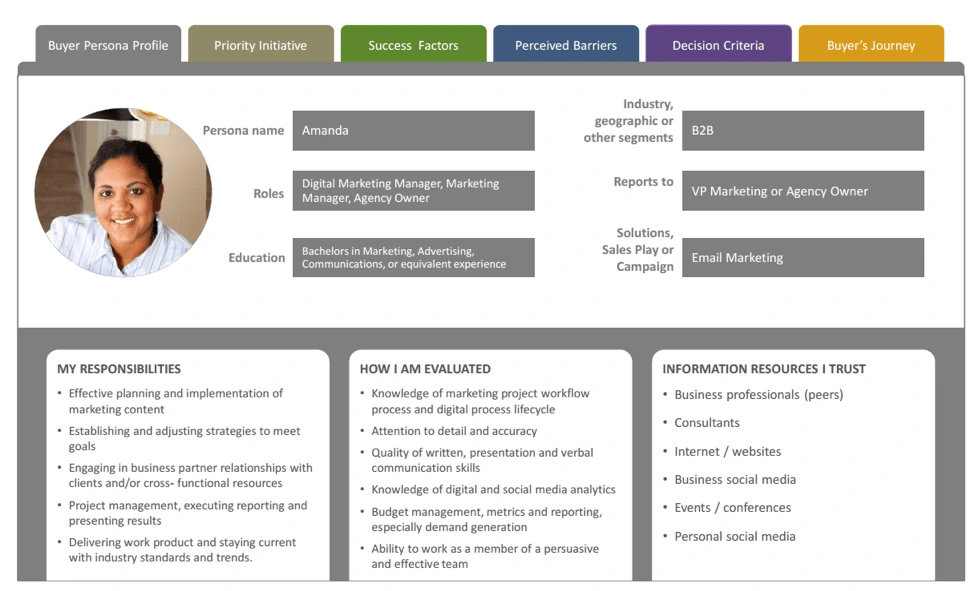
Your buyer personas should target customers who:
- want to buy your products, i.e. have clearly expressed a need and desire to buy from you.
- would buy your products, i.e. are a good fit based on their demographics & psychographics but need to be educated about the product first.
How many buyer personas you’ll have is up to you. A new startup with a single product might have just one buyer persona. A huge corporation like Microsoft might have dozens—even hundreds!—of personas.
How better buyer personas impact conversion rates
Have you ever landed on a website and felt that it spoke just to you? That it mirrored the values you believe in and addressed the exact problem you hoped to solve?
This likely wasn’t an accident; it was probably the result of meticulous buyer persona research.
While there are many ways to improve conversion rates—storytelling, design choices and website speed, to name a few—much of it eventually boils down to the same thing: the clarity of your messaging. When you can identify your customers’ deepest desires and address them directly, you won’t suffer from low conversion rates (and you won’t have to depend on design hacks to save you).
Take Apple’s MacBook Air landing page as an example.
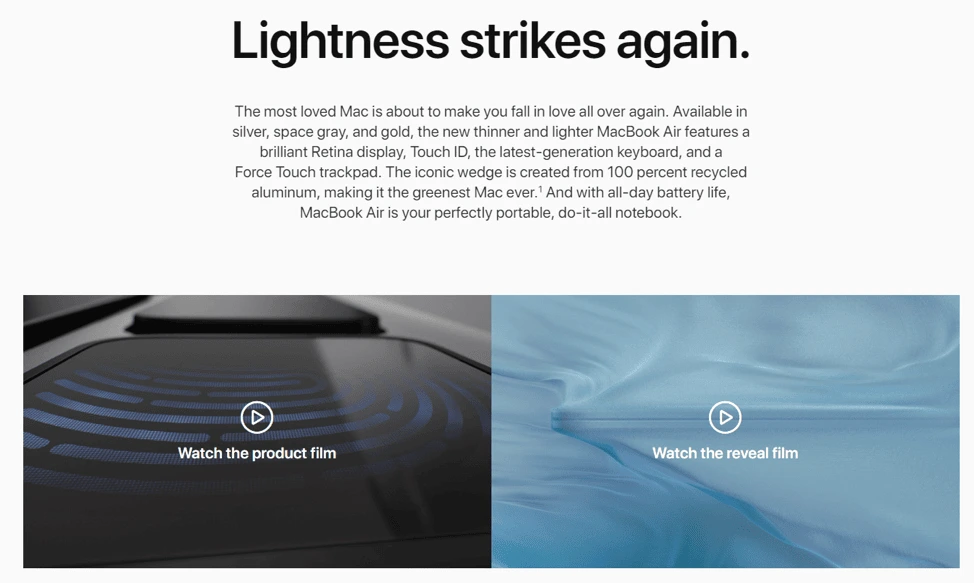
Right away, the copy addresses all the things MacBook Air customers care about:
- Low weight (“Lightness strikes again”)
- New features, especially Retina display
- Environmentally friendly design (“recycled aluminum”)
- Portability and battery life
The repeated use of “again” calls out to current MacBook users, using a bit of nostalgia to entice them to upgrade.
Without a detailed buyer persona, it would’ve been difficult for Apple’s copywriters to know which features to highlight and which to ignore.
This is the true value buyer personas bring to conversion rate optimization. By changing your copy to focus on the things your target audience cares about, you can achieve significantly better conversion rates.
Moreover, accurate personas help you understand your customers’ preferences, from the language & writing style to the visual elements.
If you have detailed buyer personas, you can create personalized landing pages (which convert better) and offer better recommendations to customers.
The question now is: How exactly do you go about creating these buyer personas? I’ll share some ideas below.
Gathering the information
A strong buyer persona is based on data & insight from market research. This first-hand information reveals demographic & psychographic information about your customers.
There are a variety of strategies you can use to collect this information, and here are a few examples.
1. Run surveys
Hosting surveys is a good way to gather information right from the source.
You can either run a survey on your existing customer base or place a pop-up survey on your website for visitors to participate in.
Make sure that you have a large-enough sample size for the data to be accurate. Don’t over-rely on survey results—self-reported data tends to be biased.
You can use software such as Qualtrics, SurveyMonkey or Qualaroo to help you create a survey.
Additionally, consider reaching out to your customer support & sales teams for insight, since they interact with customers on a daily basis.
2. Use your competitors’ data
If you don’t have a large customer base or heavy traffic on your site, you can look to your closest competition.
For example, you might use Google Alerts to know each time your competitor is mentioned online and analyze the source.
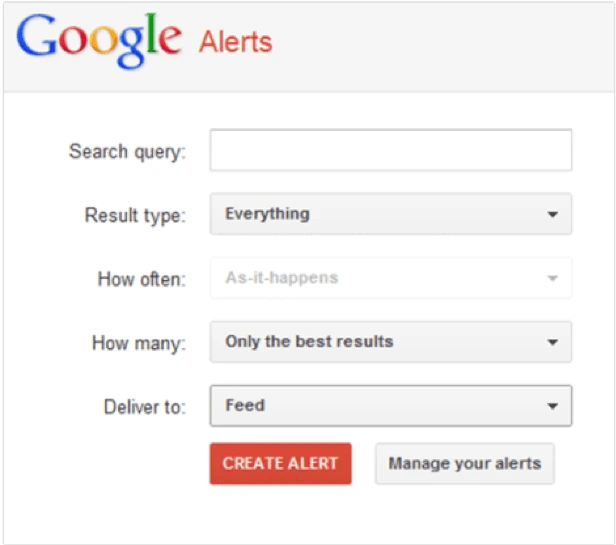
When any mentions pop up, ask yourself:
- Who is writing about my competitor?
- Which other topics, products and issues do they write about?
- What are the demographics of the audience leaving comments or sharing the article?
You can also visit your competitors’ Facebook, Instagram & Twitter pages to see how people interact with their brand (and what those people are like). Pay particular attention to their geographic location, ages and shared interests.
This kind of research is often subjective, but it can still give you a good indication of your competitors’ audiences.
3. Hang out where your customers are
Put yourself in the shoes of your ideal customer.
Hang out where they do and listen to what’s being said. It’s a direct way to discover insights about the language they use and the challenges they face.
You can also read through comments on blogs, hang out on forums, or even attend in-person trade shows and events.
For example, if you’re an athletic shoe brand, you might use Reddit’s search feature to find questions potential customers are asking about running shoes. This can help you zoom in on the problems these customers face and how to address them in your messaging.

Bring your buyer persona to life
Now that you’ve gathered the data, it’s time to make sense of it and bring your ideal customer to life.
Buyer personas are open-ended in terms of what you can or can’t include in them. Virtually anything that helps you understand the customer better is fair game. This includes everything from the customer’s (fictional) background & education to their favorite movies & brands.
Since you’re targeting B2C customers, you can let go of some B2B buyer persona conventions such as including the customer’s title & job duties.
That said, there are a few things every buyer persona should have:
- Name. Give your ideal customer a name to humanize them and make them easier to reference. This can be a first name or a full name; the choice is yours.
- Demographic information. Include basic demographic information about the customer, including their age, location and gender.
- Education level. The complexity of your copy and the features you choose to highlight will often depend on how educated your customers are.
- Background. Create a background story for the buyer. If they already know about your brand, explain how they came to find you.
- Psychographic information. What does the customer like? What do they dislike? Psychographic data can reveal a great deal about your customers, so pay special attention to this section.
- Motivations & values. What motivates your ideal customer? What do they want—from life, from work and from your brand? If you’re a value-based brand, what values will you highlight to appeal to them?
- Picture. Although it’s optional, putting a face to the buyer makes it much easier to visualize them and relate to their problems.
Bring it all together into a single Lucidpress document. You can keep it text-heavy or use a visual design—it’s up to you. For reference, check out this sample buyer persona:

Source: Shopify
Key takeaways
Creating buyer personas helps you speak directly to your customers.
By knowing the traits, values and priorities of your customers, you can craft personalized messaging that feels more relevant to them. The results are highly targeted campaigns with higher conversion rates.
Try it yourself by gathering data on your customers and summarizing it in a well-designed Lucidpress document.
When prospects enter your sales funnel, the goal is to get them to the bottom, where they turn into loyal customers. Doing this takes a lot of effort, of course, but the rewards are worth the struggle to get it right.
Related: The ultimate guide to a winning sales playbook
Before we look at ways to increase conversions at every stage of the sales funnel, we need to first establish what a sales funnel is.
What is a sales funnel?
A sales funnel is a conceptual framework used to identify the various stages a customer moves through in the process of making a purchase decision. [] The widest point is at the top, where all potential customers enter the funnel. The narrowest point is at the bottom, where customers make their final purchase decision.
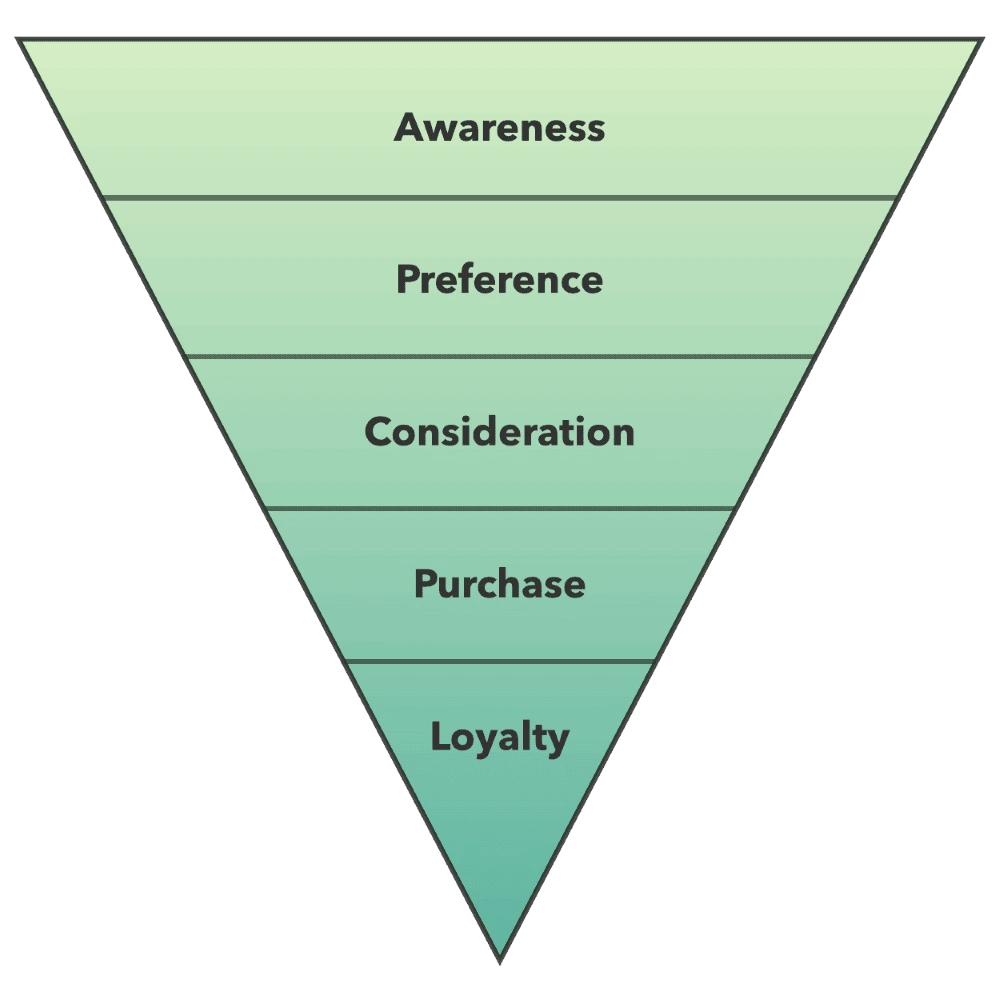
Sales funnel graphic created in Lucidpress
If you want to make more sales, it’s easy to assume you need more prospects at the top of the funnel — but that isn’t always the case. A better approach would be to move more customers through each stage of the funnel, so that by the time they’re ready to convert, they already feel like a valued customer. In other words, we want to improve our conversion rates.
If we take a closer look at each stage in the funnel, we’ll be better prepared to brainstorm & implement strategies that will make every stage in the funnel more effective. Let’s dive in at the same place your customers do: the top.
Stage 1: Increasing conversions in the awareness stage
Here’s a shocker: People can’t purchase from you if they don’t know you exist. And even if they are aware of your company, they need to know they can trust you.
One way to make your brand more trustworthy is to give your audience content that shows off your thought leadership and expertise. A blog is a great channel for publishing and sharing branded content. For example, if your business sells software, your blog can give users tips and tricks on how to use it. If your business sells cars, your blog can give readers useful info about how to maintain peak performance.
There are many ways to give content to your customers, from ebooks to infographics, and you have to find the ones that work best for you. The content you publish can be about anything related to your business, your industry, or even your location. The point is to solve problems for your reader and offer your brand as a solution.
Stage 2: Increasing conversions in the consideration stage
Now that prospects are familiar with your brand, it’s time to engage them directly. The easiest way to do this is to get their email address. However, people are not always happy about handing this over, especially if they don’t get anything in return.
To make it compelling, you need to offer them a gift — one that has value to them — as a thank you for signing up to receive emails from you. Exchanging an email address for a free trial or sample is a small commitment for the customer to make, but it offers big rewards for you.
Stage 3: Increasing conversions in the preference stage
If a prospect is engaging with you, chances are that they’re interested in making a purchase but still have unresolved questions & concerns. The problem is, they won’t always share them with you, so it’s wise to pre-empt them and provide answers to the questions & concerns you hear most often.
One of the best ways to do this is to send an email that covers FAQs and encourage them to contact you if they want to know anything else. You might also consider using an email drip campaign, where customers receive a series of emails from you. Each email should bring the customer a step closer to purchasing, so that by the time the series has ended, they’re ready to buy. Sales and marketing can work together to produce compelling sales enablement materials.
Stage 4: Increasing conversions in the purchase stage
Finally, it’s time to close the sale. The most important task here is making sure your buying process is crystal clear and that customers know how to finalize their purchase.
Studies suggest that prospects have to be offered a product seven times on average before they’re ready to buy. [] But even if prospects find their way to your website, it’s not a given that they’ll come across the product you want them to buy.
If you have a product or service you want to highlight, you can use promotional pop-ups to prompt interest. This gives prospects a way to click through directly to the product, regardless of which page of your website they start from.
Stage 5: Increasing conversions in the loyalty stage
Once your customers have made a purchase from you, it’s much easier to persuade them to make another one. Now that you’ve put in all the hard work to get them to this stage, it would be a mistake to let them go.
Remember, customers are more likely to return if they’re happy with what they received the first time around. That’s why paying attention to every stage in the cycle is important. Prospects are continuously evaluating your brand on a number of fronts to gauge your credibility & professionalism:
- the consistency of your brand messaging
- the quality of your products & service
- the traits that differentiate your business from competitors
- the treatment they get from sales & customer support
If you’re delivering on all those fronts, you won’t have to try very hard to convince them to purchase from you again. Good brand experiences are powerful and memorable.
If you want to make the deal even sweeter, you can offer additional products which complement what they’ve already bought. If your product is something they’ll need to buy again, keep in touch so they know where to go when the time comes.
Stage 6: Boost productivity by using sales software
It can be difficult to keep track of where every customer is in the sales funnel, but automated software can do it for you. Any good CRM will help monitor past behavior and make suggestions based on these insights. Plus, using pipeline management software can ensure no customers slip through the cracks.
There are many other sales tools that can streamline the funnel. For example, Lucidpress can help keep your brand messaging consistent by offering your sales team a centralized place to create, customize & share sales collateral. We recently published a huge round-up of 160 sales tools that can increase your team’s productivity.
Key takeaway
Optimizing each stage of your sales funnel will lead to higher conversion rates and more closed wins. If customers trust you and are well-treated from the moment they come into contact with you, they’re more likely to become loyal customers. That means having an effective sales funnel is crucial to the growth & success of your business.
Where’s the best place to start? Learn how Lucidpress can streamline the sales process for your team while building a strong brand for your organization.
Cold-calling prospective customers is only as effective as you make it. Meaning — you and your sales reps have to do some strategic legwork in order to make cold-calling work in your favor. And while it might be tempting to relegate cold-calling as an intimidating, outdated tactic, you wind up selling yourself short in doing so.
Related: 4 professional voicemail greeting tips to impress your prospects
Ultimately, cold-calling empowers sales reps to strike while the iron is hot and anticipate customer needs ahead of time — so your team connects with prospects well before your competitors do. That said, there’s a few steps you need to keep in mind before hitting the phones.
10 cold-calling tips from industry leaders
We’ve compiled ten cold-calling tips & tricks from various industry leaders to help you feel set up for success and close deals faster than you can say “transactional.”
Tip 1 – Do your research
“Don’t go into the call with the mindset that no sale equals failure — the pressure of that can make sales a daunting job. It takes between 5-12 calls to convert a cold prospect into a genuine opportunity, so don’t expect to get a yes straight away. Instead, do your research on the company and the contact you’re calling, set yourself an objective that will move the prospect closer to a sale, and figure out possible objections and how to overcome them. Above all, always remember that it’s not that the product is wrong, or that your pitch isn’t perfect, it’s likely that the time isn’t right for the customer to be making the purchase. You could have an entire day of people rejecting you, who are left with a good impression and who’ll be warm leads the next time you touch base. Try and think of a ‘no’ as a ‘not now’ so that there’s less dread when you pick up the phone.”
Ian Clark, Head of Americas (Sales), Frank Recruitment Group
Tip 2 — Lean on tactical approaches
“Winning at cold-calling is not about the tactic itself, but about your strategy. Picking up a phone and dialing for dollars is not a strategy; it’s a task. What most salespeople don’t get is that it can be done in a strategic and effective way (i.e. a method for prospecting that you can execute consistently). You can create a 6 x 6 x 6 prospecting program integrating email:
Victor Antonio, Founder, Sales Velocity Academy
- Week 1: Voicemail with value #1
- Week 2: Email follow-up with value #1 messaging
- Week 3: Voicemail with value #2
- Week 4: Email follow-up with value #2 messaging
- Week 5: Voicemail with value #3
- Week 6: Email follow-up with value #3 messaging”
Tip 3 — Send information prior to the call
“Send information by email. If possible, always send information before the phone call. This informs the prospect that you would like to have a phone conversation. After the phone call, send a follow-up email with the information that they requested.”
Albert Ho, Consultant, Healthcare Heroes
Tip 4 — Empathize with the customer
“To help a customer ‘see’ something they don’t understand, you have to find out what they relate to. When attempting to explain a complicated concept, someone must struggle. Either you (the sales rep) will struggle to explain a foreign idea to the listener, or the listener will labor to understand what you’re trying to communicate. If it’s the latter, most of the time the customer will just walk away.”
Tom Stanfill, CEO, ASLAN Training
Tip 5 — Ask questions
“Successful sales calls are not just about pitching your product or service. Top sales reps should use cold calls as a way to explore what is resonating with prospects and feed that into their sales process. During a cold call, reps typically ask four questions relating to the prospect’s pain source, qualification and value. One of the best ways to prepare for cold calls is by creating a battle card relating to these areas. This process can help train your sales team on how to prioritize one question over the other and pivot based on a prospect’s response.”
Roy Raanani, CEO, Chorus.ai
Tip 6 — Humility over hubris
“Remember the majority are satisfied and believe they have made a good decision with their current provider. Show humility – ‘I believe we can add…’ or ‘We may be able to…’ versus an overly confident sales approach.”
John Reid, President & CEO, JMReid Group
Tip 7 — Be yourself (not a robot)
“Stop sounding like a robot. At their core, people just want to feel heard, understood and acknowledged. If you’re reading off a script, the prospect can tell. If you’re nervous and stiff, the prospect can tell. If you’re trying to control the conversation or steer it a certain way that feels forced, the prospect can tell. The catch-22 here is that the only way to get better at not sounding so robotic is to actually make the calls — and to ensure you go out of your way to care while you make them.”
Nick Gonzalez, Commercial Real Estate Broker, Linville Team Partners
Tip 8 — Maintain perspective in spite of negativity
“It’s good to keep the following in mind before and during your dedicated cold-calling session:
Chad Knibbe, Director of Investment Sales, Foresight Commercial Real Estate
- Remind yourself that the call recipient really can benefit from your product/service if they give it a chance. This is helpful during times when you get a lot of negative feedback on calls.
- If the recipient is rude, it is not a response to you personally, rather the effect of unrelated circumstances contributing to their state of mind. Don’t let defensive thoughts sink in to your head, just get on the next call quickly.
- Know how much each dial is worth to you. Know the ratio of calls it takes to make a sale, and put a dollar figure on each call attempt. For example, if it takes 50 calls to make a sale, then each call is worth 2% of your average sale. Linking each call to a dollar figure is very effective motivation during unproductive calling sessions.”
Tip 9 — The first phone call isn’t everything
“Qualification. Not everyone will fit. Learn to say no to the prospect. Qualification vs. call-to-action. You have to qualify the meeting. However, as an SDR, there are only so many questions you can answer. On question number five from the prospect? Push for a meeting. You won’t always know all the answers right away.”
Radé Kemalova, Head of Internal Sales Development, CIENCE
Tip 10 — Respect their time (and yours)
“I teach all my agents to say the following phrase at the end of each call: ‘Okay! I have you down at 3 o’clock on Monday. I am setting this time aside for you, and I guarantee you that it will not be a waste of your time. I just want to make sure you’re going to be there because I don’t want to waste my time, either. Does that sound fair?’ It may sound pretty brash, but people appreciate that you are a busy individual and that your time is valuable!”
Sara Hornick, Executive Partner, Hudson Wealth Management
A solution for success
Keep in mind, success doesn’t happen overnight — it requires conscientiousness and deliberate effort from each and every team member. A winning cold-calling strategy is no different. In order to assure success and overcome objections in stride, sales reps need to read between the lines, hear the customer’s wants and needs, and apply each of our recommended cold-calling tips as they chat. By giving cold-calling the due diligence it deserves, sales teams can thrive, uncover new prospects, close deals, and earn repeat customers with ease. Learn more about sales enablement.
As a sales leader, pipeline management is one of the most challenging aspects of your job.
In the past, communication only took place through phone, snail mail and in-person meetings. Cold-calling was the strongest tool in your sales arsenal.
Related: The 160 best sales tools & software
In 2007, sales pros could reach prospects one the phone in about one out of four attempts. Today, it takes about eight tries to get a potential client on the phone, and sales cycles are longer.
Your role as a sales leader is vital, but it means you don’t usually hear from prospects until they’re almost ready to buy. It takes heaps of patience & organization to keep track of potential leads.
Not only that, but the vocabulary of the industry has become more complex.
In this post, we’ll review the concepts you need to know to understand sales pipeline and offer specific strategies on how to manage sales pipeline effectively.
Sales terms you need to know
Sales jargon can be confusing.
Before we dive into what a sales pipeline is in more detail, let’s cover some commonly misused sales terms.
Though the following terms are related, there is a difference between the terms sales pipeline, sales funnel and sales process.
- Sales pipeline: Traditionally, this meant the stages a prospect moves through in their journey from stranger to customer. The sales rep moves this process along. Sales pros also use the term sales pipeline in another way. They often refer to their “pipeline” as the dollar value of current leads they are moving through the stages of a pipeline. While it’s fine to use this term, sales forecasting is a more accurate way to refer to the amount of potential revenue in your pipeline.
- Sales funnel: The stages a prospect moves through in their journey from stranger to customer. As mentioned, this is often confused with sales pipeline. The stages in the funnel are different than the pipeline, and the prospect is the one in control of how they move through those stages.
- Sales process: What the sales rep/team does to help prospects through the pipeline. These are specific actions, not stages as in the pipeline. Sales process & sales pipeline are often used interchangeably, even though they have different meanings.
Because different teams use these concepts to refer to different things, it’s important to clearly communicate what you mean by these terms and how you expect them to be used on the floor.
Do sales pipelines fit into inbound marketing?
Inbound marketing is a bit of a buzzword these days. Specifically, it’s a marketing process pioneered by HubSpot as a way to convert prospects digitally, using content to attract them.
What is inbound marketing? Inbound marketing uses a sales funnel that prospects move through on their own. The traditional sales pipeline is a function of outbound marketing, though it may be adapted to work well in an inbound marketing process.
As the internet became an integral part of our everyday lives, companies dived into the bottomless ocean of inbound marketing – sometimes hastily. Many abandoned traditional sales techniques (a.k.a. outbound marketing) altogether. The sales pipeline was ignored because it didn’t fit with the inbound marketing model.
What followed was an explosion of content: blog posts, landing pages & email newsletters galore. Back in 2014, business expert Mark Schaefer saw the writing on the wall and we entered the age of content shock.
Today, thankfully, many businesses take a more balanced approach. This raises the question, though: does inbound marketing with content still work?
Of course it does.
But, there are certain situations where traditional outbound marketing techniques often work better. This is where sales pipeline management becomes a critical skill for sales leaders to have. Some examples where outbound is more appropriate include:
- High-ticket consumer goods with five- to six-figure price tags
- B2B services with long-term contracts
- Service-based businesses like home contractors, etc.
Inbound marketing & outbound sales are the perfect pair in omnichannel marketing strategies. This combines traditional outbound techniques like TV ads and cold-calling with inbound marketing techniques like landing pages and educational content.
Stages of the sales pipeline
Sales pipelines are structured in stages based on how close a prospect is to converting from a stranger to customer.
Sales pipeline stages can look very different depending on a variety of factors, including:
- Businesses that rely on one-off projects or services
- Subscription-based business models (software subscriptions, web hosting, service contracts)
- How many sales are needed to achieve company revenue goals for a specified time period (monthly, quarterly & yearly are the most common).
A business that relies on one-off projects will need more prospects in the pipeline than a subscription-based model because the length of the relationship is usually shorter.
Here’s a basic pipeline that works across all business models. The length of time each prospect stays in a specific stage (and the number of leads needed in each stage at any given time) vary greatly.
- Prospecting – the process of finding potential buyers for your product or service. 40% of sales pros say prospecting is the hardest part of the job.
- Qualification – when you determine the prospect is a good fit. This can happen via meeting, phone call, email, or some other method.
- Proposal – After qualification, you present a proposal to a prospect. This can be verbal, delivered via a formal document (most common in high-ticket sales), or even sent as a price list.
- Sale – If the prospect accepts your proposal and buys, they are now a customer.
CRM (customer relationship management) software is a great sales tool to help determine where your prospects are in your sales pipeline. It can also help you analyze the prospects who didn’t make it to the end of the pipeline.
Sales forecasting: How pipeline value is calculated
Pipeline reports provide a dollar value of all deals currently in a salesperson’s pipeline. Most CRMs automatically calculate this amount.
We mentioned before that sales forecasting is a better way to talk about what’s in your pipeline. There’s no 100% guarantee that all those prospects will become customers, so it’s important to keep filling your pipeline with prospects to continue closing deals.
Experienced sales leaders can often predict (not 100%, but often) which leads are likely to turn into customers quickly (hot leads), which will take more hand-holding (warm leads), and which are likely to fizzle out. Over time, you will develop and refine this sense as well.
Tools of the sales leader’s trade: CRMs & sales collateral
Both newer technology and “old school” techniques play a crucial role in sales. Here are two of the most important sales tools to master.
CRMs
The more leads you have in your pipeline at the same time, the more likely it is you’ll need to use a tool like a CRM to keep track of all your customers & deals.
Software programs like Salesforce harness the power of technology to keep you organized without a secretary. You can track all emails, calls & meetings with particular prospects or client companies.
CRMs provide huge benefits to those who deal with a high volume of leads, because you can:
- create pipeline reports
- see percentage of deals won versus lost
- automate follow-up and check in with your leads via drip emails
- attach branded materials like brochures & sales sheets to emails
When used efficiently, CRMs eliminate the tedious work of keeping track of which lead is in what stage of the sales pipeline. CRMs like HubSpot Sales have mobile apps that connect to phones so you can record conversations.
Sales collateral
Before the internet was around, sales enablement collateral (like brochures & business cards) was mailed, handed out or left behind at in-person meetings.
Now, meetings take place both in person and virtually. But, that doesn’t printed sales collateral is dead. Far from it.
Consider this:
If a prospect is meeting with you, they are probably interviewing several potential vendors at once. Since companies often provide a lot of information (like flyers) about different products & services, the prospect needs an easy way to keep everything organized.
Because information is exchanged both in person and via email, all your company’s sales collateral should match so the prospect knows which flyer belongs to what company. This way, they can make an informed decision using all of your information. If you email them a plain Word document but hand them a colorful flyer that looks completely different, they might mix up or throw away critical information and you lose the sale.
That’s why Lucidpress is a stellar sales tool for your entire organization. It gives your entire team flexible access to branded sales & marketing templates.
Though you likely won’t be involved in designing the documents, sales reps on your team can use Lucidpress to provide prospects with the same documents digitally and in print. They can also personalize everything they hand out, so prospects feel seen and know how to get in touch quickly & easily.
With branded templates, you don’t even have to worry about whether colors, logos & fonts are being used properly – those assets are already present & locked down, so everything stays consistent.
Sales pipeline management tips & tricks
Ready to learn some pro tips for managing your sales pipeline? Check out these six strategic ideas to master the process.
- Don’t use a CRM if you don’t need to. If you’re responsible for managing only a few leads at a time, a CRM may be overkill. You can often get away with using a free CRM like Streak – or even a spreadsheet.
- Know your numbers. Even if you don’t use a CRM, you should still measure your average sales cycle, average dollars per deal, average lifetime value of a customer, and retention rate.
- Use your numbers. Take advantage of the data you uncovered to make decisions regarding how much time you should spend working with prospects, how often to follow up, and when to give up on an unresponsive lead.
- Keep accurate records. Your team has to keep track of who they’re working with and what’s been discussed, especially if they’re working with multiple people at the same company.
- Cold-calling is your friend. It’s not as scary as people make it out to be. If you get a prospect’s voicemail, keep your message between 8 and 14 seconds.
- It’s okay to use your personal phone. These days, most people have consolidated to one phone with one number. If you plan to use your personal mobile for business, record a professional voicemail greeting.
Key takeaways
Managing your sales pipeline can be complicated, but it isn’t impossible. Here are some key points to remember as you tackle this month’s quota:
- Understand the difference between pipeline & funnel, and make sure your team understands how you’re using these terms.
- Mastery of sales tools like CRMs & sales collateral make it a lot easier to close deals.
- Follow best practices to manage your pipeline – they really work!
Boost your bottom line and do more as a team with Lucidpress.
What’s the best way for businesses to generate leads even with an empty pipeline?
You guessed it: cold calls.
That said, cold calls aren’t what they used to be. Today’s reps often rely on cold-calling scripts to do the conversational heavy lifting for them. Not only does this ensure that reps respect their prospect’s time, but it also helps reps overcome obstacles, build trust, and ultimately schedule a meeting.
Related: 10 cold-calling tips & techniques for your sales team
A brief history of cold-calling
Traditionally, cold calls are unsolicited phone calls to prospective customers — with the term cold indicating that you’ve had zero prior contact with the prospect.
So, why do cold calls wind up falling short? Well, there are a few reasons:
- Sales reps are not ready for the call — 42% of sales reps say that a lack of info and preparation is the reason why they don’t perform well.
- Sales reps don’t engage with the prospect’s pain points — According to Salesforce, 85% of prospects expressed dissatisfaction over how sales reps conducted themselves during cold calls.
However, there’s no reason that reps should make blind cold calls. With a little help from the ole internet and the sheer number of prospecting tools at your disposal (e.g., Salesforce, ZoomInfo), otherwise ineffective cold calls are transformed informed, effective cold calls, which is a cold-calling script comes into play. A cold-calling script helps bridge the gap between off-the-cuff and on-the-nose, and in turn, guides the conversation no matter the objection or hiccup.
The benefits of cold-calling scripts
Scripts are essential in successful cold-calling strategies and serve as the foundation in structuring your cold calls and, ultimately, improving conversations with prospects. To effectively leverage scripts, sales reps and teams ought to use them as conversational guides instead of repeating the content word-for-word. Think of cold-calling scripts as you would a foundation for a new home: the design is entirely up to you, but a house can’t be a home without the structural integrity of a foundation.
How to prepare for cold calls
The best cold-calling scripts are the informed ones. In other words: doing a little digging (about your prospect) prior to the call makes all the difference. Jeb Blount, the author of the renowned sales book, _Fanatical Prospectin_g, strongly believes that preparing (also known as prospecting) is the number one factor in successful B2B sales.
Combine prospecting with in-depth research, and you’ll have a recipe for success. The goal of your research is to know your prospects like the back of your hand — nearly 70% of buyers are more likely to make an order if the sales rep has made an effort to build a relationship and rapport with the customer. Be sure to make a note of essential company details, recent developments, or potential pain points that could aid your conversation.
- Company details
- Names
- Industry
- Product or service offerings
- Recent developments
- Social media updates
- Current events
- PR notifications
- Pain points
- Company reviews
How to draft the best cold-calling scripts
But before you or your reps hit the Net or phones, there are a few things you’ll want to keep in mind when crafting a cold-calling script.
- Be considerate with your greetings — respect your prospect’s time.
Today the average person has an attention span of 8 seconds — so you want to capture your prospect’s attention right off the bat. Provide your prospect with a brief introduction (name and title at the company) followed by a concise statement to explain why you’re calling. Ideally, in less than 8 seconds, your prospect should be able to know who you are, what your company is doing, and that you’d like to help them solve a pain point.
Sample script:
“Hi, Erin. I’m John from Lucidpress. We’re a brand templating platform that empowers B2B companies to create effective sales materials quickly. I’m calling to see if we can help your company.”
Don’t bother asking filler questions like “How are you?” or “Is this a bad time to call?” Your prospects are busy, so be direct.
If you find yourself being re-routed to an assistant instead of your prospect, be courteous and honest. And remember — know the names of your prospects (and their assistants) beforehand so you can start on the right foot and build trust right off the bat. For example:
“Hi, there. Is this Devon speaking? I’m John from Lucidpress, and I’m looking to get in touch with Erin from sales. Could you connect us?”
- Communicate value — ask questions to overcome obstacles.
Now that you’ve got the prospect’s attention, it’s time to ask a tailored question. This shows you’ve done your homework and helps build trust with prospects. More importantly, these questions help you confirm pain points and offer potential solutions.
For example, say your prospect is a chief marketing officer, and you’re calling them to talk about your company’s CRM, an ideal question would be as follows:
- How do you feel about the effort it takes to manage clients with your current CRM?
- What would you say is the most important benefit you’re looking for in managing your leads?
Avoid closed-ended questions during this stage of the conversation. It’s better to let the prospect spill out their problems than to wrongly assume their pain points. Plus, it keeps the conversation flowing and prevents proverbial doors from getting shut unexpectedly.
That said, should you encounter an objection, don’t dismiss it. Address it head-on by asking an open-ended follow-up question:
“Hi, Erin. I’m John from Lucidpress. We’re a brand templating platform that empowers B2B companies to create effective sales materials quickly. I’m calling to see if we can help your company.
What would you say are your biggest challenges in ensuring your sales team get the content and materials they need to convince leads?
Since your team isn’t experiencing any major content hurdles, would your team benefit from having additional access to branded collateral — like, customizable one-pagers or letterheads?”
- Come to a mutual understanding — build trust and rapport.
Once you’ve uncovered your prospect’s pain points, leverage your company’s value proposition as a means of alleviating these pain points. Doing so showcases how you’re uniquely poised to solve these problems.
Be sure to articulate how your company explicitly to solves their problem — so, save the introductory elevator pitch for another day. Your prospect should get the feeling that you genuinely understand and sympathize with their challenges, not that you’re trying to pull the wool over their eyes. For example:
“Hi, Erin. I’m John from Lucidpress. We’re a brand templating platform that empowers B2B companies to create effective sales materials quickly. I’m calling to see if we can help your company.
What would you say are your biggest challenges in ensuring your sales team get the content and materials they need to convince leads?
I empathize with the source of your frustration. Correct me if I’m wrong, but it sounds like your team is having trouble finding the right materials to close their sales. A lot of our clients deal with the same hurdle — getting the collateral you need to close a sale can be tough, especially when you don’t have enough resources on deck.
Now that I think of it, we work with a handful of companies like yours. Most have found our platform to be easy-to-use, while the template gallery reduces production time and puts the power of content creation in the hands of your sales reps — that way they can focus on curating the perfect content for their clients. Do you have platforms or services like this in-use?”
From here onward, let the prospect primarily do the talking. Ask a smattering of questions, but you want to ensure they feel heard. Some good questions to ask at this stage include:
- Tell me more about your problem or current solution.
- How does this affect the performance of your business/team?
- What is stopping you from finding a solution to this problem?
By peppering these questions throughout the conversation, your prospect winds up inadvertently emphasizing a myriad of reasons why your company would be a valuable asset to them — teeing you up for the perfect pitch.
- Be bold — ask for the meeting.
The end goal of any cold call is simple: set up a meeting with your prospect. And there are only two rules in asking for a meeting: set a time and a date. Make it easy for your prospects to say yes. Instead of saying, “Can we connect tomorrow or sometime this week,” try saying, _“_Can we connect this Thursday at 1 pm?”
Giving them a specific time and date makes it hard to say no, and it lowers the chance of that meeting getting delayed, which can happen when sales reps don’t have a definite timeline in mind.
A complete cold-calling script example
Curious what a complete cold-calling script example looks like? Check out our example below.
“Hi, Erin. I’m John from Lucidpress. We’re a brand templating platform that empowers B2B companies to create effective sales materials quickly. I’m calling to see if we can help your company.
What would you say are your biggest challenges in ensuring your sales team get the sales enablement content and materials they need to convince leads?
I empathize with the source of your frustration. Correct me if I’m wrong, but it sounds like your team is having trouble finding the right materials to close their sales. A lot of our clients deal with the same hurdle — getting the collateral you need to close a sale can be tough, especially when you don’t have enough resources on deck.
Now that I think of it, we work with a handful of companies like yours. Most have found our platform to be easy-to-use, while the template gallery reduces production time and puts the power of content creation in the hands of your sales reps — that way they can focus on curating the perfect content for their clients. Do you have platforms or services like this in-use?
Can you elaborate more on that?
How are you currently handling the problem?
How is this affecting the performance of your sales team?
Thanks for letting me know about your concerns, Erin. I’d love to swing by and explain how Lucidpress can help you with your sales team’s content concerns. Would this Thursday at 1 pm be a good time for me to stop by?
I’ll also send an email to you shortly summarizing our call today.”
Use cold-calling scripts to boost your sales team’s performance
By now, you should feel confident in your personal or your sales reps’ ability to craft effective cold-calling scripts. Alternatively, we recommend conducting a cold-calling script brainstorm session to customize your reps’ scripts further and boost team morale. As your reps periodically cold call new prospects, be sure to make a note of any objections or obstacles they encounter as these tidbits can further improve your cold-calling strategy down the line. And as always, feel free to share your cold-calling scripts or conversation tips and tricks.
It’s estimated that 97% of all business calls go to voicemail. With such a low answer rate, should you even bother with making phone calls?
Yes!
And even though the typical voicemail response rate hovers between 4-6%, your odds of getting a response are higher than direct mail and web banner advertising combined.
So while it may be frustrating to leave voicemails all day long, a good sales pro knows sales calls are critical to managing their pipeline. Here are 11 pro tips to help you leave quality voicemails that get responses and boost conversions.
Keep it short
The sales experts at Ring Lead recommend keeping messages shorter than 30 seconds. This serves two purposes: it shows prospects that you value their time, and it enables you to make the most of your workday, so you can make more calls.
Timing is everything
Your goal as a sales pro is to connect with the right people with the right message at the right time. While you can’t control who will or won’t answer the phone, make your calls at the beginning or end of the day.
Humans have a tendency to remember the first and last items (in a list) the most. This psychological concept, called Serial-Position Effect, can work to your advantage. Because most people listen to several voicemails at a time, being the first or last message in their inbox can give you a leg up on getting a response.
Make it mysterious
Building suspense is a great way to get callbacks. Simply leave your name, company name and phone number. This creates a sense of FOMO (Fear of Missing Out) that prospects simply can’t resist.
Watch your tone
Keep your tone enthusiastic and energetic. People love to work with the best, and nothing conveys it better than a friendly and positive tone.
Have a legitimate reason for calling
Don’t leave a voicemail if you don’t have a reason to. Your prospects are busy people and calling to see how things are going makes you sound too pushy. If you’re not sure who you need to speak to at a particular company, send an email instead.
Create a (true) sense of urgency
We live in a deadline-driven world. If your company is running a promo that’s about to expire, include the deadline in the message. This works best when the deadline is sooner than later. That said, don’t make one up to hit your quota. If your prospect can’t make the imaginary deadline cited in the voicemail, you may lose the sale for good.
Use a script
The easiest way to get your calls done faster is to work from a script. While you can find a lot of great ones for free online, rewrite it so it sounds like the way you speak. Otherwise, you’ll sound stiff and forced. Practice makes perfect. Once you get a script that suits you, say it out loud a couple of times before you start your calls for the day.
Keep it casual
At the end of the day, people buy from people. It doesn’t matter if you’re in the B2B field making million-dollar deals or selling five-dollar widgets. Don’t fill your voicemails with stuffy language or corporate jargon. Pretend you’re talking to a friend.
Don’t try to sell them anything
Nothing makes people hit delete faster than someone trying to sell you something over voicemail. Sales is a process. Save your persuasion for when you get someone on the phone or in-person meetings.
Practice SWIFT™
We know you want the sale. But the most effective sales happen when a prospect sees the benefit to them. There’s a great sales tactic called SWIFT™, which stands for: So, what’s in it for them? Communicate the benefits without pushing for the sale, and you’ll get a callback in no time.
Promise to follow-up
Any seasoned sales pro will tell you the money’s in the follow-up. Even though 80% of sales happen after five follow-ups to a meeting, 44% of reps give up after just one follow-up. That’s a lot of money left on the table. Persistence pays off. Tell your prospect when you’ll follow up in your voicemail.
How to Measure Success
Like everything else in sales, knowing your numbers is crucial to make sure you’re on track. Here’s how it breaks down with voicemails:
- Expect a 4-6% response rate on the first message. For every 100 calls, you should get between four and six callbacks. Anything above that means you’re doing something extraordinary — keep it up!
- The more you follow-up, the higher your response rate will be. Sales Hacker reports a higher callback rate than the industry standard (11% instead of 4-6%). However, they also did some digging and found that the more follow-up messages you leave, the higher your callback rate will be. Their numbers indicate that callback rates jump by 11% for each message you leave. So, first messages can expect 11% callbacks, second messages can expect 22%, and so on.
- You should be able to reach a live person in 8 attempts or less. It takes an average of eight touches to get a prospect to even talk to you. These touches include voicemail, email, social media, and more. If you’re able to get someone on the phone in less than five tries, you’re on fire!
- It’s all about the conversion rate. Since you’re not going to get many callbacks, the people who do call are more likely to be interested in what you have to offer. This means that your conversion rate will be pretty high.
Key takeaways
In summary, here are the most important facts about leaving voicemails:
- The more messages you leave, the more likely you are to get a callback.
- Don’t try to sell on the voicemail itself.
- Keep your messages short (less than 30 seconds) and to the point.
- Always mention that you’ll follow-up (and do it).
Now that you know the ins and outs of how to leave quality voicemails, what are you waiting for? Pick up that phone!
All businesses need salespeople working for them who understand how to sell. But successful companies aren’t solely built on the back of talented sales reps — they also rely on competent sales managers too.
Sales management is the act of organizing a team of sales reps in a way that helps them create better bonds with customers and close more deals. Therefore, the job of the sales manager is to implement specific strategies that help the team attain or exceed the sales goals of the company.
Sales management strategies and tips
In theory, this all makes a lot of sense, but what does it mean in practice? What are these strategies that sales managers can implement to help their teams make more sales? If you find yourself asking these questions, take a minute to read through these sales manager tips.
Sales management strategy #1: set goals
Managing a sales team can be challenging. On occasion, individual self-interest can trump the thing that would benefit the group as a whole. It’s your job as a sales manager to put strategies in place that prevent this from happening.
One way to do it is to set a variety of goals — both at the individual and team level. You don’t necessarily have to set sales targets at an individual level if you don’t think that would be appropriate.
That said, you do have to create an incentive structure. Not only does this help your goals to generate revenue for the entire company, but it also motivates employees and boosts morale. Be sure that you communicate any goals with sales team members as individuals and as a whole. If appropriate, also discuss your incentive structure with senior management.
Sales management strategy #2: create commission structures that benefit the business
Incentives dominate the activities of your sales reps. Give them the right incentives, and they’ll work hard in the best interest of the company. Give them the wrong motives, and you can wind up with a problem on your hands.
For instance, many managers give commission to agents who attract new customers but don’t provide anything for those who make sales on existing accounts. Under these incentives, sales reps do everything they can to attract new customers but neglect those you already have.
Sales management strategy #3: give new hires a great onboarding experience
New people will join your sales team all the time. It’s vital that you onboard them in a way that is fair and communicates the company values. Onboarding should include information on how to use your systems and close deals with customers — this includes comprehensive training regarding legal processes, sales tools, and role parameters to ensure their maximum success.
Training new hires thoroughly and equipping them with all the necessary tools in order to close quickly empowers you to take things a step further. It is a good way of showing them that you care about their best interest and you want them to be prepared for their role in your company.
Sales management strategy #4: motivate reps
Making a sale isn’t always easy. Sales reps face considerable challenges, whether it’s days where they don’t make any sales at all or they endure frustrating conversations with demanding customers. The trick is to find out what motivates a particular sales rep and then use that as leverage to inspire and rally them behind the overarching sales goal.
Sales management strategy #5: modify the sales process
No sales process is perfect. Part of effective sales rep management is to root out problems in the sales process and then find solutions. One of the best ways of doing this is to go to members of your team and ask them where they feel there are friction points. You can also use reporting to test what works and what doesn’t, refining your sales funnels over time.
Sales management best practices
Now, let’s dive into the meat of it. Here’s how to be a good sales manager.
Recruit talented people
Rep turnover is high in the sales industry. Part of any sales management job is to find and hire new talented members of the team to replace those who move on.
But recruiting well can be tough! Sales managers can often find themselves short of staff with nobody ready and waiting to step in and fill the role.
Successful managers try to spend around an hour every day nurturing contacts with potential staff and creating leads, whether on LinkedIn, Indeed, or another platform. They try where possible to have a pipeline of people ready to join the team, should another member leave.
Catch issues — fast
Not all members of your sales team have the skills to perform the job correctly from day one. What makes a great sales manager is somebody who can shadow members of the team to catch issues before they become a problem. For instance, this process could include components like listening to salespeople’s calls or joining them for meetings with customers — and then talking with them post-meeting about what they felt went well or they could use help with.
Align with other departments
Your sales team doesn’t exist independent of other departments in the business. It’s vital that you “check-in” with other teams to ensure that they are on the right track and also promoting the company in a way that aligns with your goals. Priorities include things like ensuring that the sales team is acting in a way that is consistent with the brand, the company mission, and the financial priorities of the firm.
Conduct thorough reporting
Sales management is also about reporting — digging into the performance numbers to find areas that require improvement. Often you’ll find that you have a few star performers alongside a cluster of employees who are bringing the team average down. Your job is to find ways to incentivize those at the top to carry on doing what they’re doing, while finding out what’s going wrong with those at the bottom.
Sales managers also need to keep track of the progress that their team makes over time to ensure that they’re not backsliding. It’s critical to identify trends early on to ensure that standards don’t slip, and team members don’t miss sales opportunities.
Manage your time effectively
It’s all too easy for a sales manager to spend an entire day in the office putting out fires here, there, and everywhere — instead of performing their role. Where possible managers should avoid this.
The reason is that sales management is more than just reacting to problems on your team: it’s about putting strategies that will empower the team to succeed long-term.
While cloud-based messaging platforms are helpful for putting out immediate fires, they can also capsize your productivity. Be sure to utilize “away” functionalities whenever you can as to prevent folks from pinging you whenever there’s a fire. Not only does this empower your team to solve problems on their own, but it puts time back in your pocket. Additionally, block out time on your calendar as “busy” to help you get stuff done. Some managers set aside certain parts of the day where team members can talk to them. This system ensures that they only bring problems that they really can’t solve.
Sales management tools and resources
Fortunately, there are a lot of sales tools and resources out there for budding sales managers who want to master the art. Here are some examples:
- Sales management software. This software helps to manage all of your reps’ activities all in one place, speak with clients via live chat, and sync with CRM. Top sales management solutions include Pipedrive (which integrates with software like Google Maps and MailChimp), Salesforce, and Zoho CRM, which lets you track analytics and smoothen out your sales process.
- Personalized sales enablement content. A little bit of effort goes a long way, especially when it comes to sales enablement content. With brand templating platforms like Lucidpress, your sales team is able to quickly and easily make sales collateral — without compromising brand integrity.
- Sales Management Simplified by Mike Weinberg. This book teaches you how to avoid some of the common mistakes and pitfalls many sales managers make along the road to excellence.
- Cracking the Sales Management Code by Jason Jordan. Jordan’s book is a practical guide on sales management, from the metrics you should track to how to enlarge and manage a bigger sales team. A must-read for anyone who leads a team of reps.
Conclusion
A good sales management strategy isn’t just crucial for the sales department, but also for the entire company. Strong sales build revenue, which, in turn, helps the company achieve its long term objectives.
Manage leads with personalized content from Lucidpress.
If Instagram feels unavoidable these days, it’s because it is. The social media giant has over 1 billion monthly users and 90% of them follow at least one business. Needless to say, it’s smart to have an Instagram presence for your brand.
A business Instagram account can seem imperative, and they’re also a lot of work. To keep your followers engaged and maintain a consistent brand presence, you’ve got to post regularly — at least a few times a week. All that posting means you’re going to need a solid social media planner (maybe even a team!) to get your content ducks in a row.
Related: Free Instagram post templates
Coming up with content for Instagram can get old quick: You’ve got to strike the right balance of human-interest topics, brand promotion, aspirational content and customer engagement. Just posting high-quality images isn’t enough to drum up excitement for your brand. You also need to know how to drive engagement and which types of posts can boost sales. Here are 6 tried-and-true Instagram post ideas to help you get started.
What to post on Instagram
1. Endorsements
“Influencer” has quickly gone from being a kind-of-funny thing to becoming an actual profession. Influencing sells, period. People are genuinely interested in what other people are doing, and we love a recommendation.
And even if you’re not ready to hire a handful of socially adept personalities who shine in front of a camera, you can always lean on endorsements and product reviews from other people — whether that’s a well-known celebrity, industry expert or an average joe.
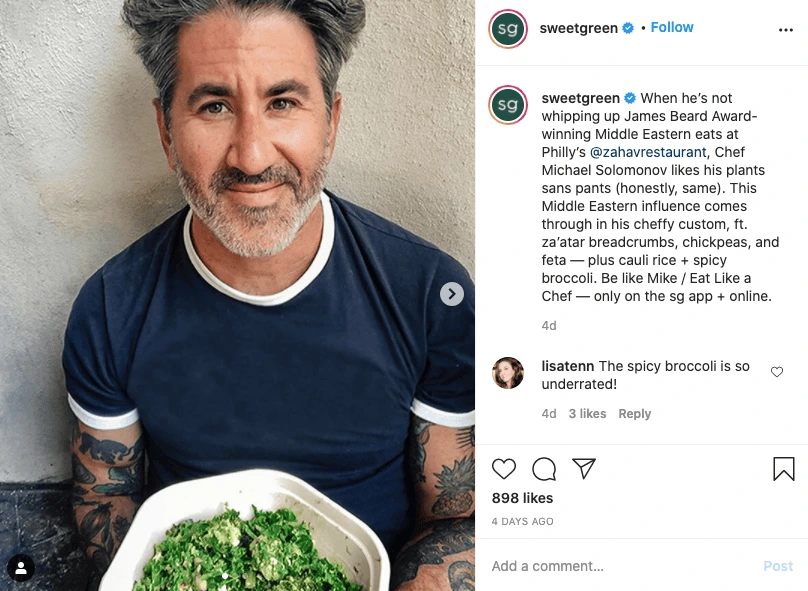
Source: Sweetgreen
Sweetgreen regularly posts content that features chef’s favorites from their restaurants. This does a few things:
- It offers social proof. It lets you know that experts in their field (chefs with highly refined taste buds!) frequent Sweetgreen, i.e. the food must be high quality and delicious.
- It satisfies curiosity. What are successful, talented people eating at Sweetgreen? Now you know.
- It’s far more interesting than a bland product-promotion post. Having someone else recommend your product and put their own spin on things helps spice up the content.
There are lots of different ways to feature endorsement-related content that will entice your followers. Brainstorm how you can use your current customer base to review, endorse or promote your products on Instagram.
2. Giveaways
Let’s be honest: Everyone loves free stuff.
It’s no secret that the word free is powerful, and many marketers use it in their copy to grab shoppers’ attention. That’s why samples and giveaways have become such a popular promotional tactic.
When you give away your product, you attract a larger audience of people willing to try your brand. It’s an opportunity to build brand awareness and encourage shoppers to try your product before buying it. Plus, it lowers the risk of trying something new.

Source: Retrospec
Take Retrospec, for example, who gave away a much-sought-after paddleboard to keep their followers interested and engaged.
Since people love free stuff, this type of post often goes viral, attracting more followers who want a chance to win. If you want everyone to feel like a winner, you can even offer a discount to all entrants.
One point of caution: Not everyone who enters your giveaway will be interested in your brand. While the engagement may be impressive, you’ll likely notice a drop in followers once the promotion is over. That’s okay—those who leave probably aren’t a good fit for your target audience, and the ones who are will stick around.
3. Lifestyle photos
If you’re trying to sell a service rather than a product, give lifestyle content a try.
When you create an atmosphere that resonates with your followers’ lifestyle (or desired lifestyle), your brand feels more authentic. Don’t focus on your service; focus on your potential customer.
For instance, Sotheby’s International Realty uses lifestyle photography to hint at what clients can expect from their services. But it’s not about selling real estate, it’s about selling the lifestyle — sophisticated, comfortable and luxurious.

Source: Sotheby’s International Realty
Lifestyle photos can help people imagine how they might feel after engaging with your brand. If that lifestyle speaks to their desires and sensibilities, this Instagram post idea can easily contribute to future business.
4. Inspirational quotes
We all have moments when we need to motivate ourselves. When you’re looking for a quick pick-me-up, the right inspirational quote can really lift your mood.
Even though inspirational content doesn’t always contribute directly to sales, it helps to illustrate your brand’s values. Plus, it has more potential to go viral, as people like to share content that reflects their own values, too.
Below, SoulCycle offers a thought that would be sure to make you pause if you saw it while scrolling through your feed. Short, relevant quotes like this can inspire your community.
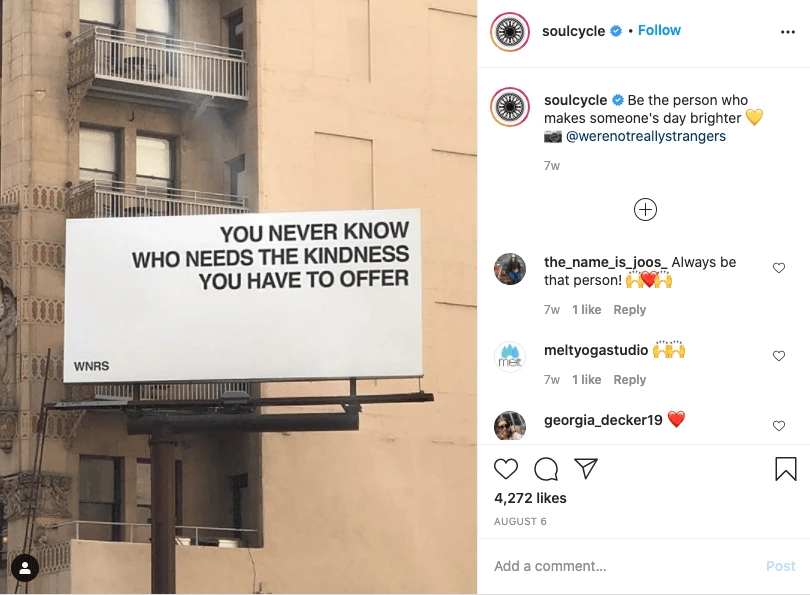
Source: SoulCycle
Sometimes less is more — and when it comes to Instagram, think first and foremost about fostering brand loyalty. If people draw inspiration from your brand, they won’t forget you.
5. Brand achievements
Your brand story matters to your customers, and so does your success.
When you share your brand’s achievements, you build trust and reinforce loyalty, which often leads to sales, support or donations. Reputation plays a big role when it comes to spending decisions, and your achievements prove that you’re a successful organization.
World Wildlife Fund often highlights its accomplishments on Instagram, showing its patrons and followers that their financial support is being put to good use. Content like this does double duty: It gives followers’ feeds a boost with good-news stories and it promotes the brand’s work.

Source: World Wildlife Fund
Achievement comes in many forms — brand development, product launches, customer growth, charitable initiatives — so keep your eyes open for opportunities to tell your story on Instagram. You might be surprised by how creatively you can visually represent your brand’s success.
Watch for ways to build trust and reinforce loyalty with your followers. Sharing your brand’s success will improve your reputation and impress potential customers.
6. Limited-time offers
As social creatures, it’s human nature to hate missing something important. Marketers should use FOMO (fear of missing out) to their advantage. One example is a limited-time sale, coupon or discount.
Take a look at Nékter. This franchise knows how to use sales to grab attention and encourage repeat purchases. How do they do it? Descriptive captions, a clear offer and bright, detailed photography all work together to deliver a compelling offer.
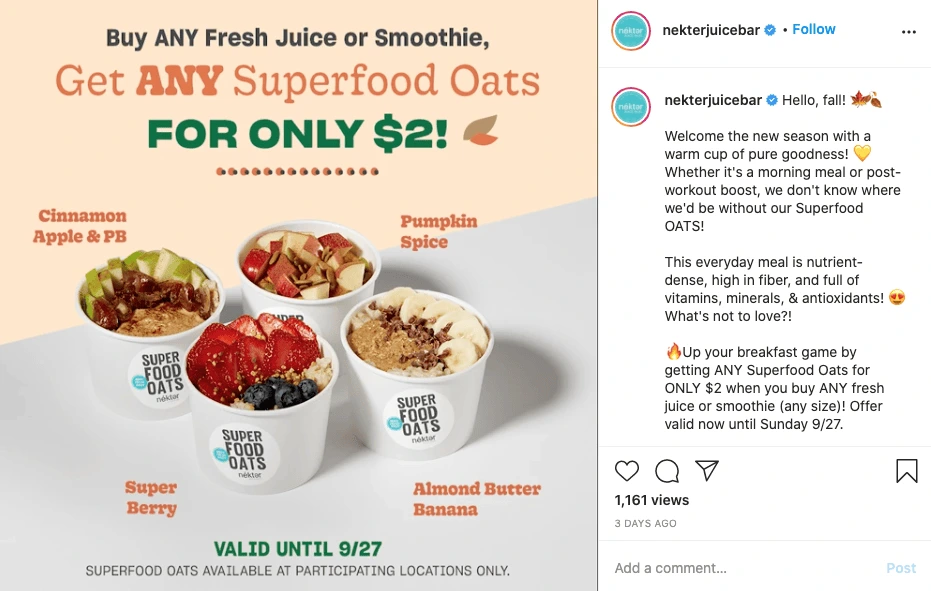
Source: Nékter Juice Bar
Nothing delays action more than uncertainty. Run your sales for a short period of time to give your followers a clear understanding of when and how they should act. If you run sales all the time, your audience will adjust and expect discounts continuously. Instead, make them feel like they’re getting a real deal by purchasing now.
Use compelling visuals to announce your offer, then provide followers with a clear deadline to increase urgency.
Key takeaway
Over the past few years, Instagram has evolved into a powerful marketing platform that gives brands new opportunities to boost sales. Investing in the right kinds of Instagram post ideas is a strategic way to influence the buying process.
Qualifying a lead is a multi-step process, and on average, it takes a minimum of six to eight touches. During this time, sales reps evaluate a prospect across four important aspects: budget, authority, need and timeframe (BANT). A prospect who checks all these vital criteria is deemed worthy of persuasion.
Related: 7 types of sales collateral that convert
And this is merely the beginning of the sales process. Once a lead has been qualified, they move through four stages of engagement before being converted into paying customers. These stages are popularly called AIDA: awareness, interest, decision and action. There’s also a fifth step (satisfaction) which happens after the transaction is complete.
Creating awareness, generating interest and building a desire to buy does not come easy. To build a successful sales team, it’s important to not only train your sales team but also equip them with sales enablement content that can trigger the right response from a lead. []
Identify the assets required
The first step in the process of creating sales enablement content is building a requirements sheet. Salespeople require a unique list of assets at each stage of the sales process. For instance, assets presented during the Awareness stage would mostly deal with information about your business, the founders, investors, products and services, and so on. In the Interest stage, assets mostly deal with product demonstrations. Decision is generated through testimonials and peer reviews that validate your legitimacy and remove any hurdles that prevent your lead from converting.
Types of sales enablement content to consider:
- Explainer videos
- Ebooks
- Webinar recordings
- One-pagers
- Product demos
- White papers
- Case studies
- Customer testimonials
- Blog articles
Once you identify the objectives of each of the different stages of the sales process, building assets to fit your agenda becomes easy.
Create sales enablement content assets
The success of the content creation process is determined by how engaged your customers are during sales outreach. A tool like Lucidpress streamlines the creation of various content assets — like brochures, sales proposals and case studies — with consistent branding. You might also create interactive content like videos and slideshows that are proven to offer high engagement and message retention among viewers.
The question, however, is what kind of content you must create to build better engagement for your brand. Here are a few tips to take note of.
Sales and content marketing need to work together on sales enablement
Sales enablement is a joint effort between the sales and marketing teams. To create the most effective content, marketing needs to be in tune with sales and understand what types of collateral they need most.
Getting together on a regular basis (may we suggest a monthly sync?) to chat about aligning goals will ensure that sales is clear about what they need and that they’re not missing out on any content that’s already available and could be useful for their prospects.
Measure client dropout rate
In any sales process, only a small fraction of the qualified leads you reach out to eventually become paying customers. The rest of the leads drop out at various stages of sales. Identify the dropout rate at each stage of the sales process. The stage where the most clients choose to part ways is the one where your content needs more attention.
You don’t have to use your existing sales enablement content as a benchmark if you don’t want to. In fact, it’s fine to start from scratch to build new content. Hold an internal meeting with all stakeholders (sales, marketing, and product managers) to build a list of features and ideas that could deliver maximum value. This brainstorming session could also include benchmarking your content against the competition’s. This will give your team a good idea of what’s missing and how your content could be made more engaging for prospective customers.
Build a sales enablement content library
The next step is to translate the ideas from your team meetings into actual assets. It’s worth remembering that too much information can clutter your sales deck, so new assets should be organized into a content library instead.
If you plan to use content management or knowledge management tools to handle this, make sure you pick a service that features a “learning path” or curriculum. This will help you organize your content into distinct folders for every stage of the sales cycle, which can be handy during the testing process. As we’ll see in the next steps, it’s vital to experiment with various combinations of content assets and compare the conversion rates.
Make content customizable
If you need to really make the most of your sales enablement content — and who doesn’t? — you’d do well to invest your energy in making templates. Templated content allows anyone to create a customized piece of collateral to meet their specific prospect’s needs.
Instead of a sales rep making a content request from the creative team, they’d simply pull from a library of sales enablement templates that had been designed for this purpose. They’d find a template for a brochure, or whatever piece they need, and then fill in customizable text and image fields to make it personalized for their prospect.
Templated design saves both the sales and marketing teams time, and it can make sure content is as targeted and effective as possible.
Multivariate testing
The next step is to test the effectiveness of your content assets on the conversion rate. The ideal way to do this is to build a handful of different content assets that could be pitched to clients in the same stage of the sales process. For instance, one deck could focus on charts and graphs, while another could use videos and interactive graphics to sell the product.
Make sure that every sales rep pitches at least one client with each of the various assets. Have the performance metrics of the original deck in hand before carrying out this experiment.
At the end of this stage, build an aggregated report of how each of your content assets performed and how they all compare against the original deck.
Secondary multivariate testing
Once you’ve identified the content that performs best from among those tested, the next step is to experiment with more assets of the same kind. For instance, if videos and interactive graphics worked best, then you could work on creating new decks that feature such content. The idea is to find the sweet spot that maximizes engagement and conversion. Once you have a handful of different assets ready, experiment one more time with a new bunch of leads to find the highest performing content deck.
Rinse and repeat
Creating highly engaging sales enablement content is a never-ending process. Once the best performing deck has been identified, the next step would be to look at other stages of the sales cycle where dropout rates are high and repeating the process. Doing this for each of the sales stages will help build a content library that converts higher than ever before.